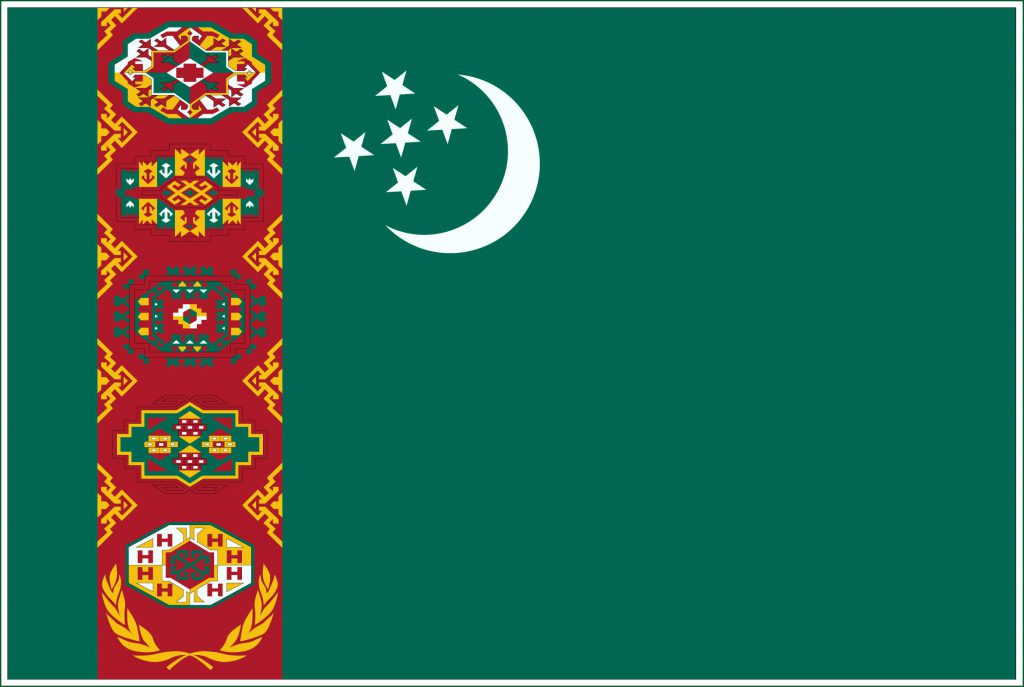
To Konya Urgench & Darwaza, Turkmenistan – Oct. 5
ElderTreks brochure: Today we will enter Turkmenistan through the border crossing of Dashoguz. This day will be dedicated to exploring the UNESCO World Heritage site of Konye Urgench. Although destroyed over 800 years ago by Ghengis Khan there are still many ruins to see today, including Central Asia’s tallest brick minaret. Afterwards we drive southwards through the Karakum Desert to Darwaza and the giant gas crater, popularly known as “Gateway to Hell”. We will arrive at Darwaza around sunset where we will set up our camp and have dinner under the stars. Overnight in dome tents.
Leaving Uzbekistan went quickly with no searching through our bags. My painting made it through. I’m beginning to feel a little disappointed no one has wanted to “confiscate” it! They don’t even look in my carry-bag.
Entering Turkmenistan, we had a bus that took us from Uzbekistan border through no-mans-land to Turkmenistan’s entry point and we didn’t need to do that mile and a half walk across very rough ground. Trish joked that we were disappointed as I’d been training all summer, ever since getting my knee replaced at the end of July!
The military and staff at immigration and security were pleasant and businesslike, the government is doing a great job with their training. There was about an hour’s wait until the process started, then it went quickly. All the horror stories we’d read on the internet didn’t happen to us.
We piled into five Toyota Land Cruisers, stopping at Konye Urgench to explore around and walk to the minaret, then lunch on the way to the Karakum Desert, which covers almost three-quarters of Turkmenistan.
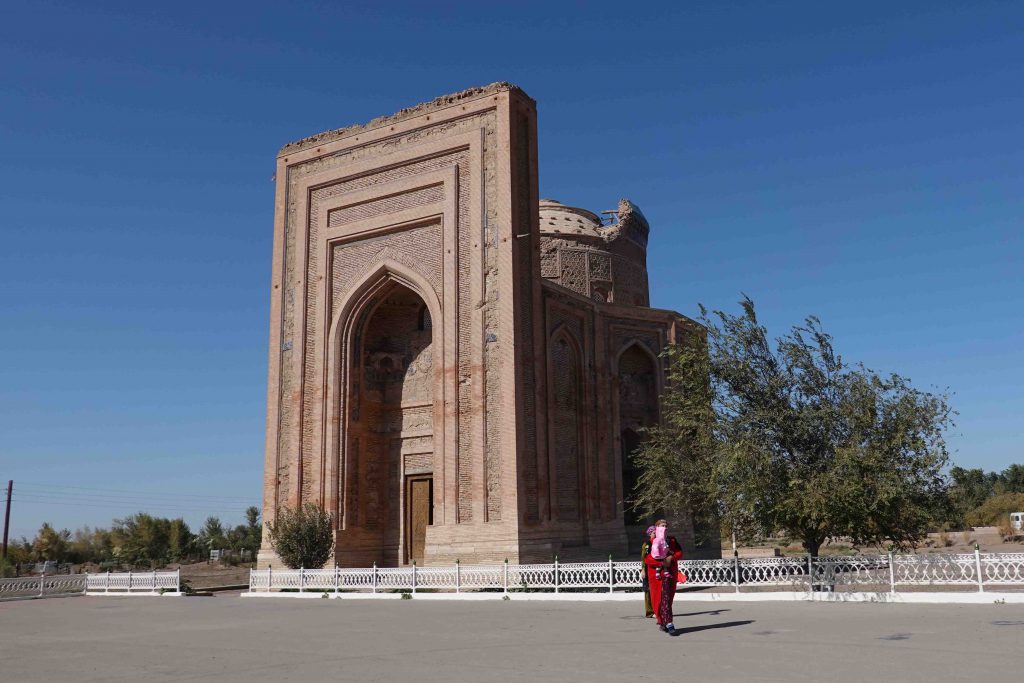
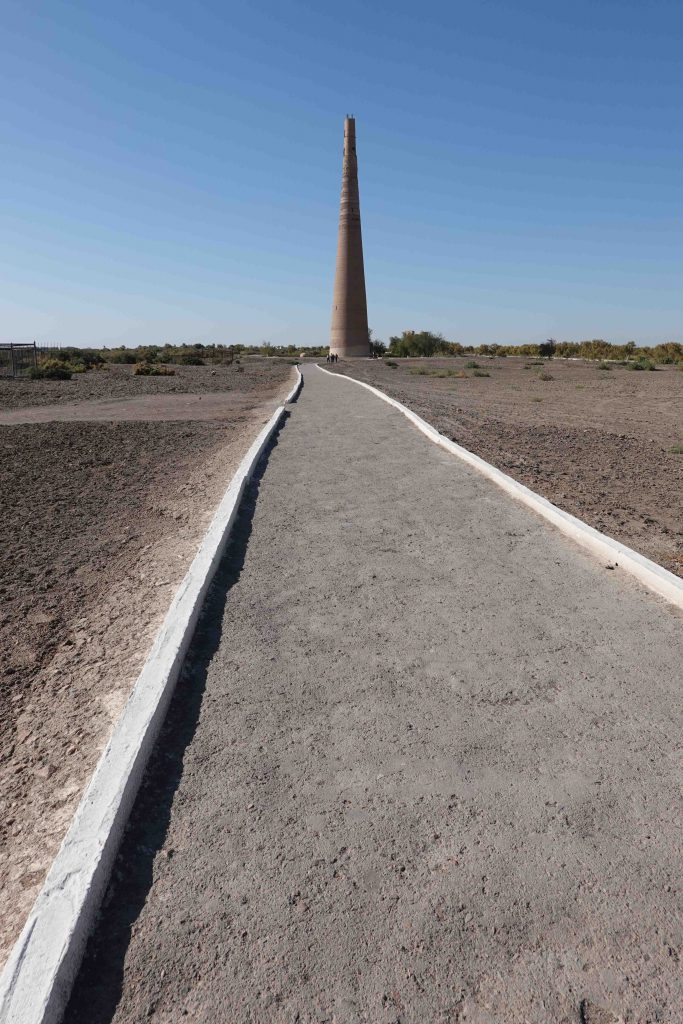
Arrived at Darwaza Gas Crater 6:30-ish. What a nice surprise, instead of tiny crawl-in tents, we all were in their new yurts, Roger was very pleased. They are very nice. There are also, now, proper toilets that flush and are clean. We were expecting to have to go behind a sandhill (or rather, sand bump).
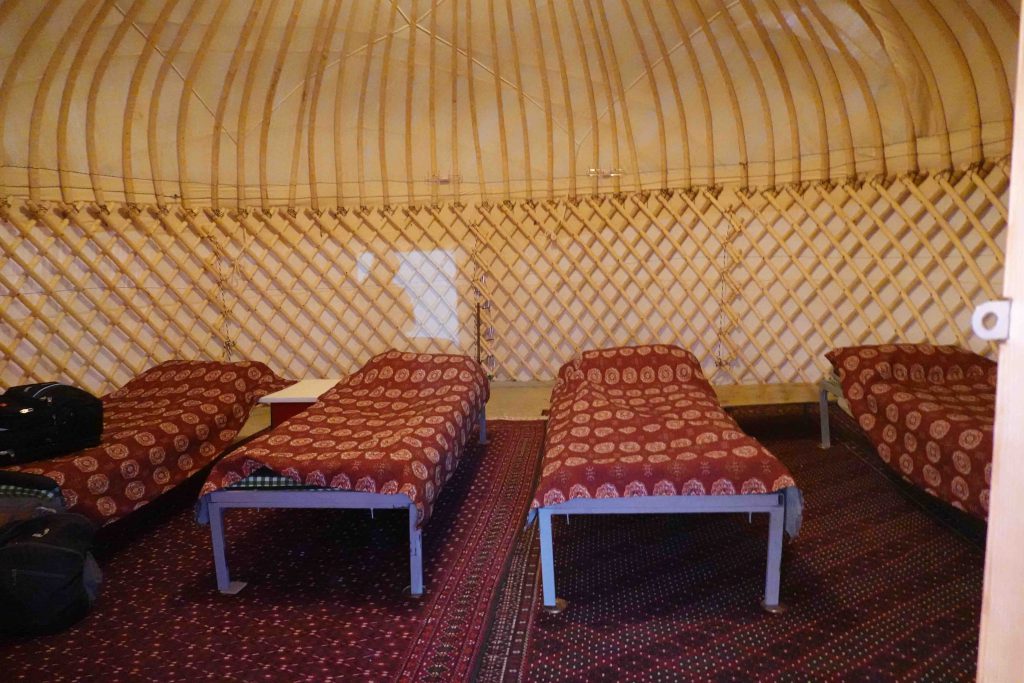
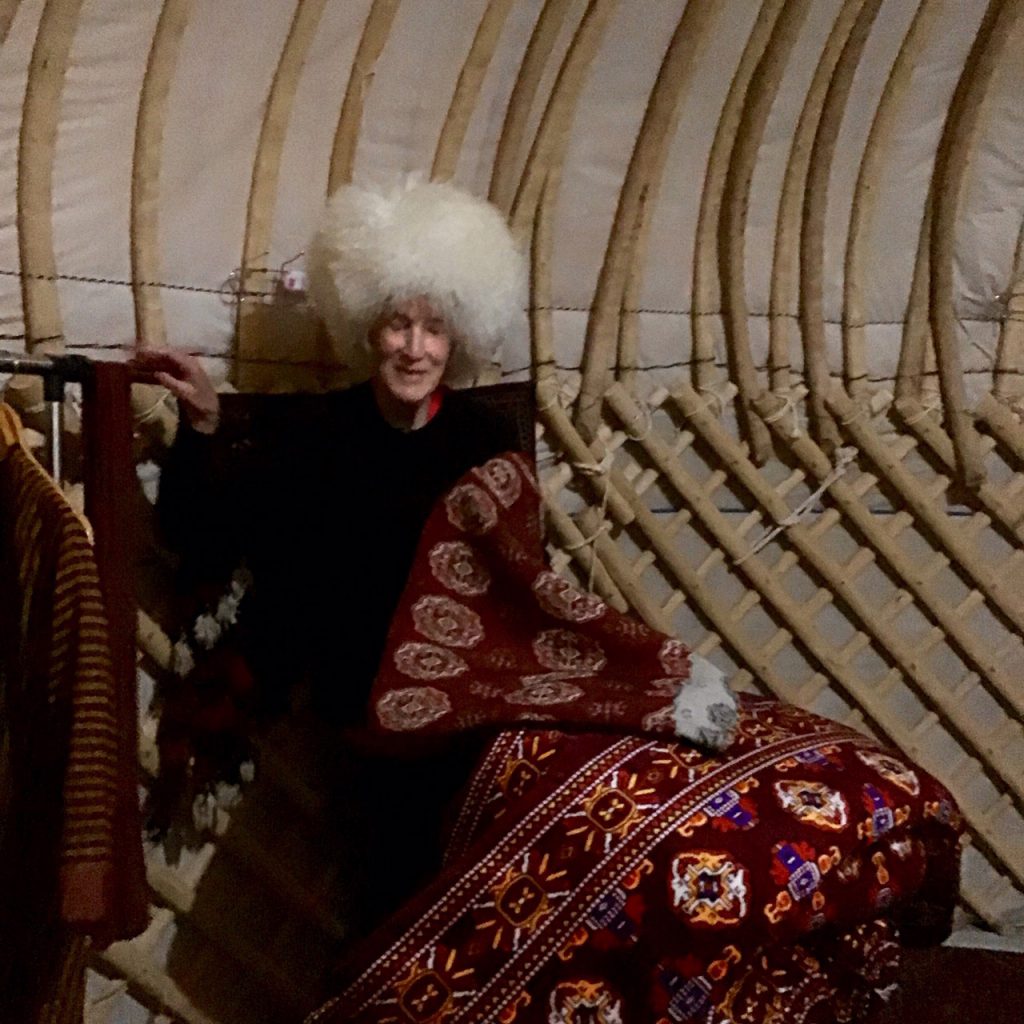
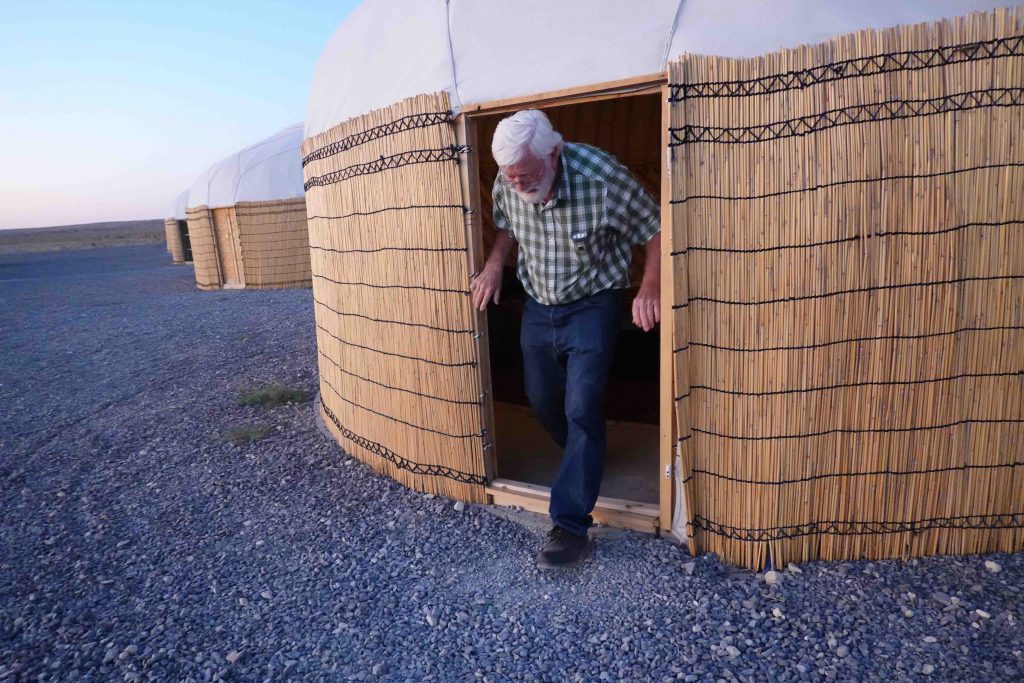
There are a couple of camels across the lot from our yurt.
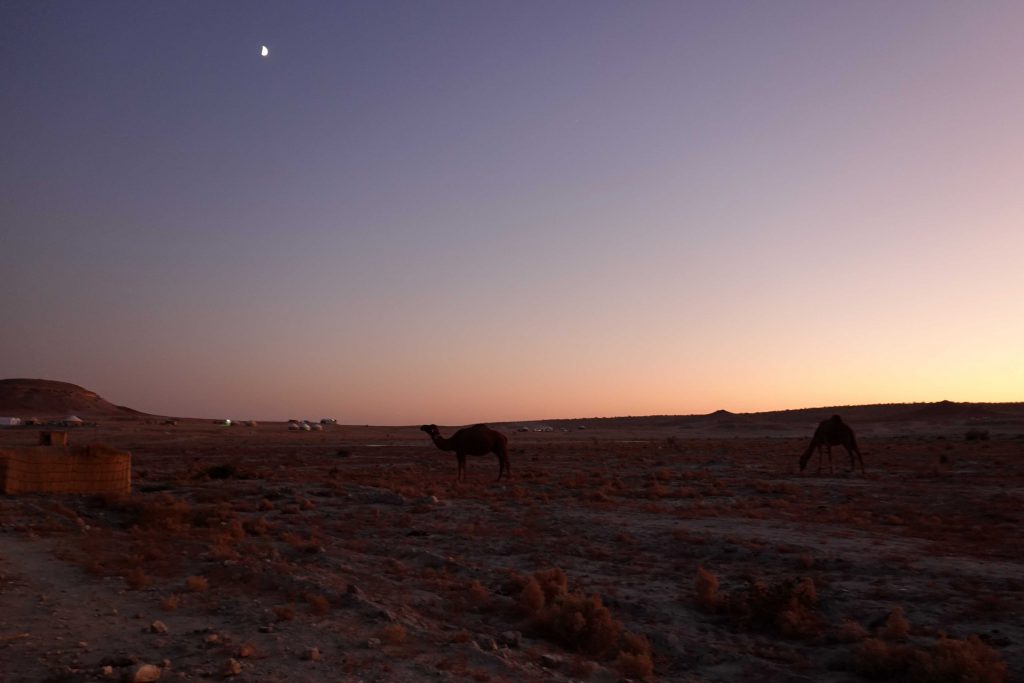
Dinner was at 7:15, then a six or seven minute walk to the crater, all bundled up against the cold and carrying our cameras and flashlights. Here in the middle of the desert with just a half-moon, the darkness was almost total away from any source of light.
The crater is impressive and looks much, much more spectacular than film or photos show. Surprisingly, it smelled nice, like burning leaves in the autumn. It’s big, takes about 10 minutes to walk around it.
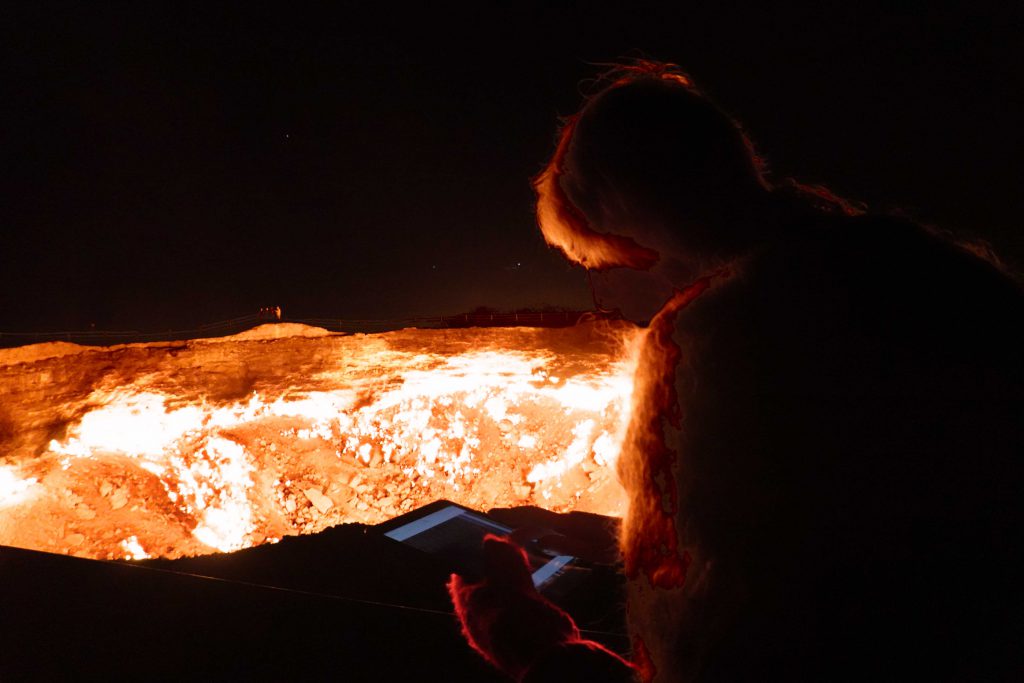
This ginormous crater was not formed by nature but accidentally by us humans. There are several versions of what happened but they all pretty much boil down to: in 1971, Soviet geologists were looking for oil, they dug a hole, there was an explosion which created a crater giving off poisonous methane. To prevent it from reaching nearby villages, they set fire to the gas and returned a few days later expecting it to be extinguished–today, almost 50 years later, the flames are still going! There are in fact three craters in the group, the other two bubble with mud and water. We’ll see those tomorrow.
I’m sitting on the end of one of the cot beds writing this last entry for the day and can hear one of the camels groaning, moaning and complaining. It’s very cold, now. I’m going to crawl into my cot in all my clothes, coat and wooly hat as well, and get warm under the covers.
To Ashgabat – Oct. 6
ElderTreks brochure: This morning we drive through the Karakum Desert to Ashgabat. At nearly 350,000 sq. km in total area or about 79 per cent of Turkmenistan’s territory, Karakum means “black sand”. If you look carefully, at sunset and sunrise, you can see a dark grey glow over the sand which distinguishes it from other desert sands. After lunch in Ashgabat, we visit the National Museum. The museum houses around 500,000 artifacts from archaeology, ethnography, carpets, national costumes and fabrics, musical instruments, weapons, jewellery and artwork. Overnight in Ashgabat: Hotel Nusay.
Was a very, very, very cold night. I was surprised this morning the bottled water in our yurt wasn’t frozen.
There were four single cots in our yurt, all fully made up with a pillow, sleeping bag and a blanket. Leroy and I raided the other two beds for the extra covers, me right away and Leroy during the night. Was glad I’d packed a cardigan, long johns and outer jacket–wore them all to bed, as well as my fleece jacket, hat and gloves!
Trish went back out to the crater before sunrise:
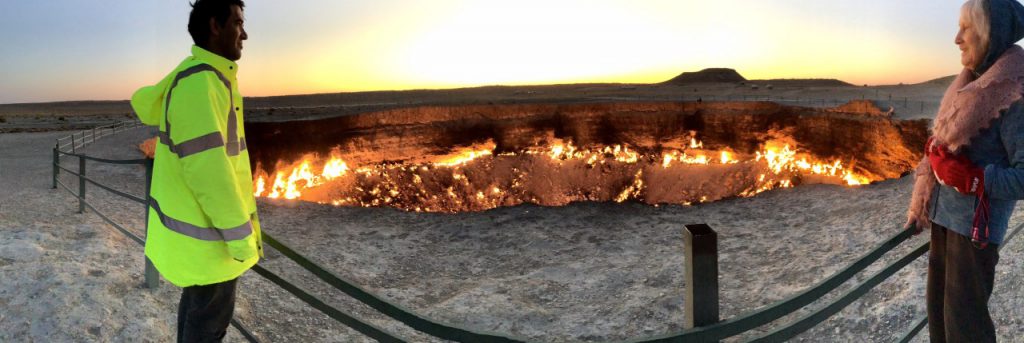
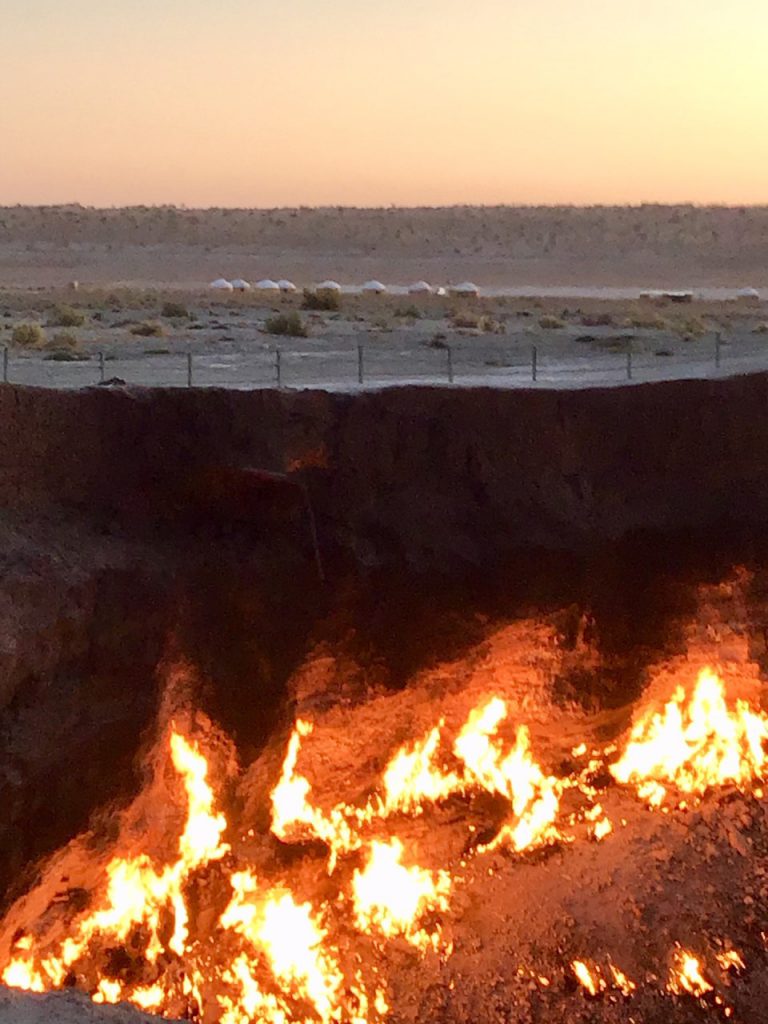
After breakfast, we walked out for a last look at the gas crater and its flames. Then we drove to the mud crater, it has a few burning patches (only set alight in 2012) and got its name from the bubbling mud which was audible, like a bubbling pot. After that, the water crater, a crater of murky water still actively bubbling from gas leaks.
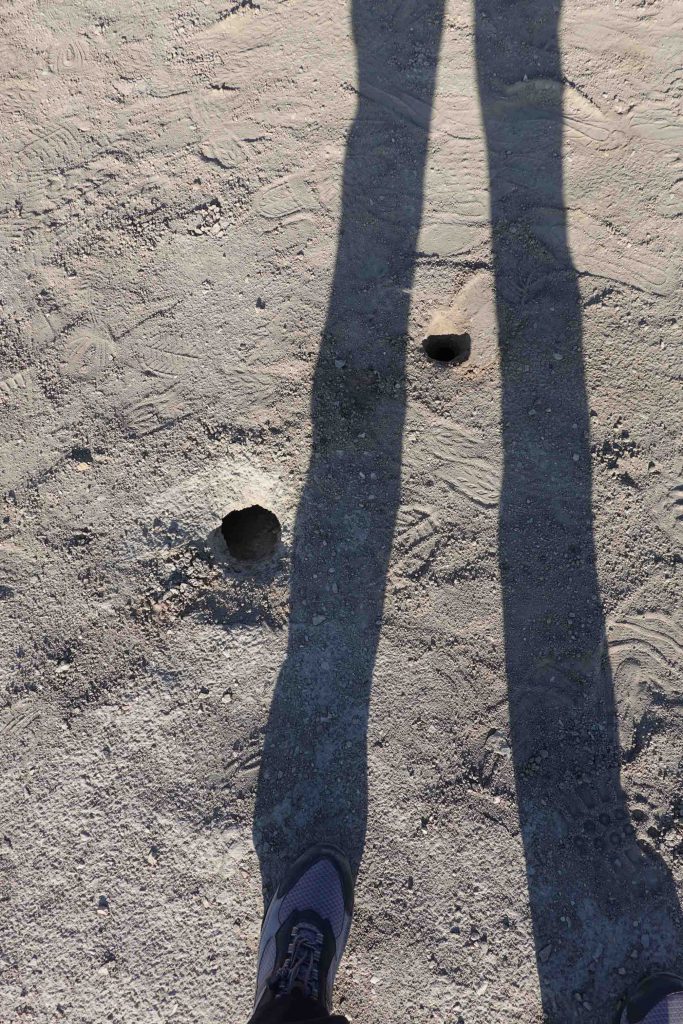
The black spots on ground are vent holes for the mud crater.
So glad we got to see this spectacular flaming crater and camp overnight here; a real highlight of the trip.
When we were almost to Ashgabat, we changed from the four-wheel drive cars to a full-sized coach. The reason for this is because dirty vehicles are illegal in the city, and ours certainly were after all the traveling.
Lunch was at Sultan Restaurant and was one of our better ones, including freshly baked bread, which I really like. Along with chicken, part of the main dish was a bread roll filled with cheese, not what is just showing in this photo, but all the way to the pointy ends.
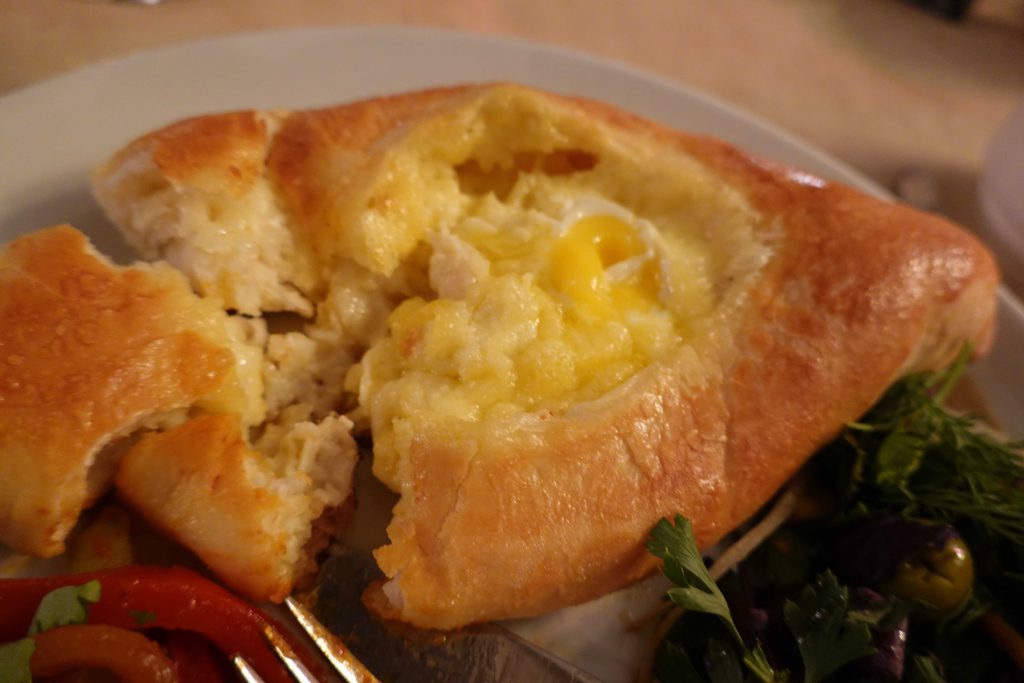
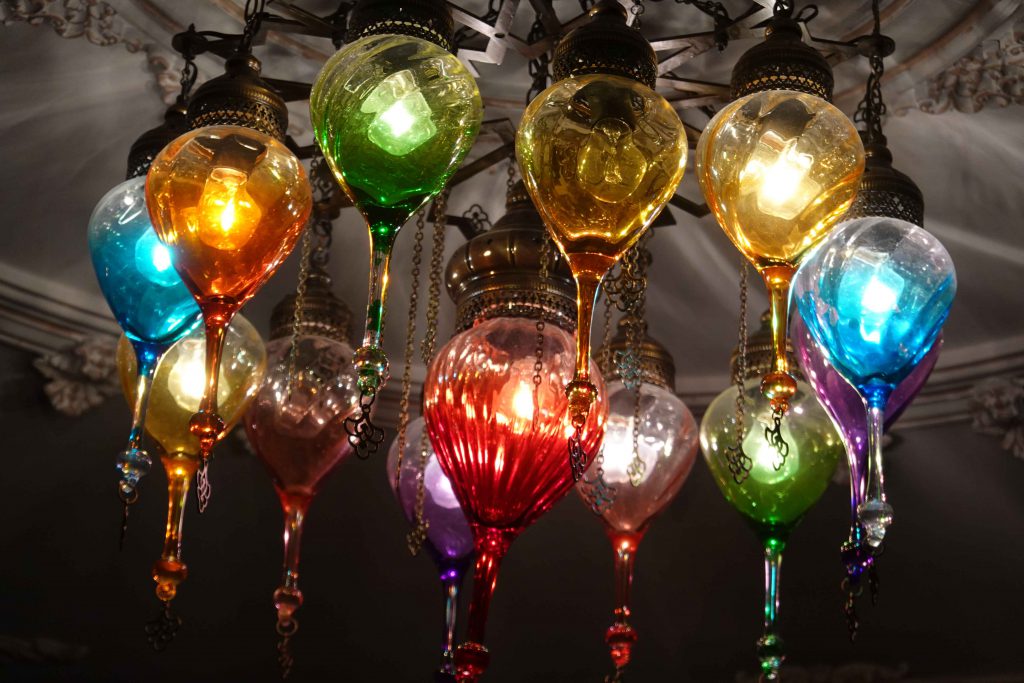
After checking in to our hotel and an hour’s rest, we took a driving tour of the city, ending up at the Russian Market. It has a different name, now, but everyone still calls it the Russian Market.
Ashgabat is a beautiful, clean city, white marble and gold accents. Shame we are not allow to take photos of the area around the hotel–where the President lives is just across the road–as it is the best looking of all with lovely buildings, beautifully lit at night.
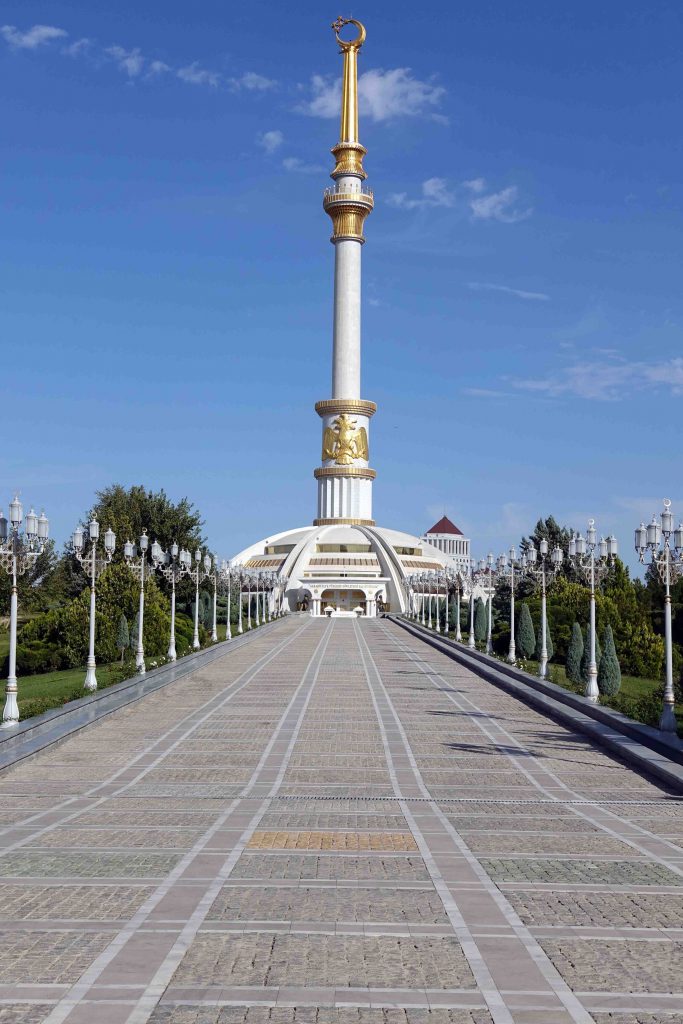
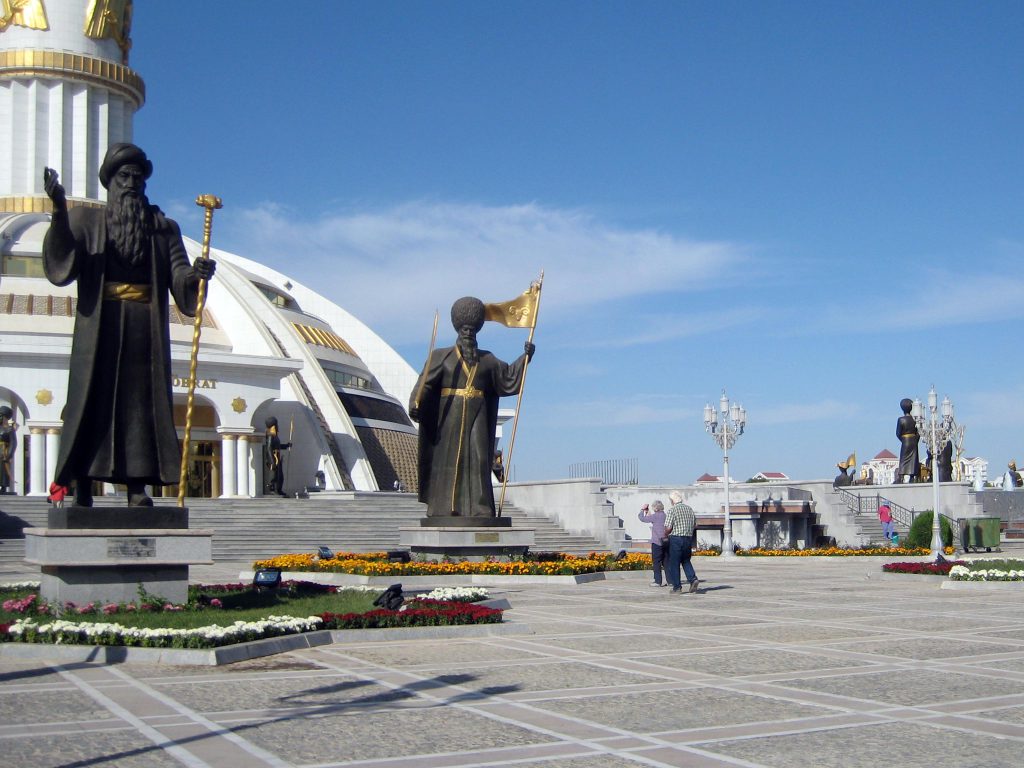
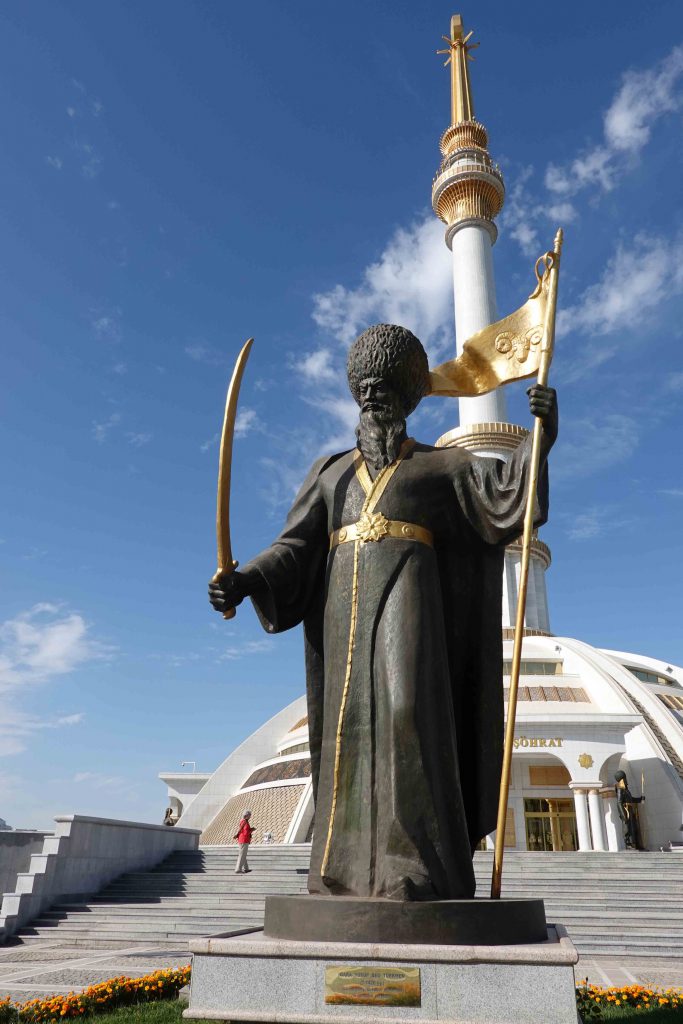
The parts of the city we saw today are rather like one of those movies where someone wakes up and everyone else is gone. Elaina, our guide, told us that there are common areas and playgrounds for the children off the street behind the buildings and, because it is so hot in summer and cold in winter, a great deal of life is conducted underground. In the evening, when the temperature drops, people will go out to the parks and elsewhere. In winter, families will go to the parks to throw snowballs at each other.
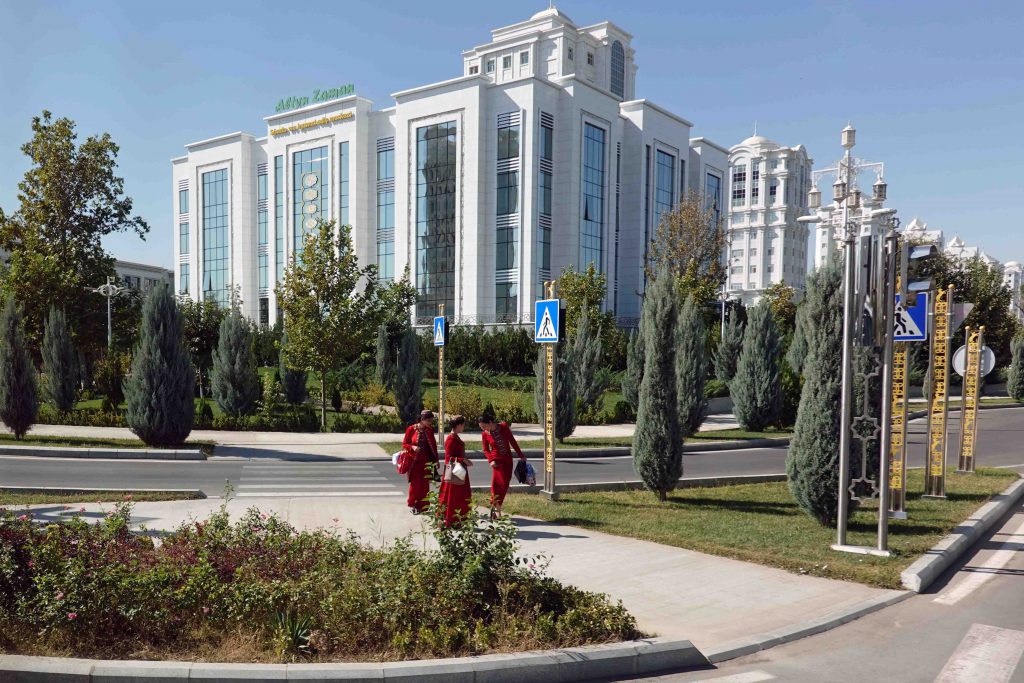
School girls in school uniform
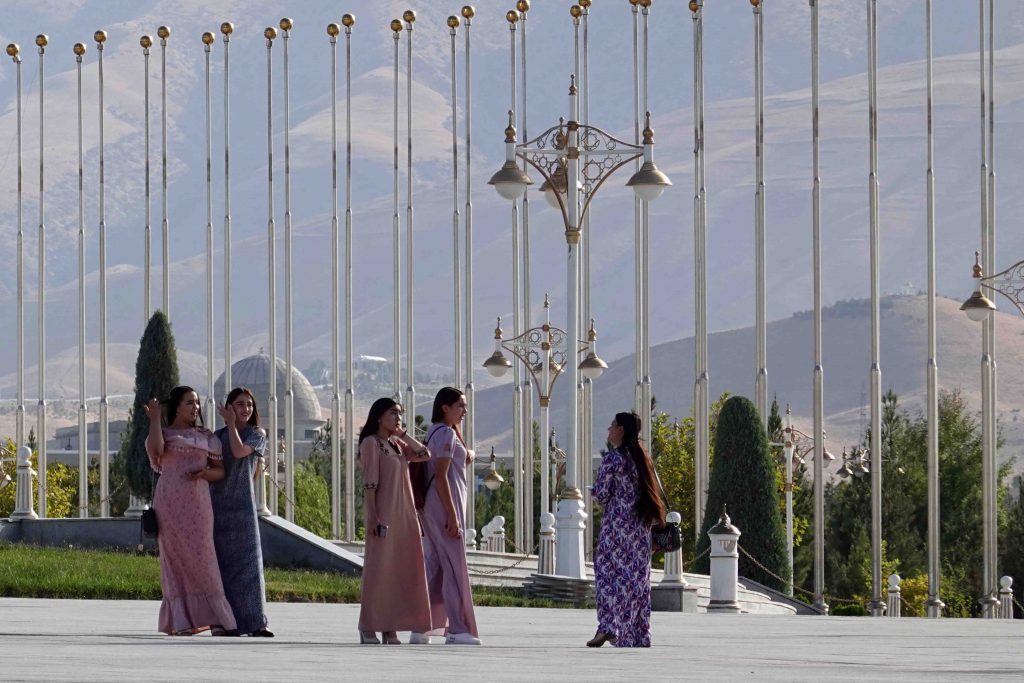
Women in traditional dresses, their heads are uncovered which means they aren’t married.
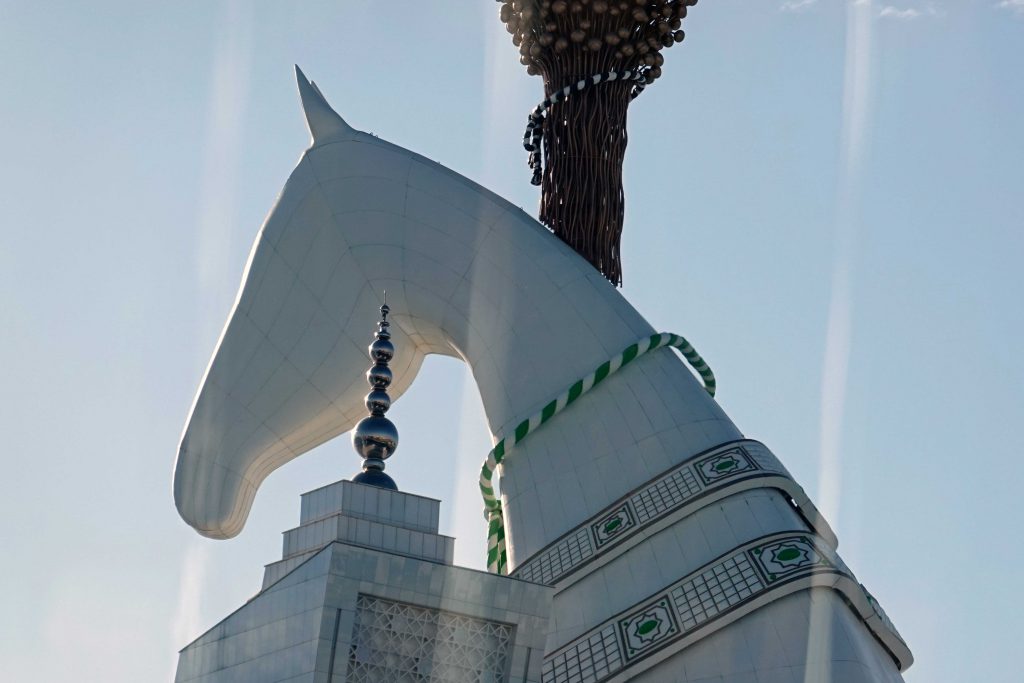
Horse statue, Olympic Complex, from bus
This evening we went to a place called the Golden Sycamore. Veggies and skewers of meat were grilled at the table, it was fun and delicious.
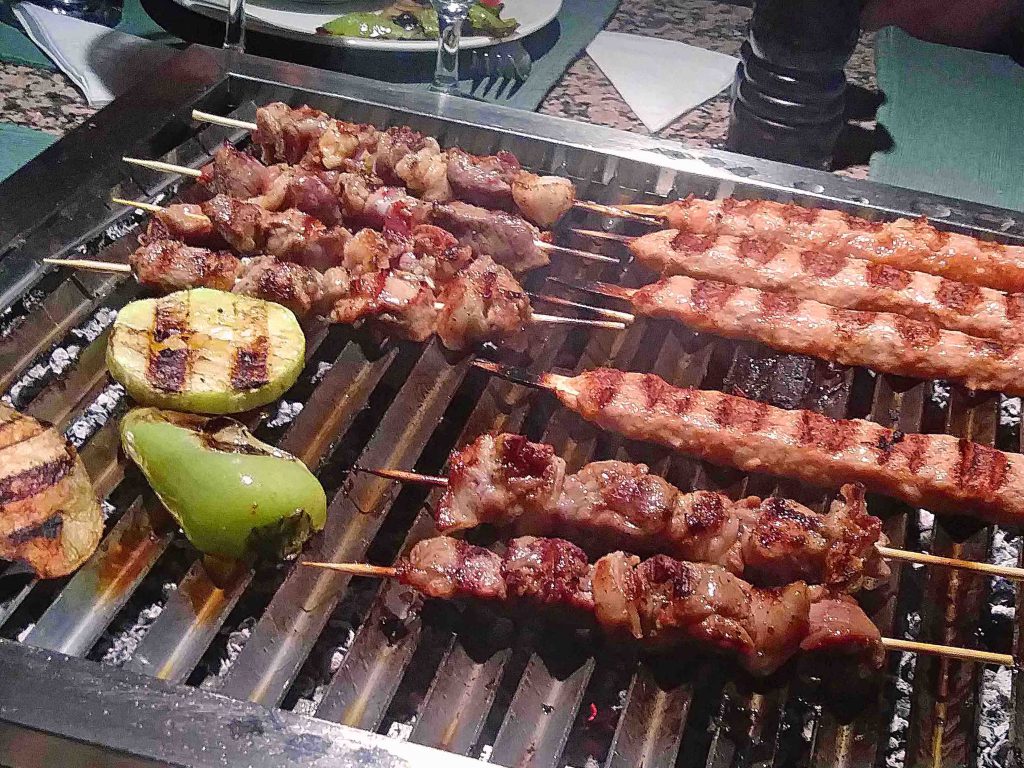
Ashgabat – Oct. 7
ElderTreks brochure: We start today with a visit to the Russian Bazaar, one of the oldest in Ashgabat. Just outside of Ashgabat, we visit the archaeological site of Nissa which contains the remains of Old and New Nissa. The original fortified city was an important center in the early days of the Parthian Empire, and existed from 300 BC to 300 AD. Nissa was a royal residence of Parthian rulers with a palace, a fire temple and a treasury. Recent archaeological excavations have uncovered 2700 texts inscribed with black paint on clay vessel fragments. We continue on to Kipchak Village to visit the largest mosque in Central Asia. Overnight in Ashgabat, Nusay Hotel.
First thing we drove out to Nisa, the capital of Parthians. Very peaceful looking from a distance as we arrived.
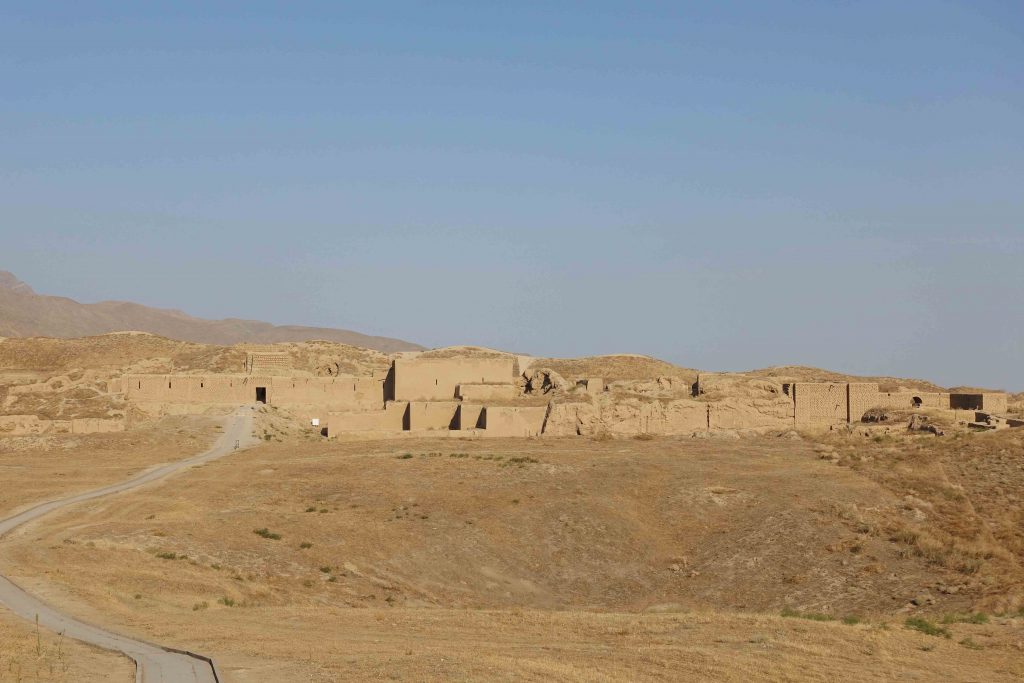
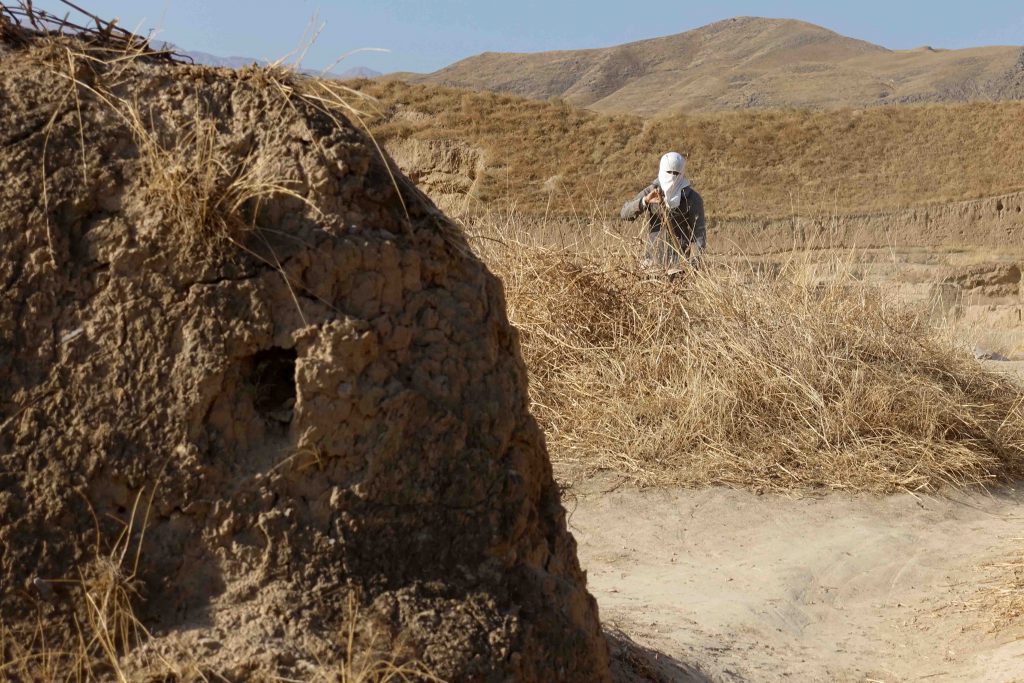
Back to Ashgabat and the National Museum:
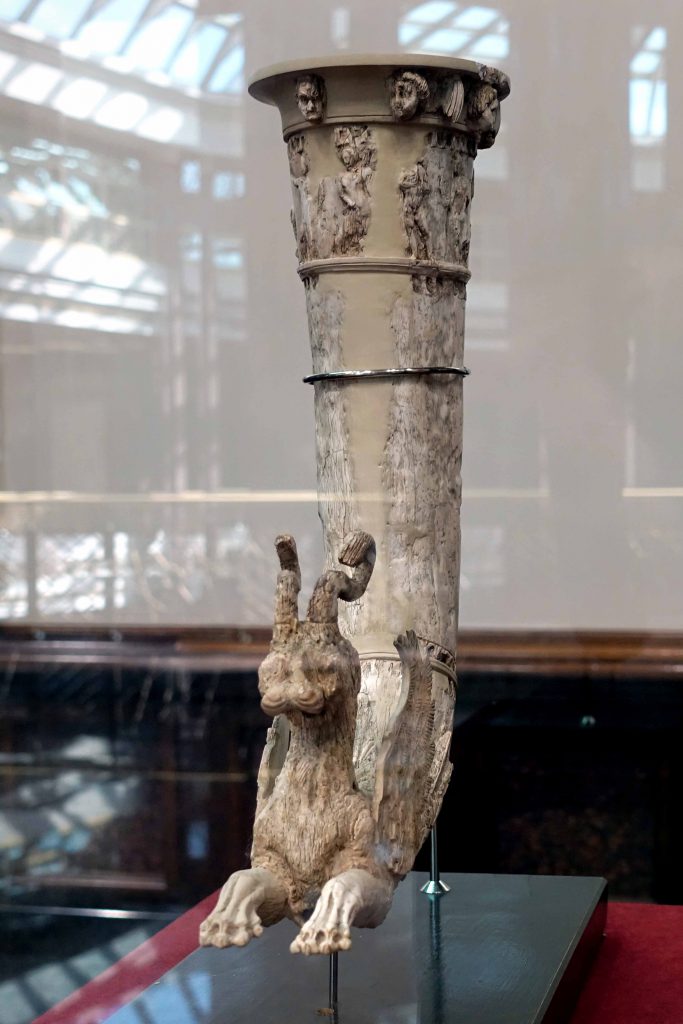
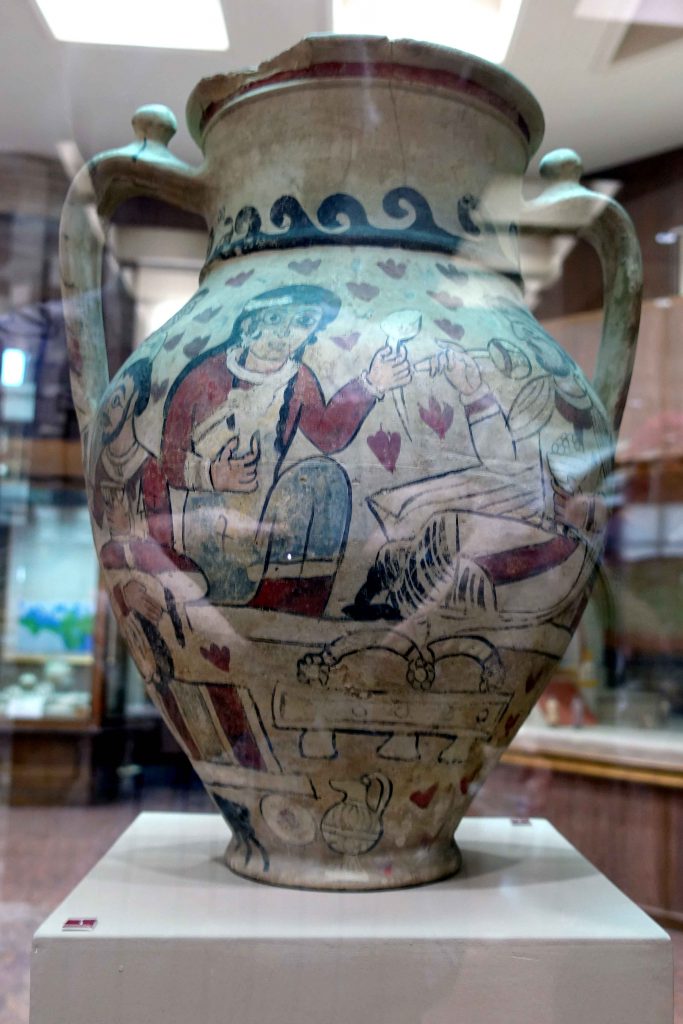
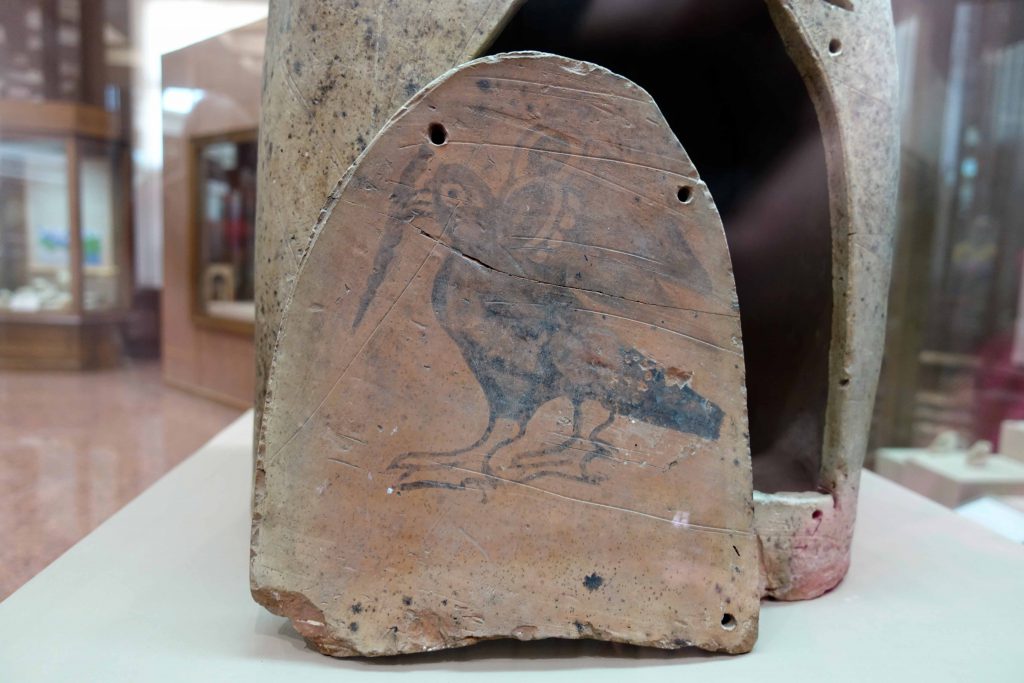
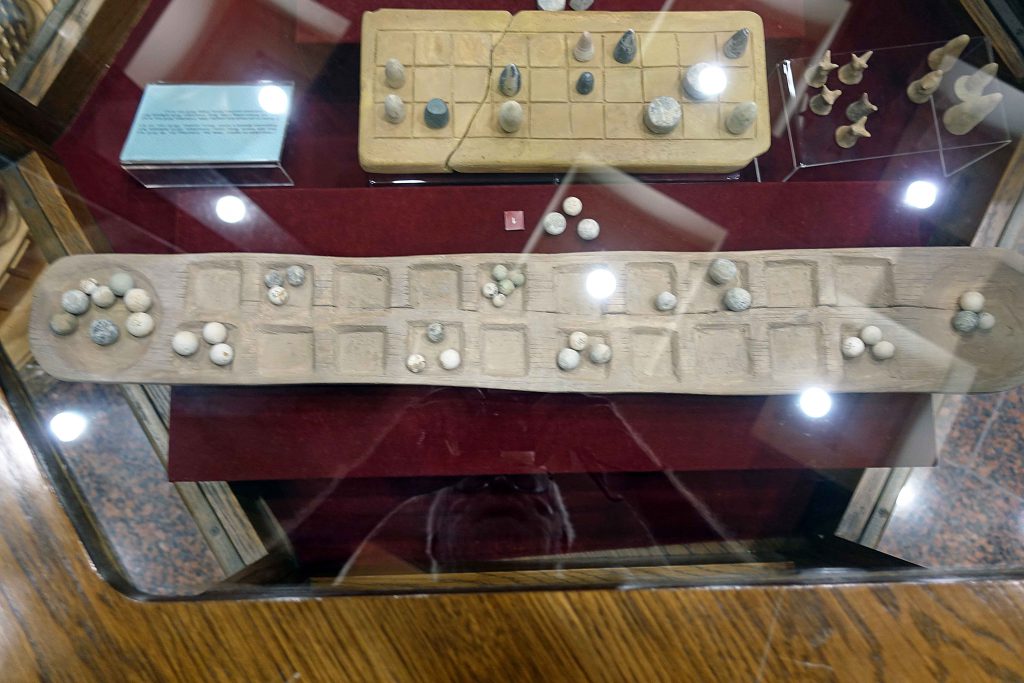
Lunch at Happy Place/wedding place, tasty ice cream bar for dessert.
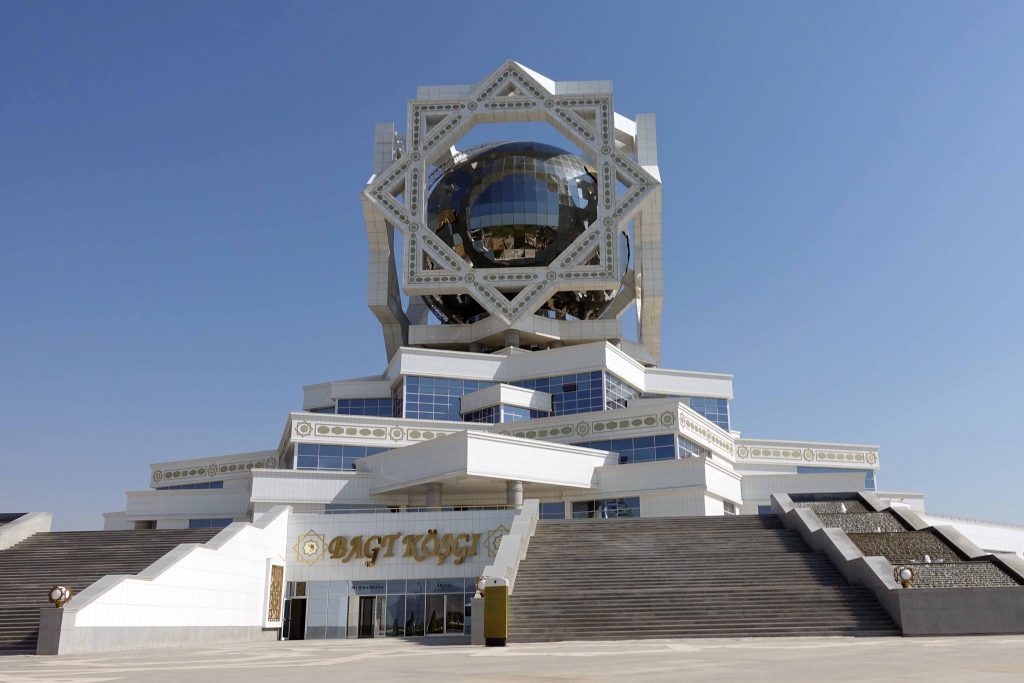
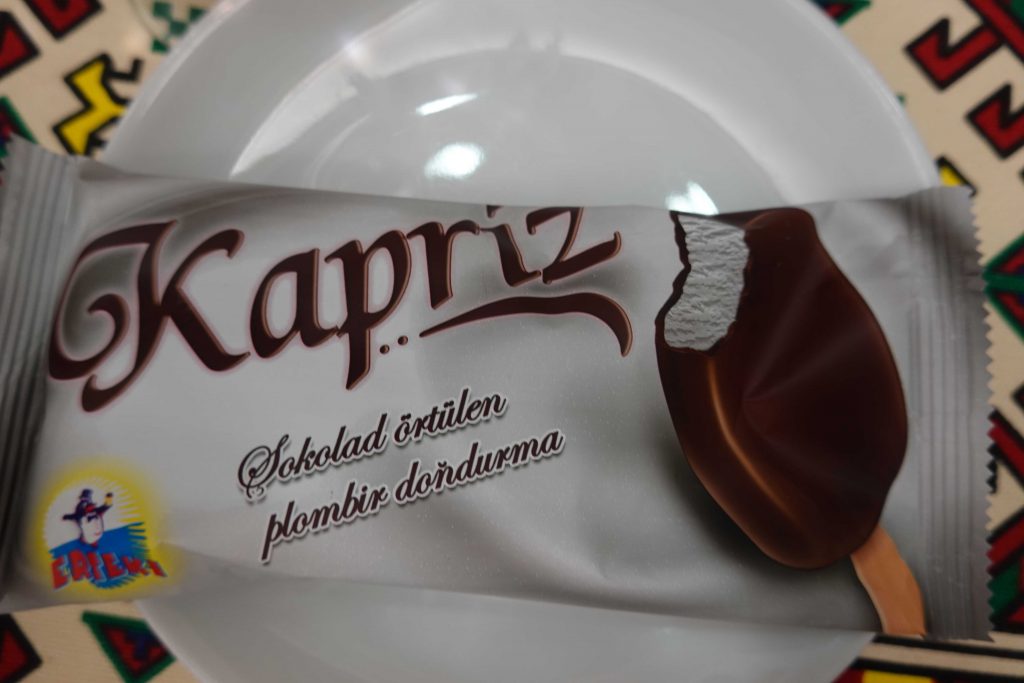
We were supposed to go to the Akhalteke private horse farm at the end of the trip but they’d inadvertently double-booked for that date and we went today instead.
Akhalteke horses got their name from the Akhal oasis in the center of Turkmenistan, the home of the Teke tribe. These horses have enormous stamina and can withstand the harsh climate with its extremes of temperature.
When Russians arrived, they slaughtered them:
“Prior to the Russian occupation of 1917, nearly every Turkmen family owned at least one or two horses. With Bolshevism however, came an end to private ownership and the horses were placed in state-owned stud farms. When it was then decreed that the horses in the stud farms were to be slaughtered for food, breeders released them into the desert, their natural habitat, thereby preventing what may have resulted in the annihilation of the akhalteke breed within the borders of Turkmenistan.” http://ahalteke.net/
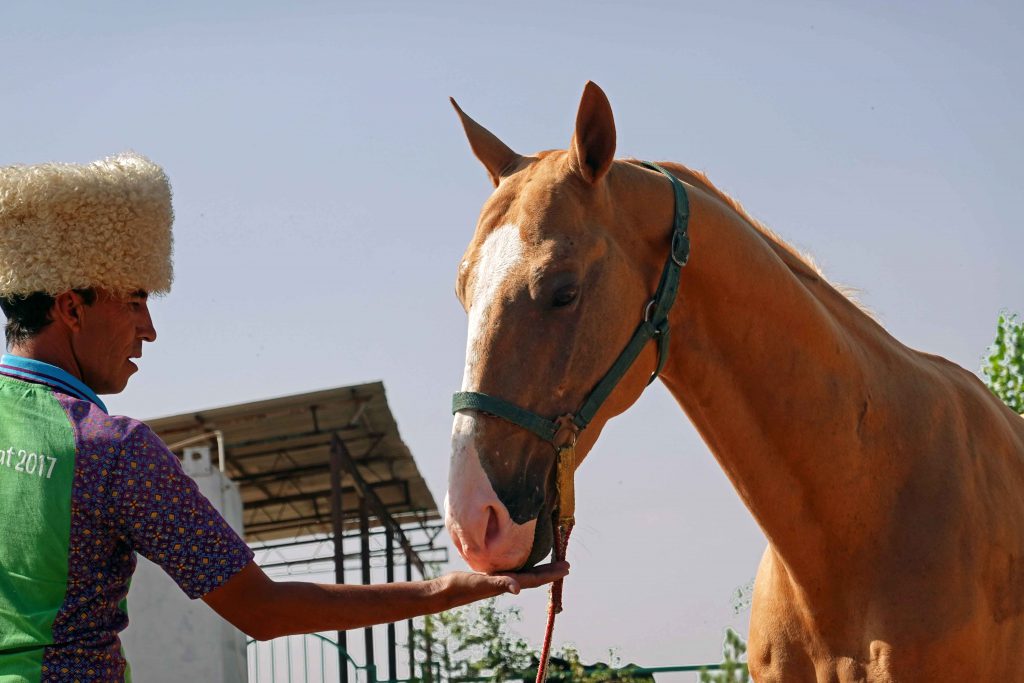
“Approximately 10,000 years ago, as desertification took hold of Central Asia … Longer necks, a higher head carriage, larger eyes and longer ears evolved to better the horse’s ability to see, smell, and hear predators over the increasingly open plains. The golden coloring predominant among the akhalteke provided the necessary camouflage against the desert landscape.” http://ahalteke.net/
The white one is 30 years old and has a genetic sway back.
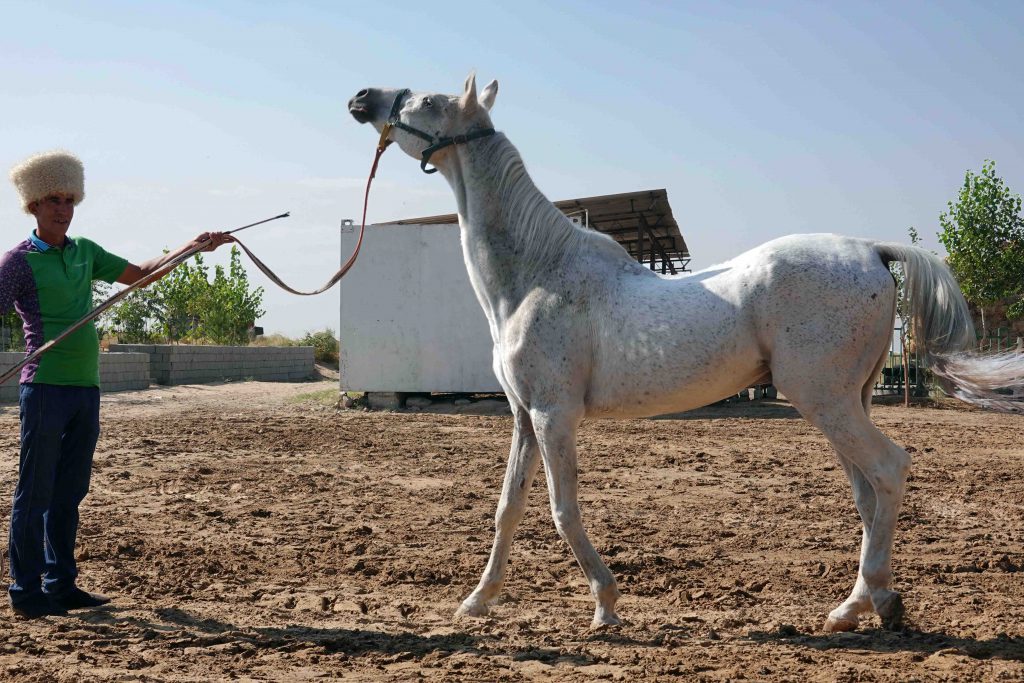
“Bucephalus, the favorite horse of Alexander the Great, was an Akhalteke …..The Akhal-Teke descended from the ancient Turkmenian horse which was one of the four original horse “types” that cross the Bering Strait from America in prehistoric times.” http://ahalteke.net/
When we arrived they were baking bread in the traditional oven for us to enjoy.
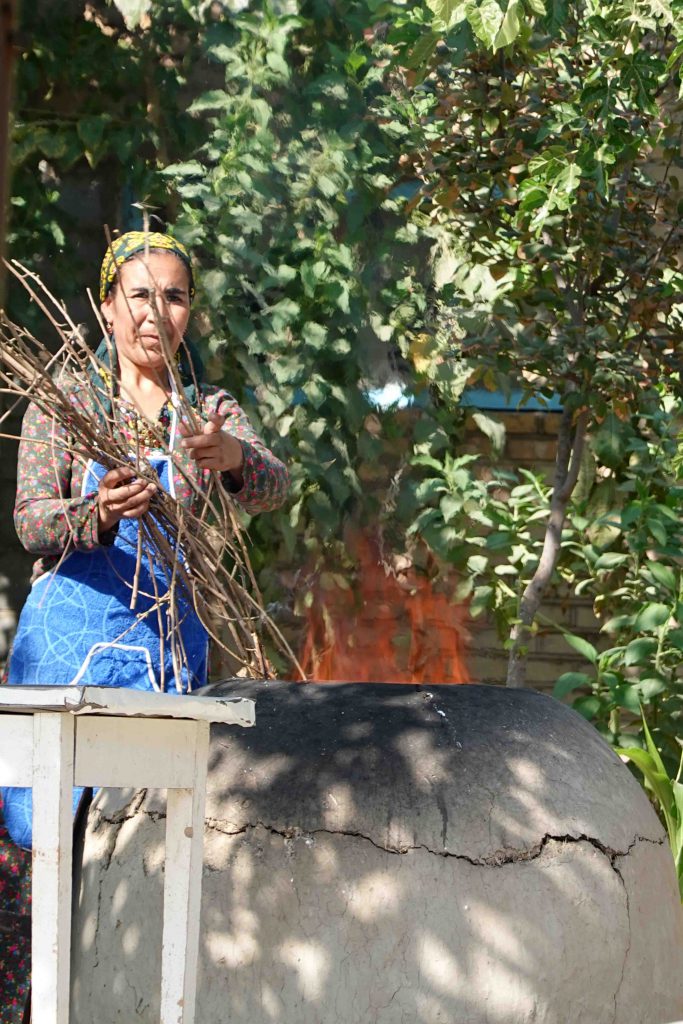
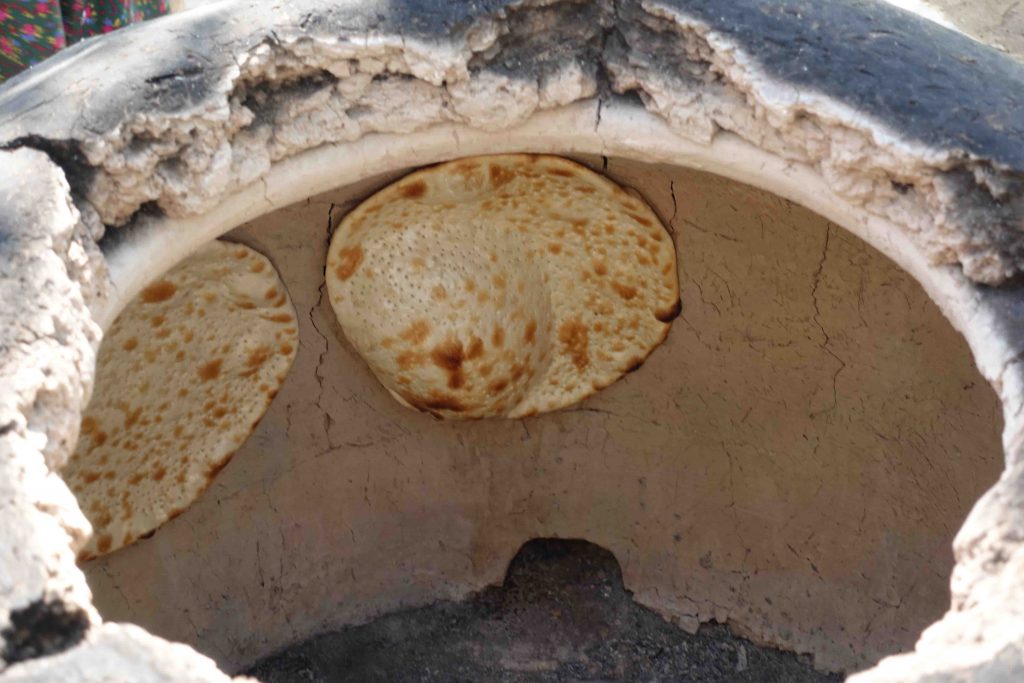
On the way back to Ashgabat we stopped in Kipchak and saw the Turkmenbashi Ruhy Mosque and President Saparmurat Niyazov’s Mausoleum, built 2004. The mosque is one of the largest in the world and is absolutely lovely, both inside and out. None of my photos even begin to do it justice.
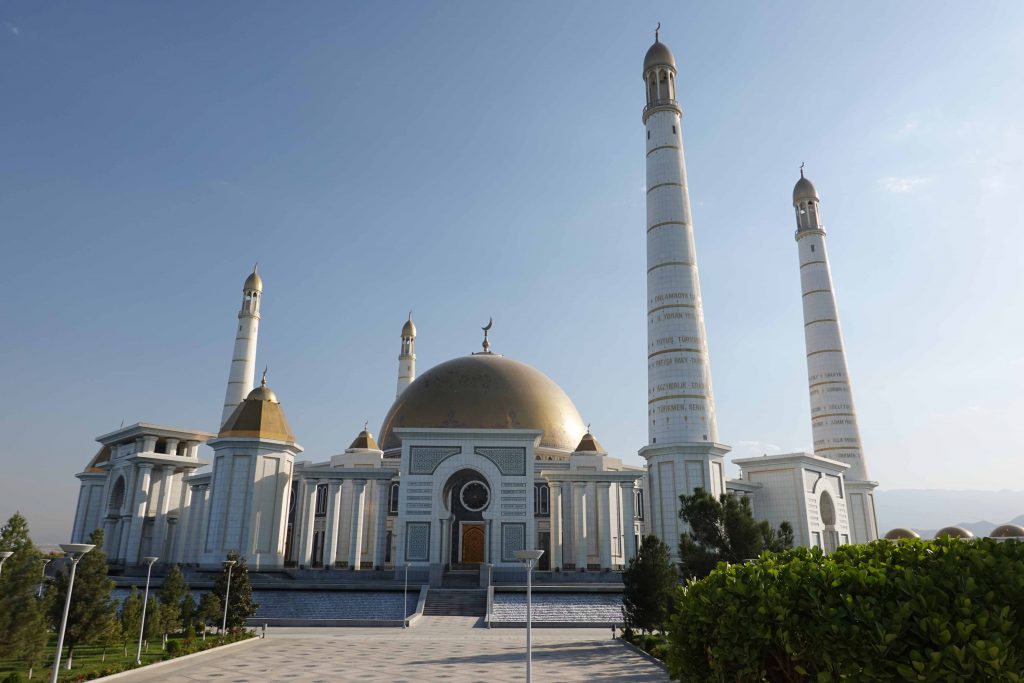
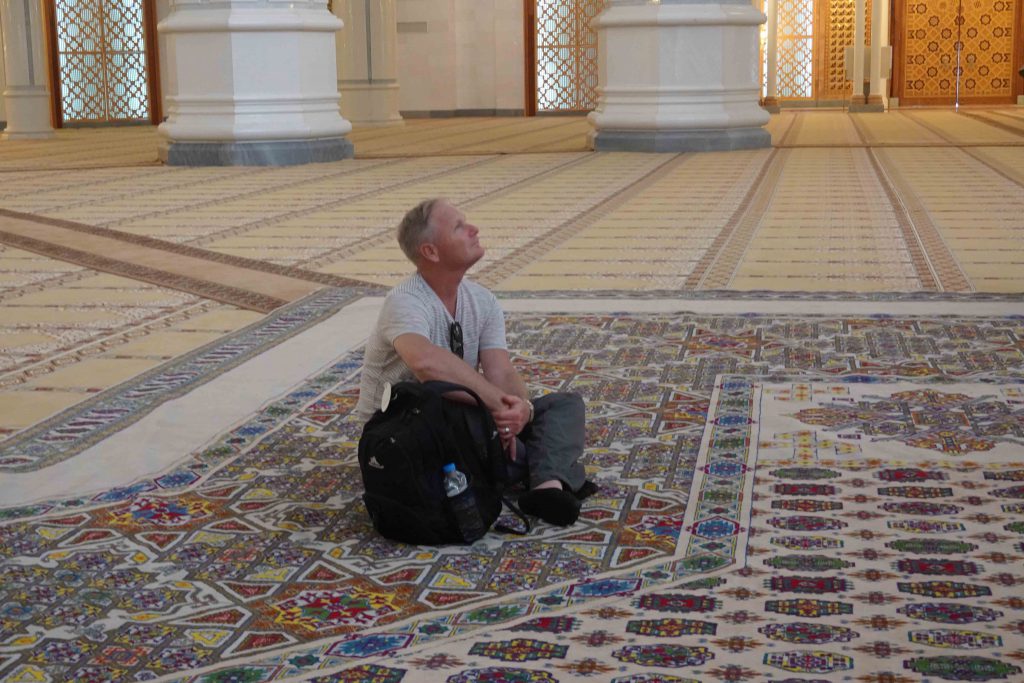
At dinner, the tomato soup was very tasty and, because they looked like them, what we jokingly called “twinkies” for dessert. As I’ve found on other trips, soup and dessert works well for me when eating dinner later than I prefer, though I often weaken and can’t resist the main course!
To Mary and Ancient Merv – Oct. 8
ElderTreks brochure: This morning fly to Mary followed by a transfer to Merv, the oldest of the oasis cities along the Silk Route in Central Asia. The remains of this oasis span four thousand years of human history and a number of monuments are still in evidence. Classical writers often mention Merv or Margiana, as part of the Achaemenian Empire in the 6th century BC until its invasion by Alexander the Great. The “Queen of Cities” as it was known in the Islamic world, Merv was considered as the second city after Baghdad between the 8th and 13th centuries and was an important town on the Silk Road. We will also visit the Mary History and Ethnography Museum, where the most impressive artifacts found at Margush are on display, and confirm the importance and high levels of development in this Bronze Age culture. Overnight in Mary: Mary Hotel.
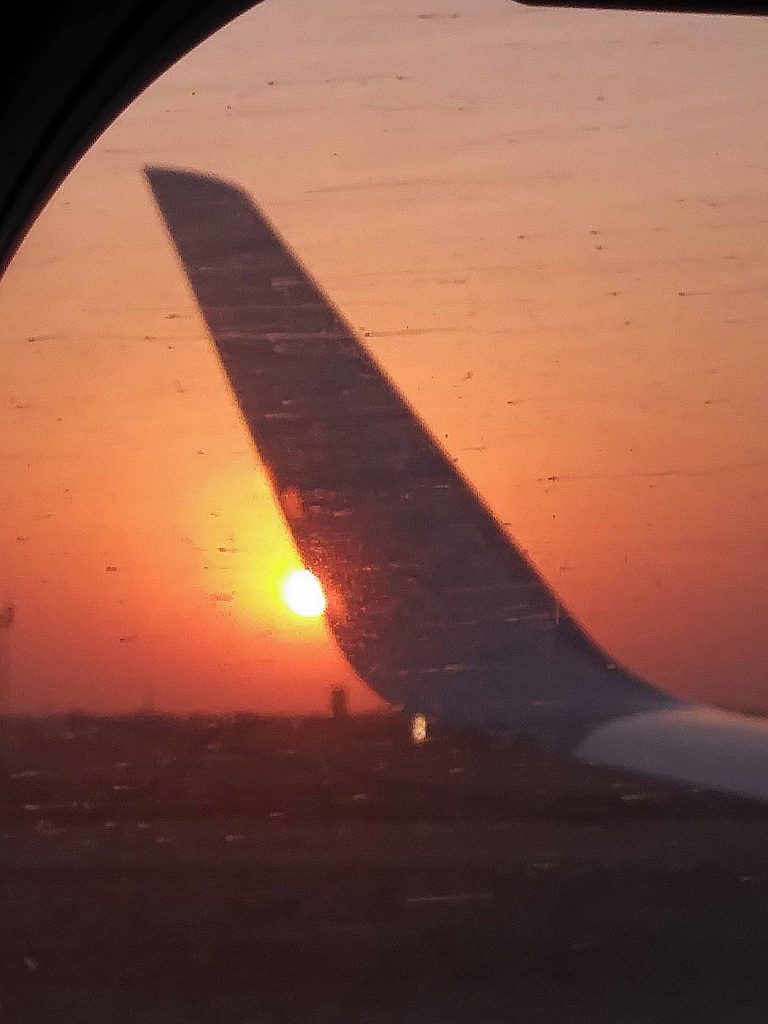
Very early flight to Mary (pronounced Mah-rie) and check in to the Mary Hotel in Merv. Roger had told us the breakfast in our hotel is poor, though lots of it, and he was correct, had shopped for us, and supplemented it with apples, bananas, dried apricots, grapefruit, yogurt, chocolate croissants, Starbucks (instant), and so on. Trish tried an omelet and left most of it–won’t order one tomorrow. I can understand how coffee can be sludge, but don’t know how anyone can ruin breakfast food, but they sure did.
He said this was the best hotel in town, the others were worse.
Toiletries in everyone’s rooms were partially used hotel bottles and leftovers from previous guests.
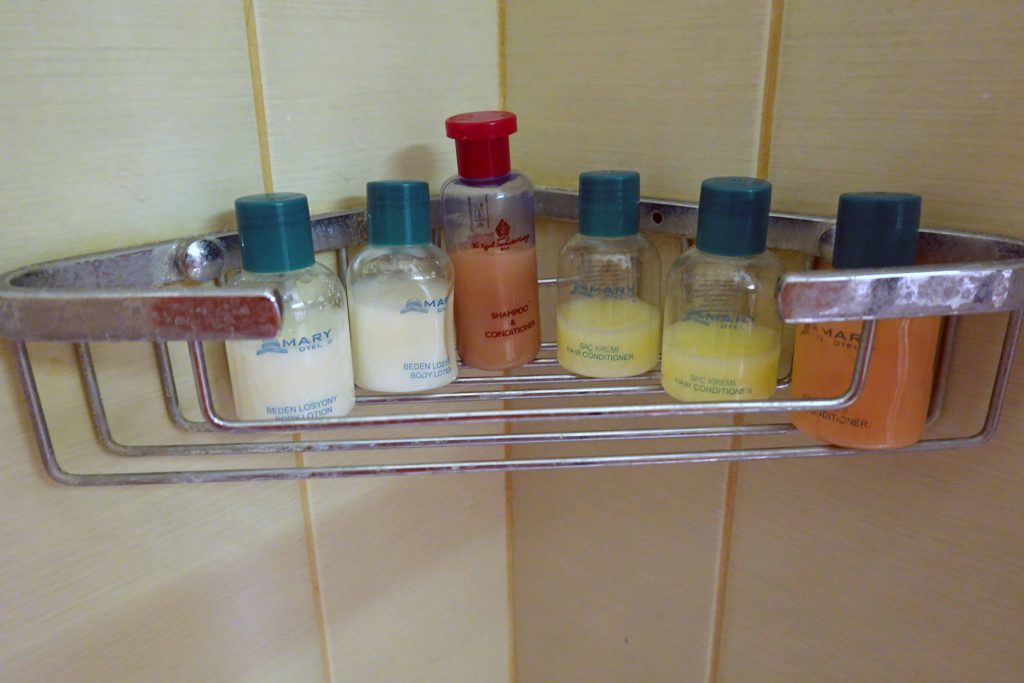
It’s late and I’m tired, so today’s post is mostly notes jotted down during the day.
Hotel–press both buttons to flush the toilet.
Intermixing of looks Mary is because this was a big crossroad on the Silk Road — dark skin and light; Persian, Asian, European and Tartar looks; red hair, black and blonde; brown, green and blue eyes.
People from this province are very industrious and business-minded.
Merv:
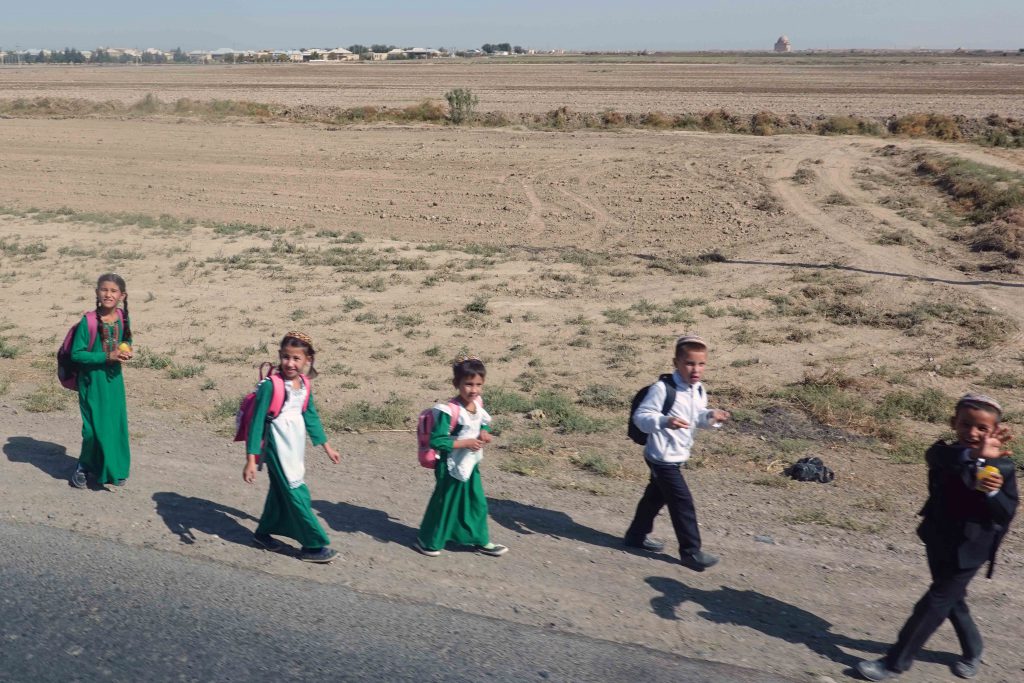
Omar Khayyam lived in Merv, worked on his astronomical tables, and in the Library for a few years.
Merv reached its greatest heights during the peak of the Silk Road in the 11th and 12th centuries, when the Seljuq Turks made it their capital. Some people think 1001 Nights was based on Merv.
The river moved and the people followed, that’s why five separate cities, not one on top of another as elsewhere. It is what Georgina Herrmann, Honorary Professor at University College London, described as a ‘wandering city’. (https://www.rolex.org/rolex-awards/cultural-heritage/georgina-herrmann)
River is red from salt, not blood. (Eve’s finding–it smells!)
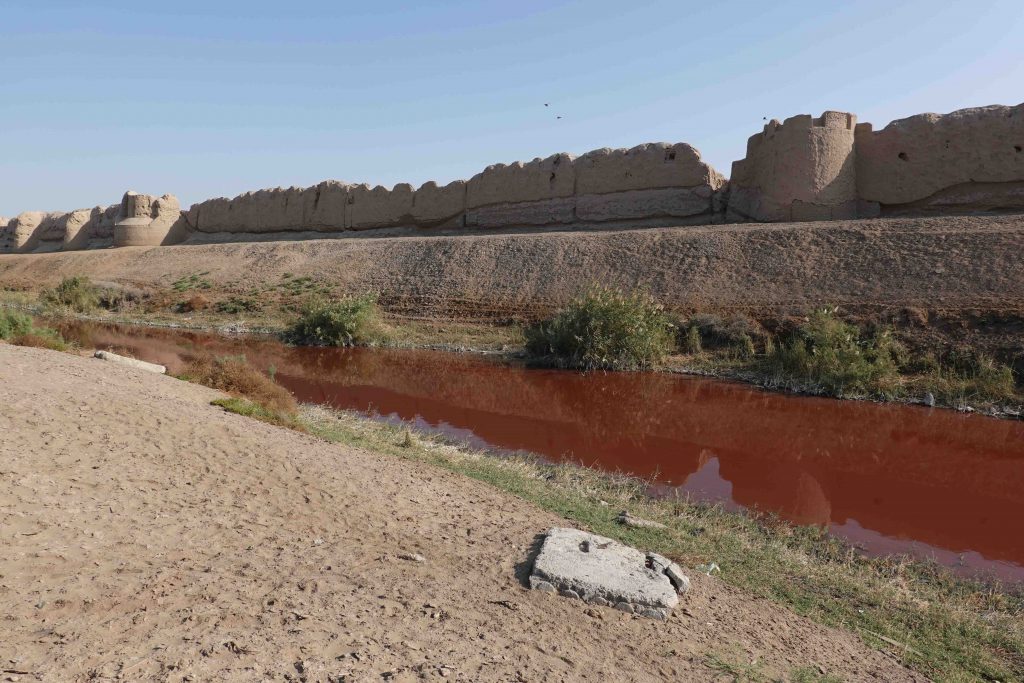
Next place we visited: Mausoleum of Sultan Sanjar.
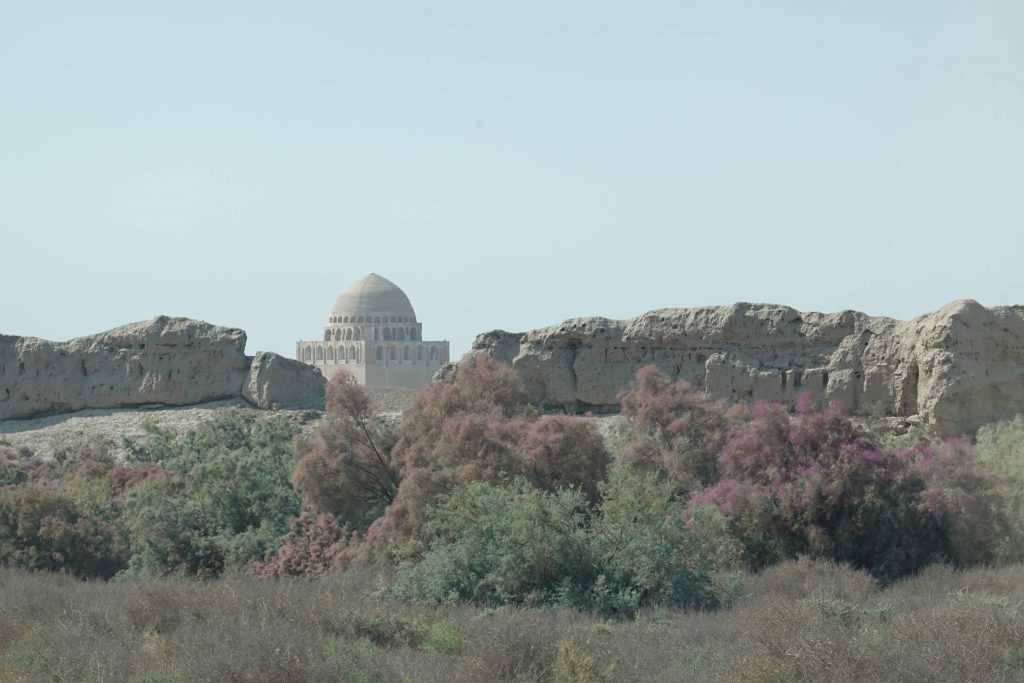
According to legend (I love these stories!), Sultan Sanjar saw a beautiful woman, fell in love with her, and asked her to marry him. She agreed as long as he would adhere to three conditions–he would not look at her feet, he would not watch her comb her hair, and he would not try to embrace her. He was so in love, he agreed to all conditions. Long story short, he disobeyed, did all three, and discovered she was a fairy. After his third transgression, she left him and flew away.
After much begging and pleading by Sultan Sanjar, she finally gave in and agreed to return and visit him from time to time, but only if he agreed to build her a beautiful building with a window in the dome where she could fly in and out. It is unusual to have a window here, do you see the outline of her below the window?
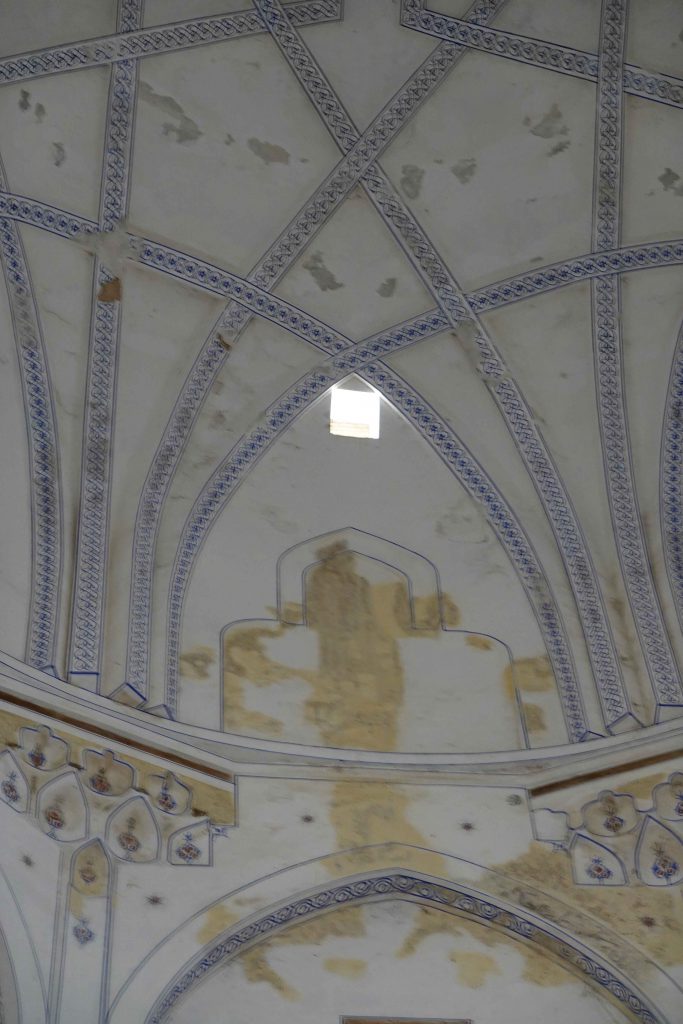
On this deathbed, he asked her to visit one last time. She did, carrying the box of jewels he’d given her when she was in human form. She accidentally dropped them in the dome, where they stayed. It is said that Russians arriving here in the late 1800’s, after hearing this story, damaged part of the dome searching for the treasure but it was too well hidden for them to find.
Then we spent some time at the tomb of Hodja Yusef Hamadani, born 1048, one of the founders of Sufism.
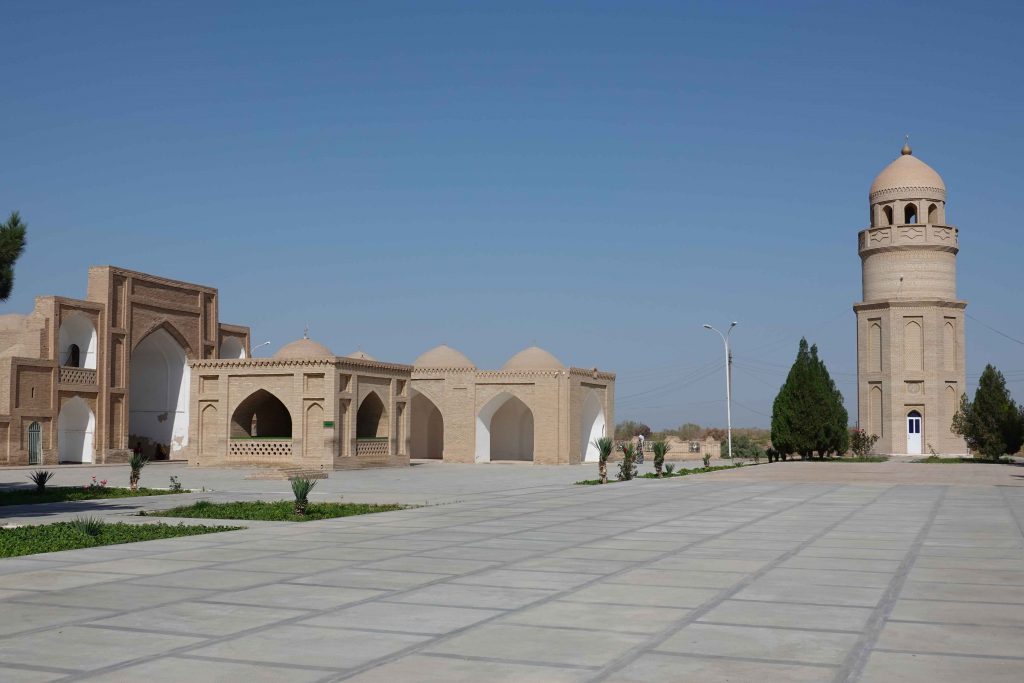

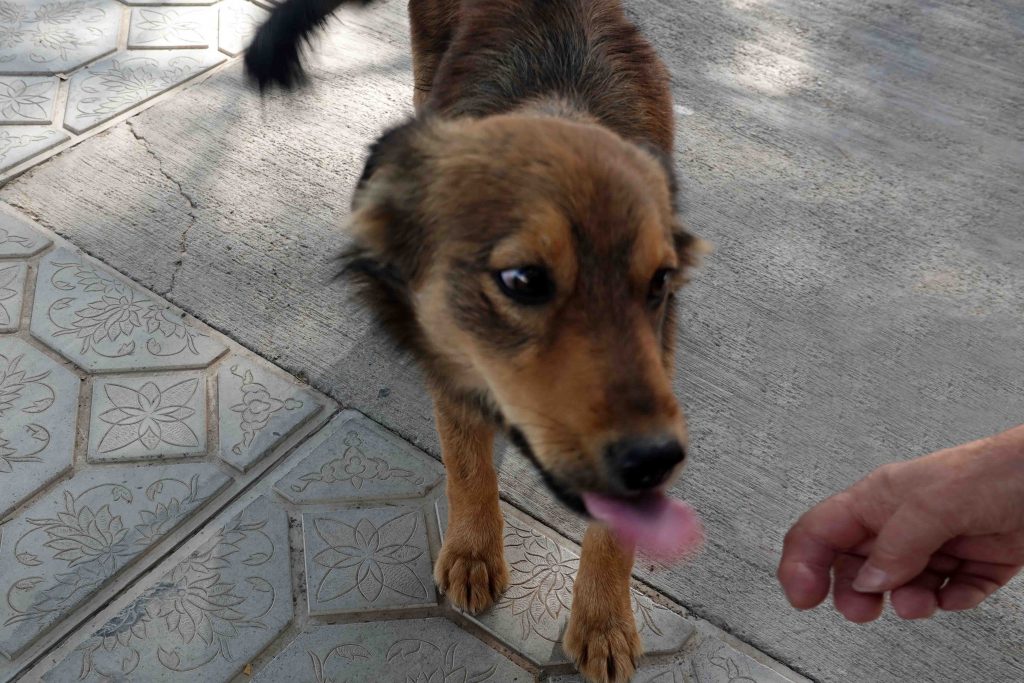
Last stop, the city of Alexander. Corrugated walls. Some researchers think it is uniquely Mervian, others think the design migrated from northern Iran, and still others vice versa. This city’s look really caught my interest.
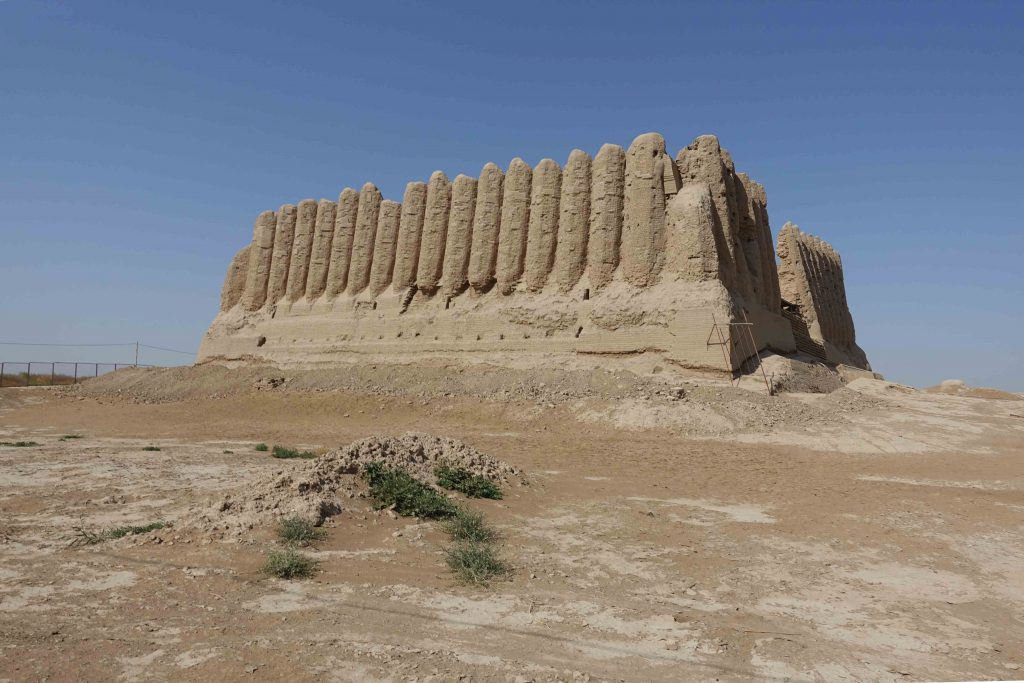
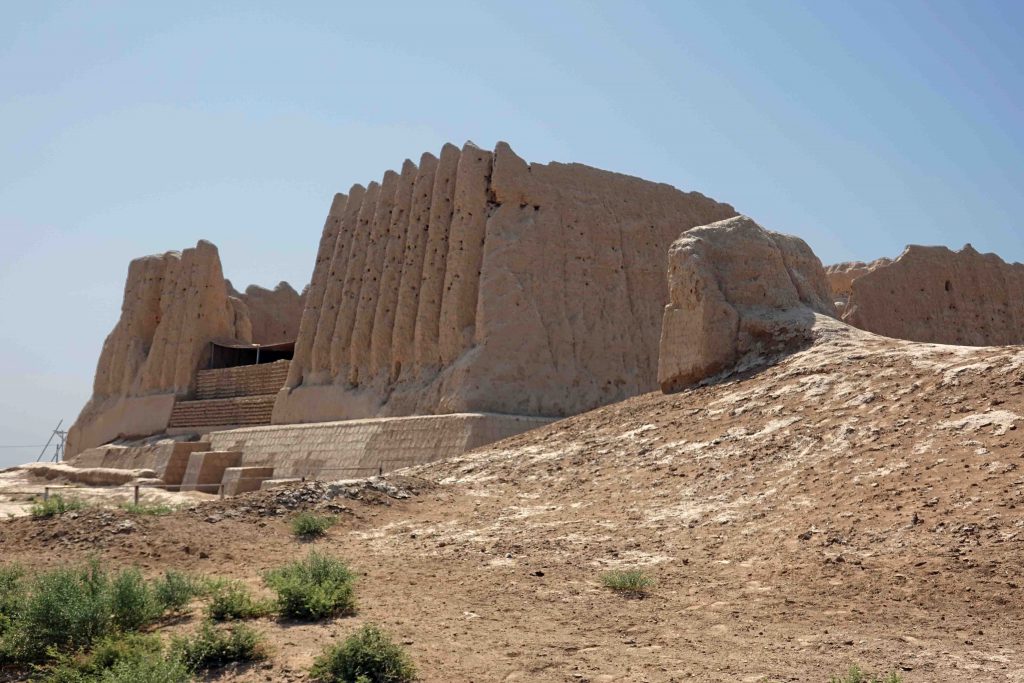
Back in Mary, dinner tonight was at an elegant place, Safi. The staff were nice but the food was awful, unbelievably bad. No one ate much and we were all pushing away our plates and glad to get out of there.
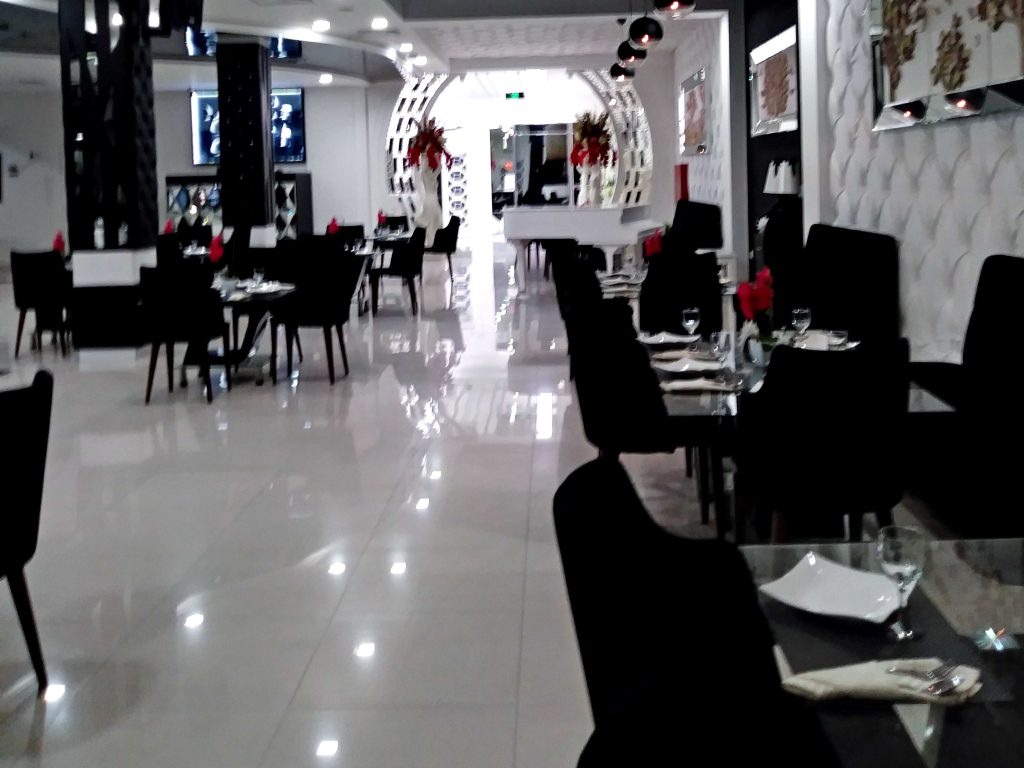
Notwithstanding the disappointing restaurant, it was a most enjoyable and interesting day.
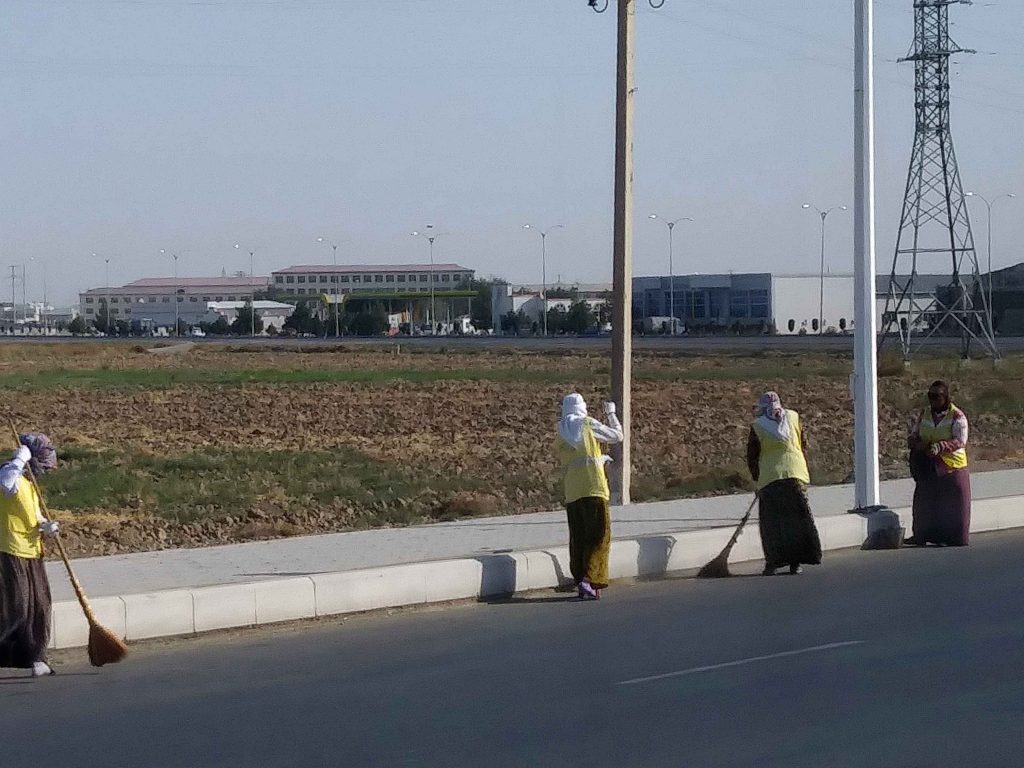
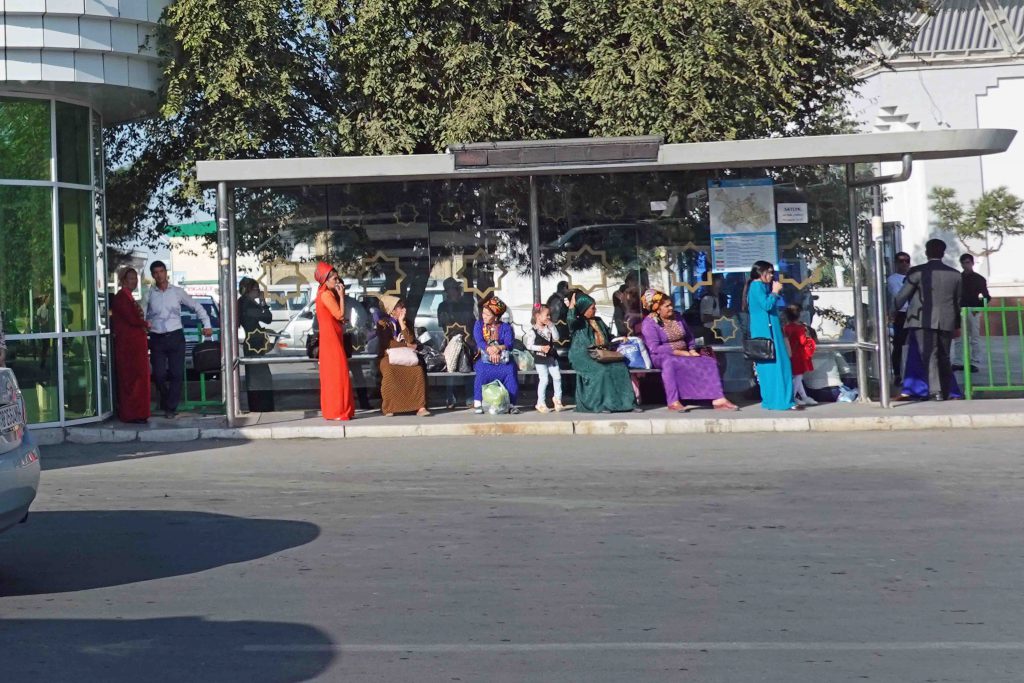
To Margush, return to Ashgabat – Oct. 9
ElderTreks brochure: We drive through the desert for 2 hours, into the area that used to be the delta of the Murgab River, to the site of the ancient country of Margush, believed by many to be the birthplace of Zoroastrianism. We visit the remains of Gonur Depe, the center of Margush country, which dates back to the Bronze Age (3000-3500 BC). Archaeologists debate whether Margush classifies as a fifth ancient civilization or culture, on par with ancient Egypt, Mesopotamia, India and China. The famous Bactrian gold, found at graves in northern Afghanistan, would have been from people belonging to Margush, which is also referred to as Bactria-Margiana. We take an evening flight to Ashgabat. Overnight in Ashgabat, Nusay Hotel.
Another breakfast provided by Roger, same muck provided by the hotel. Left the hotel at 8 a.m. for the drive to Gonur Depe archaeological site, with a stop along the way to see where bread and samosas were being cooked in traditional ovens.
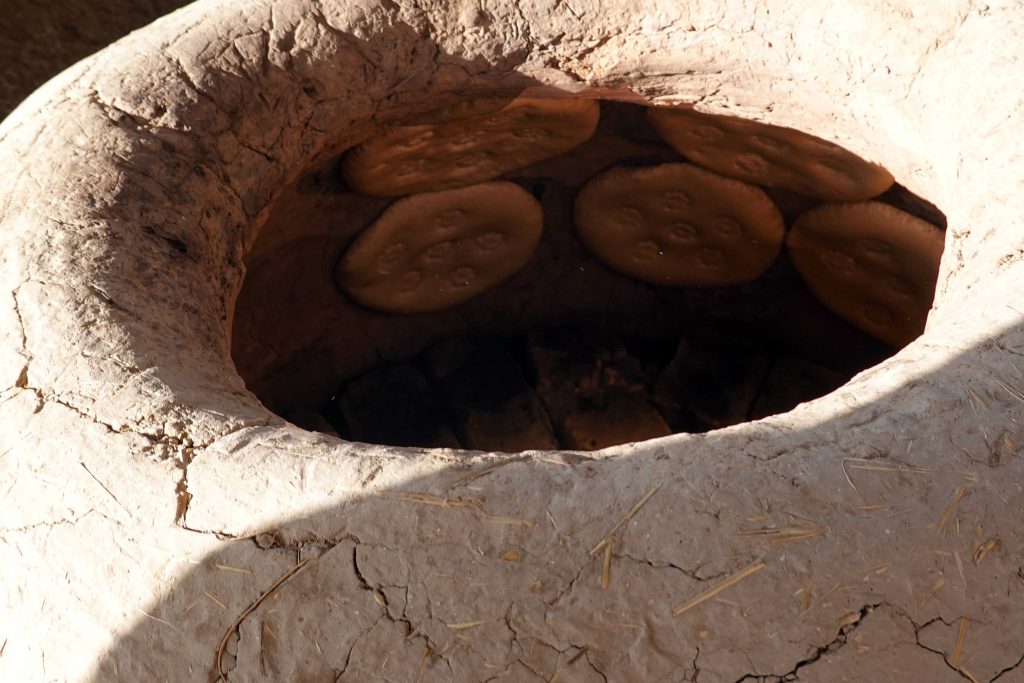
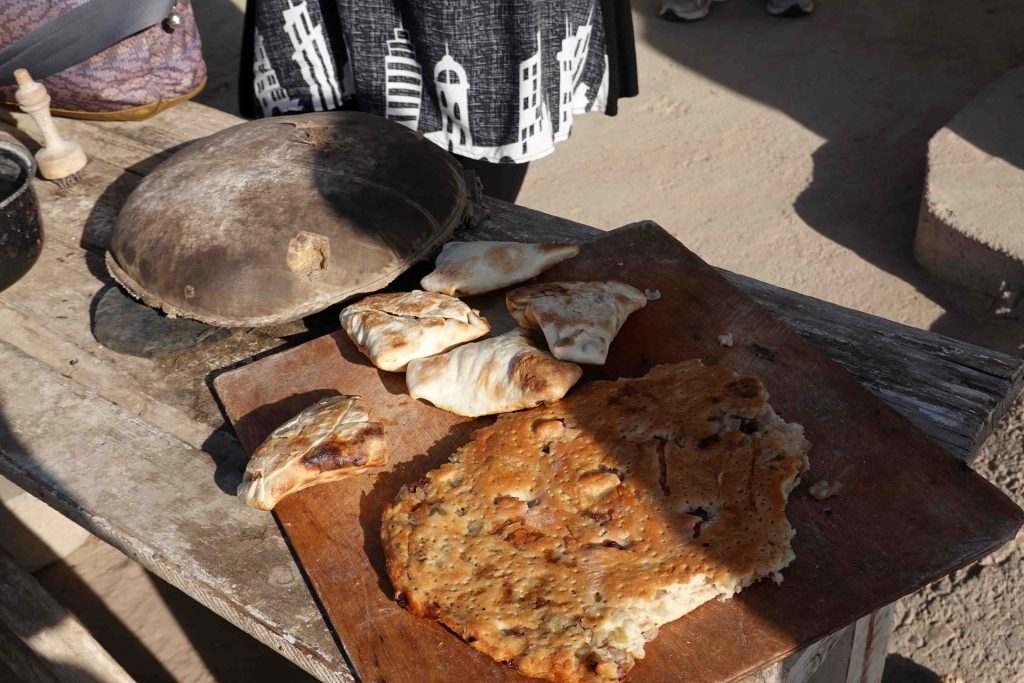
It amazed me how the drivers found their way through the scrubby desert with tracks/roads leading off in every direction, every few yards. Elaine and I joked about how GPS directions would work out there (“turn left at the next bush”). And–why so many tracks, who uses them all? Our driver left the convoy to get out of the dust from the cars ahead of us and all the vehicles ended up at the staging area about the same time.
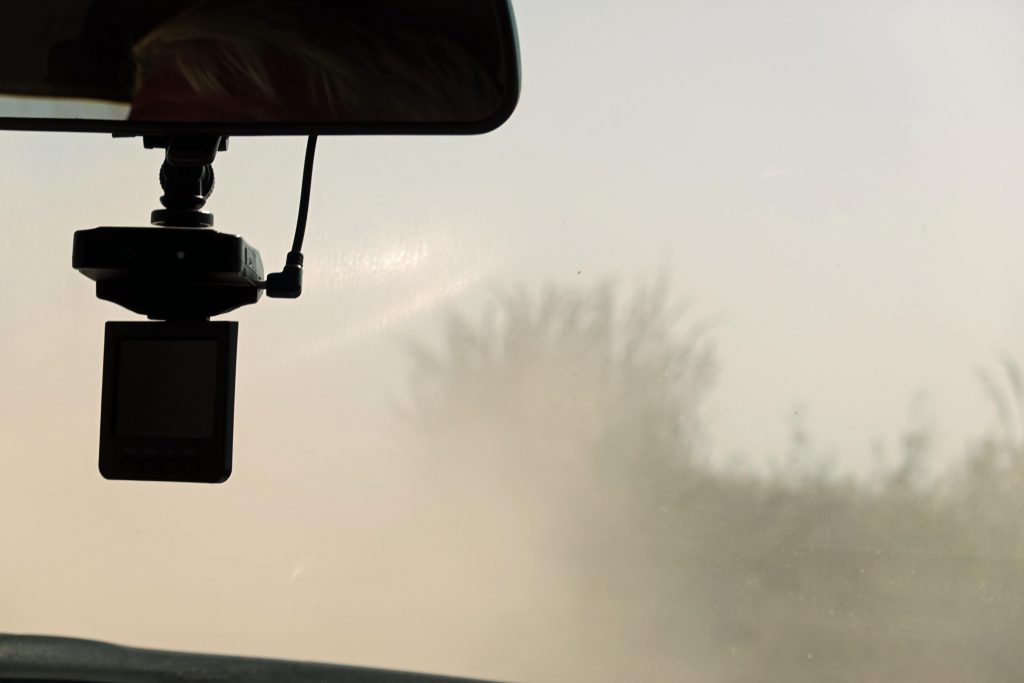
Very sandy and dusty in places
At Gonur Depe, Trish braved the heat (you can tell I didn’t–my thermostat doesn’t work all that well any more) and came back extremely flushed, I’ve never seen her look like that before. Red as a lobster in a pot of boiling water. Took quite a while before she cooled down enough for her skin to return to normal. She was glad she’d seen the exhibit at the museum the previous day as it helped with what she was looking at today. The consensus: broiling sun, no shade, standing around looking at ruins, listening, wondering how much longer this was going on and looking forward to when it was over. Didn’t hear anyone raving about it, though maybe some really enjoyed it and didn’t say anything with all the moaning going on.
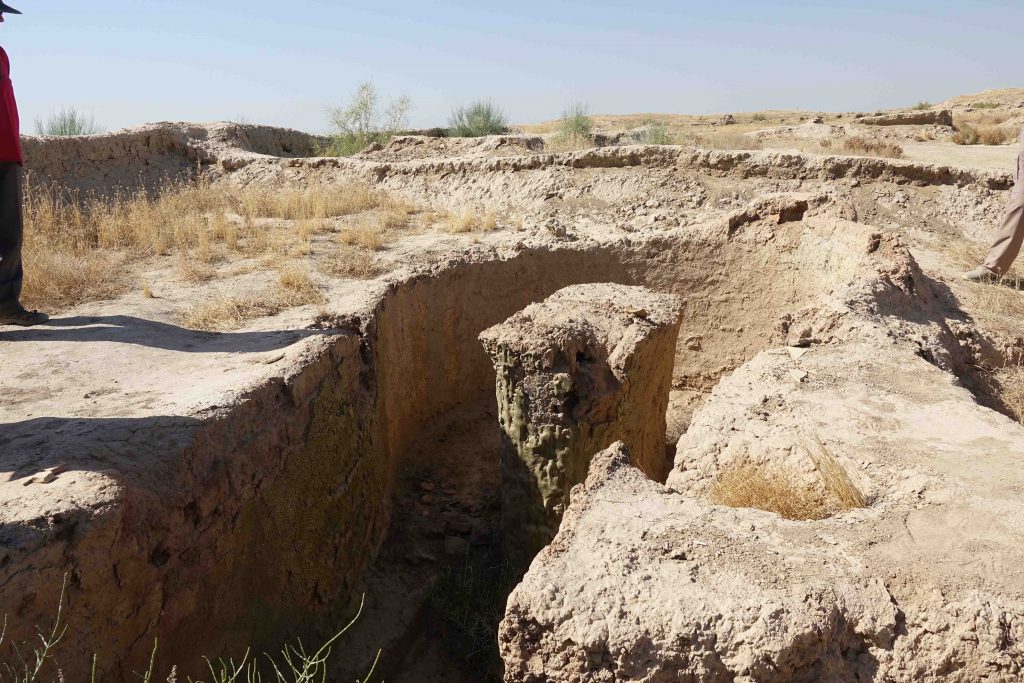
It was not that long a walk, about five or six minutes away from where those who stayed in the shade were waiting. Most of the hour and a half we’d been told would be hiking, was not, but was standing around looking at the ruins. One ET-er said that, with our group who didn’t have any problem getting up early, it would have been much more sensible and pleasant if we’d left at 6 or 7 in the morning to beat the midday heat.
The boxed lunch provided by the hotel was a chicken leg, rice, two samosas, an orange, and a small box of cherry juice, supplemented by brownies and cookies from Roger.
Yesterday evening when today’s schedule was described, there was a really bad miscommunication. I hate to whack on Roger because he is a kind man and superb guide, but he really blew it this time. Everyone thought we were all required to go on it. That here in Turkmenistan, a tightly-controlled police state with a rigidly authoritarian political system and censorship blocking many websites and media, if the group was going somewhere, we all had to go along. (A previous example of this was before the trip started–as we were on a group tour, we weren’t “allowed” to make our own hotel reservations for the extra night or two some of us were staying over. As we were on a group tour, it could only be done by the tour company, ElderTreks.) If we’d known this was not so, that we had a choice, quite a few of us would have relaxed at the hotel–there was nothing being offered we hadn’t done before other than nine hours, there and back, over rough roads, to an archaeological site to which we weren’t going to hike 1 1/2 hours in the broiling sun to look at.
Here are some photos taken during the journey back to Mary:
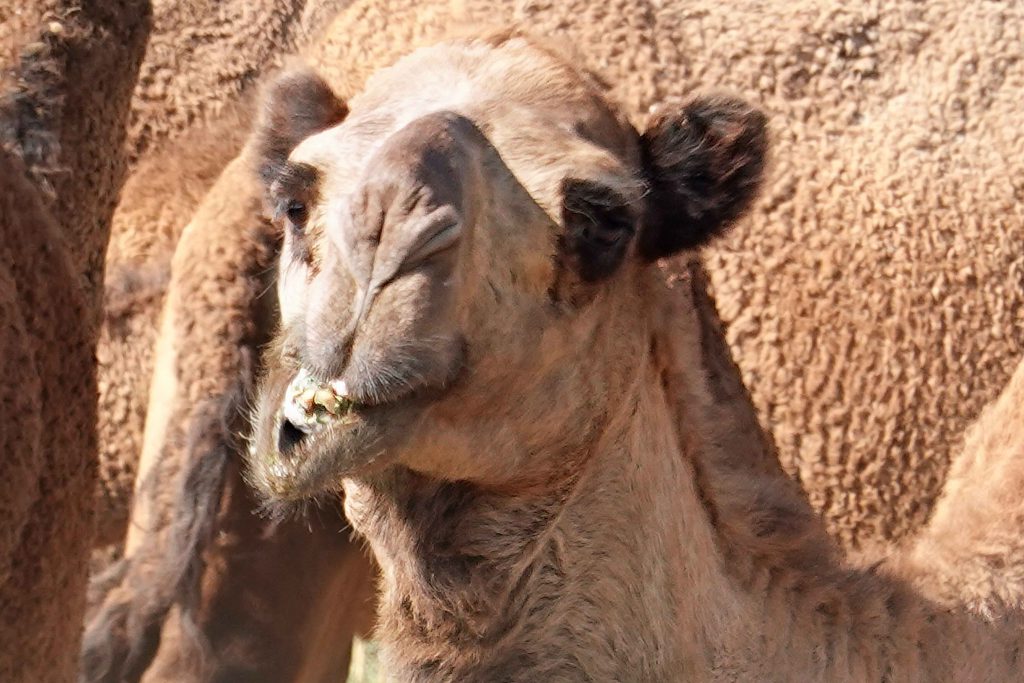
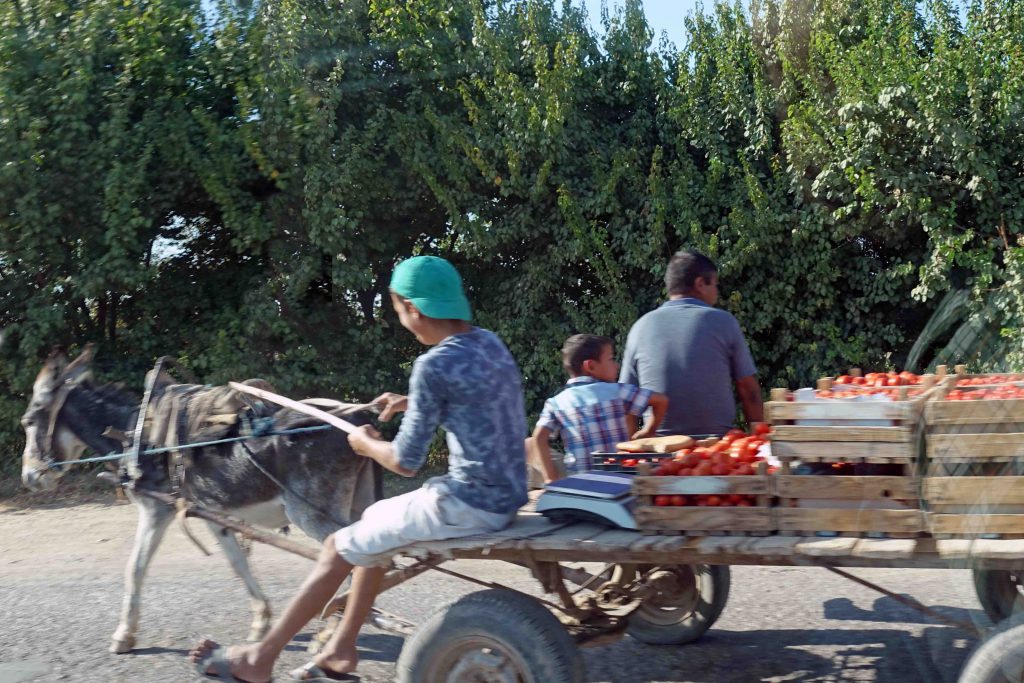
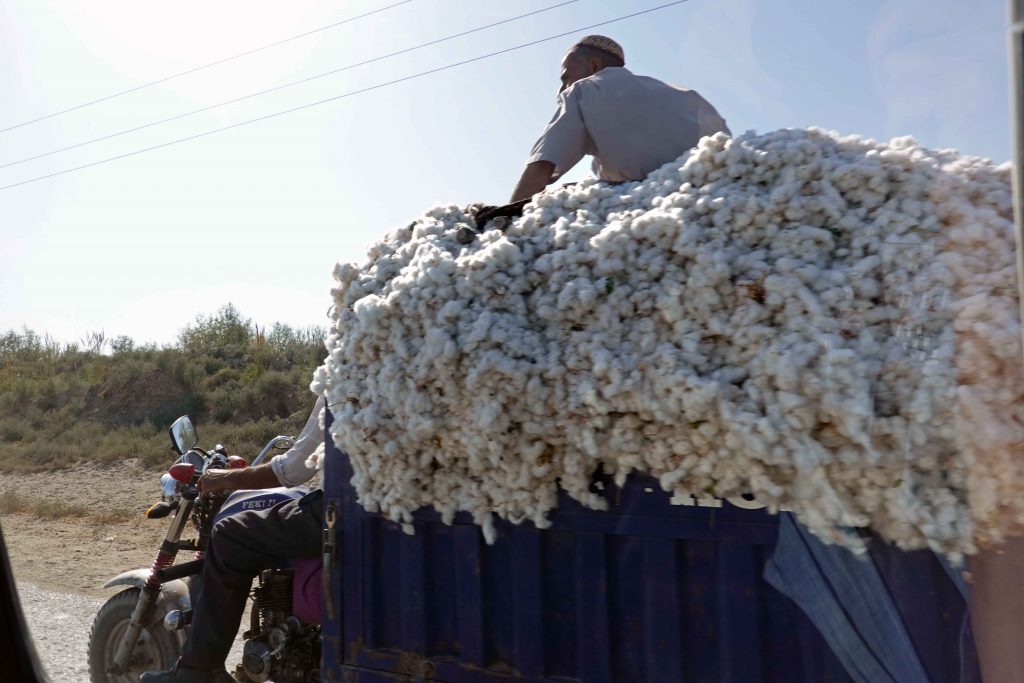
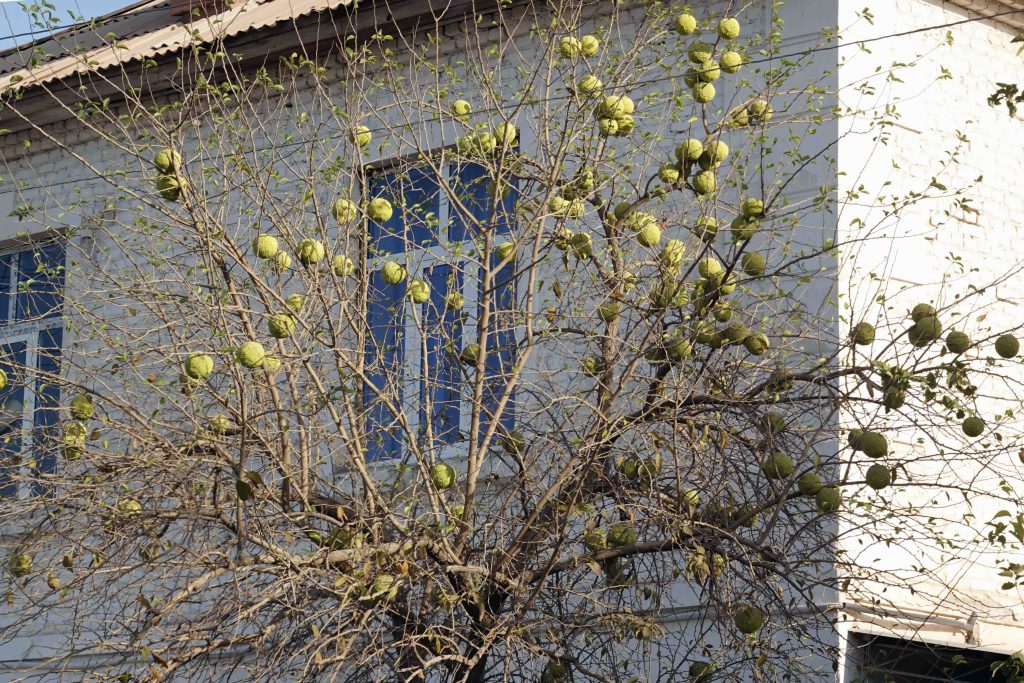
Upon our return to Mary, we took a potty break at our hotel followed by a short visit to see the local Orthodox Church.
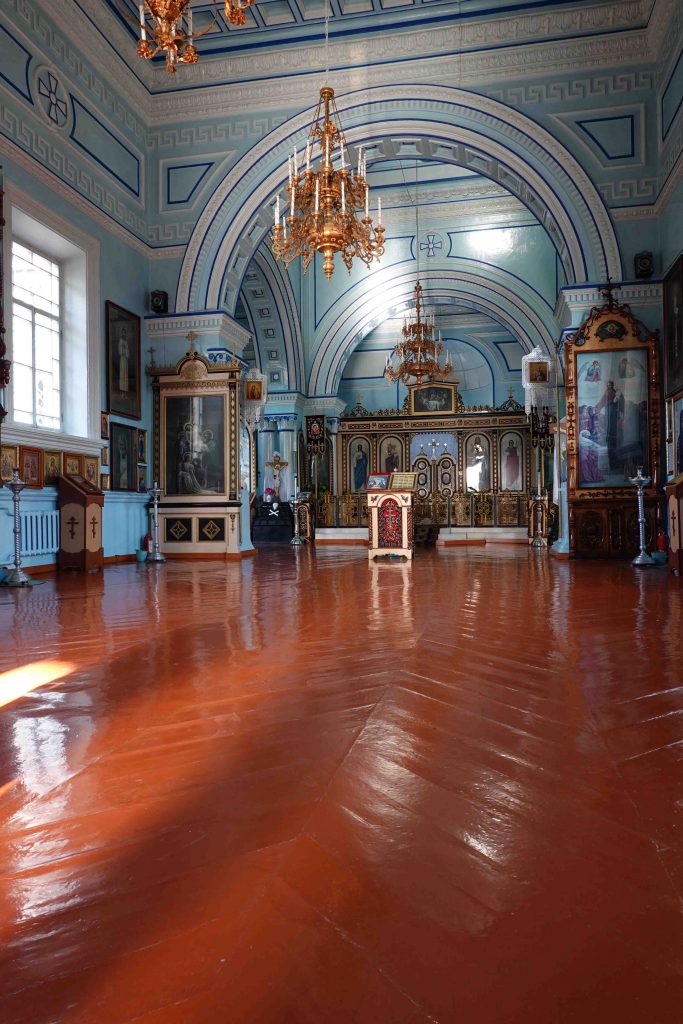
Then a flight back to Ashgabat and dinner by the hotel pool.
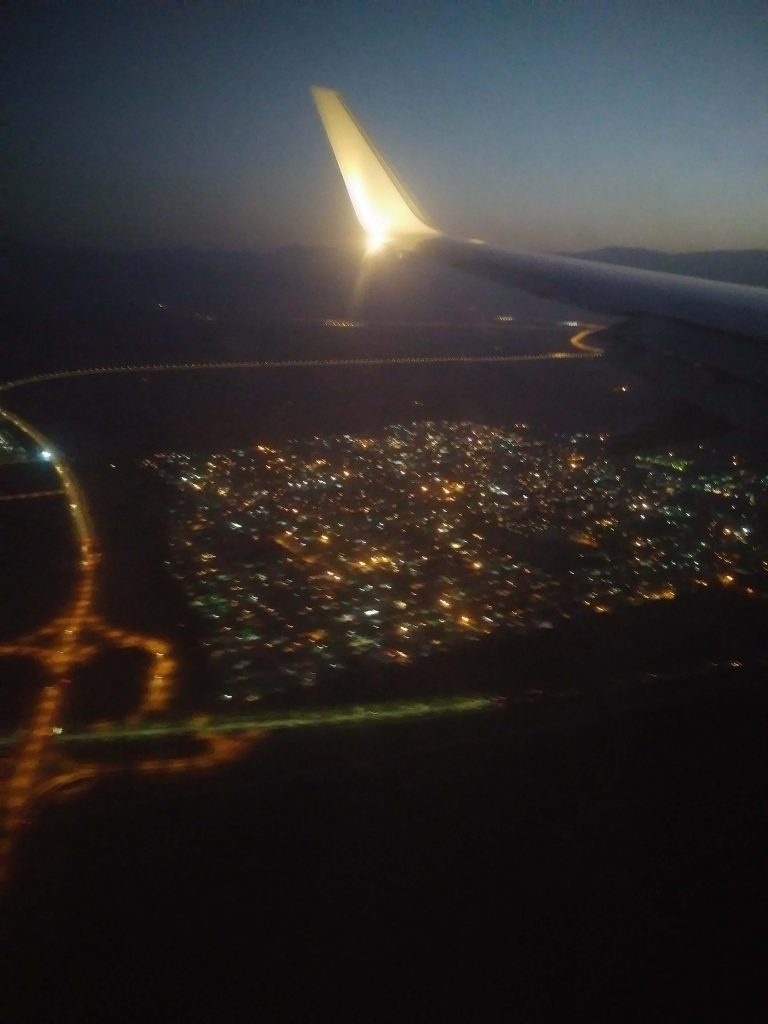
Ashgabat, to Awaza – Oct. 10
ElderTreks brochure: We have a day trip in the surroundings of Ashgabat. As we travel closer to the mountains, we visit Kowata underground thermal lake near Baharden Town. For a swim in the lake, you will need to descend 175 steps to the lake, which is located at 60 meters depth. From Kowata, we drive into the Mountains to Nohur village and visit its unique tribal cemetery, the nearby Kyz Bibi pilgrim site and a local home where women practice traditional silk weaving. We return to Ashgabat and transfer to the airport for an evening flight to Turkmenbashi. Overnight in Awaza, Yelken Yacht Club.
Our first stop was Kowata underground thermal lake near Baharden town, it smelled of sulphur up top but not down in the lake.
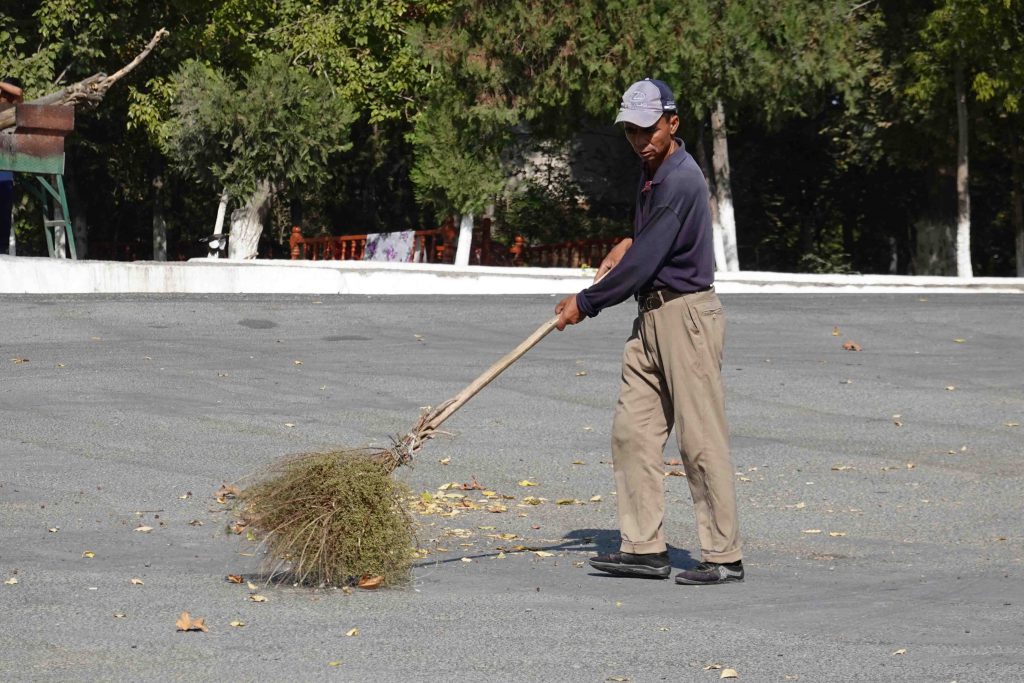
Leroy was approached by a gentleman who asked him, “How old?” When Leroy told him “79,” the man pointed to himself and said, “1940,” then Leroy pointed to himself and said, “1939.” That was pretty much the extent of his English, which was more than our ability to talk in Turkmen or Russian (“da, nyet, wodka”).
With charades, smiles, and a few words, Leroy found out that the man, his brother and wife were on a day trip out from Mary. His face lit up when he learned we were from Colorado (“Ahhh, USA. America!”). He had more lines in his face than Leroy but looked younger because his hair was still mostly dark (so was his brother’s). He also had the gold teeth that we saw in many mouths and have traditionally been a sign of status. A very charming man.
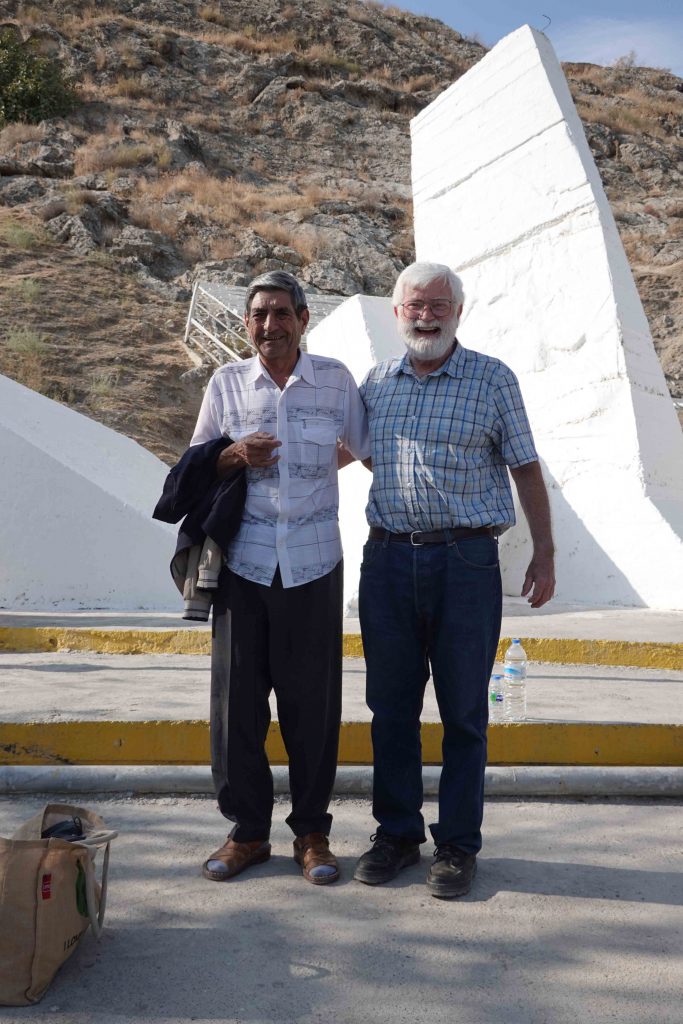
Lunch in mountainous Nohur village, the tiny lanes lined with houses and fence walls made of stacked stone.
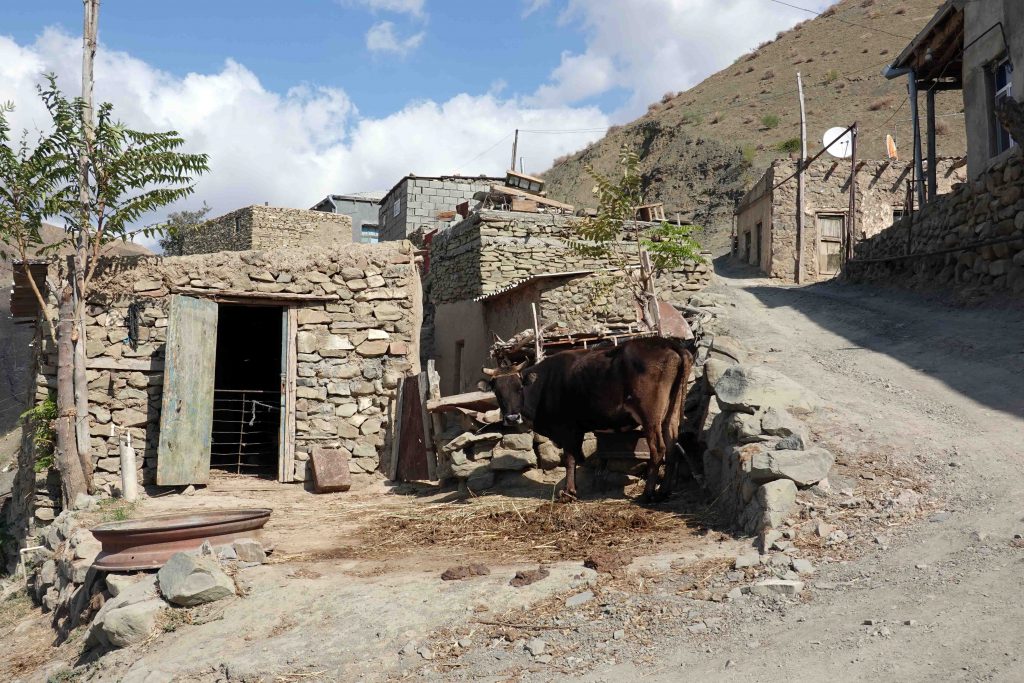
The 14-year-old daughter of the family where we had lunch demonstrated weaving silk. Had fun dressing up in sleeveless coats.
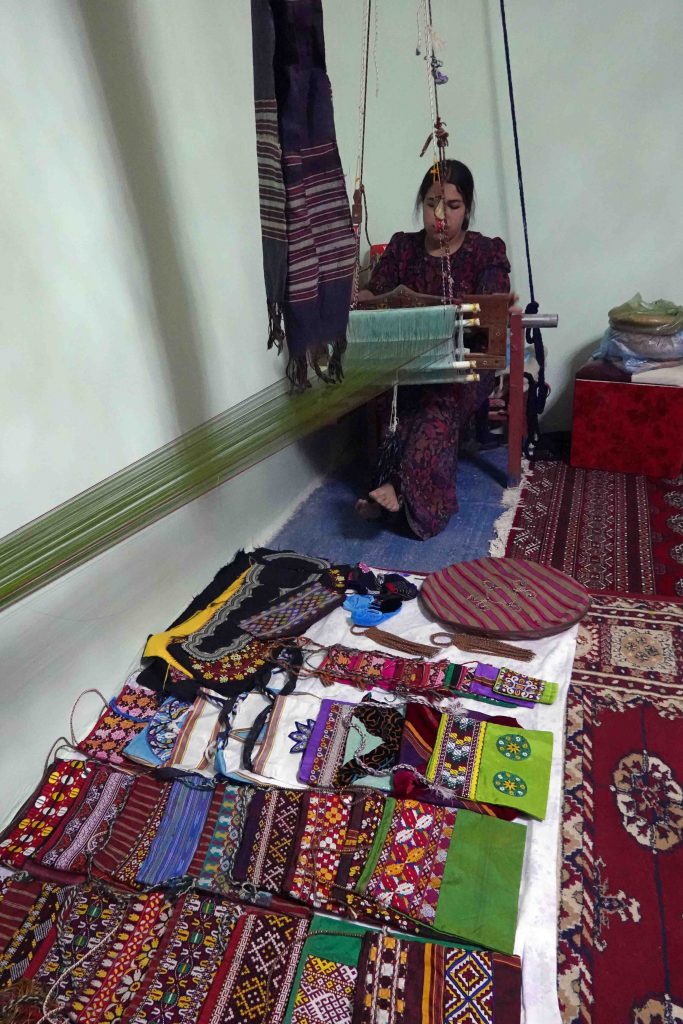
The family were wonderful hosts and went to a lot of effort to make a tasty lunch for us. Quality candies for dessert including small, dark chocolate covered, Turkish Delight and some kind of wafery bar with a slight condensed milk taste. Have to see if I can find them in the market in Ashgabat to take back home for the family to enjoy.
We stopped briefly at a tribal cemetery where nearly every grave is marked by a wooden post adorned with the horns of a mountain goat. The goat horns are thought to fight off evil spirits and help the souls of the deceased to ensure a safe passage to heaven.
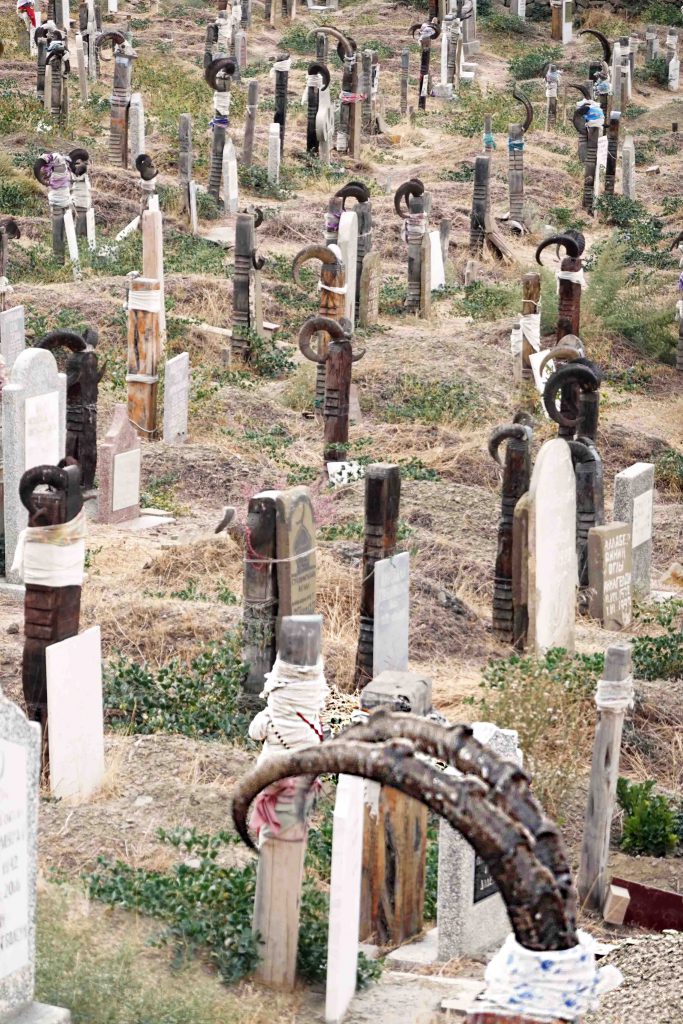
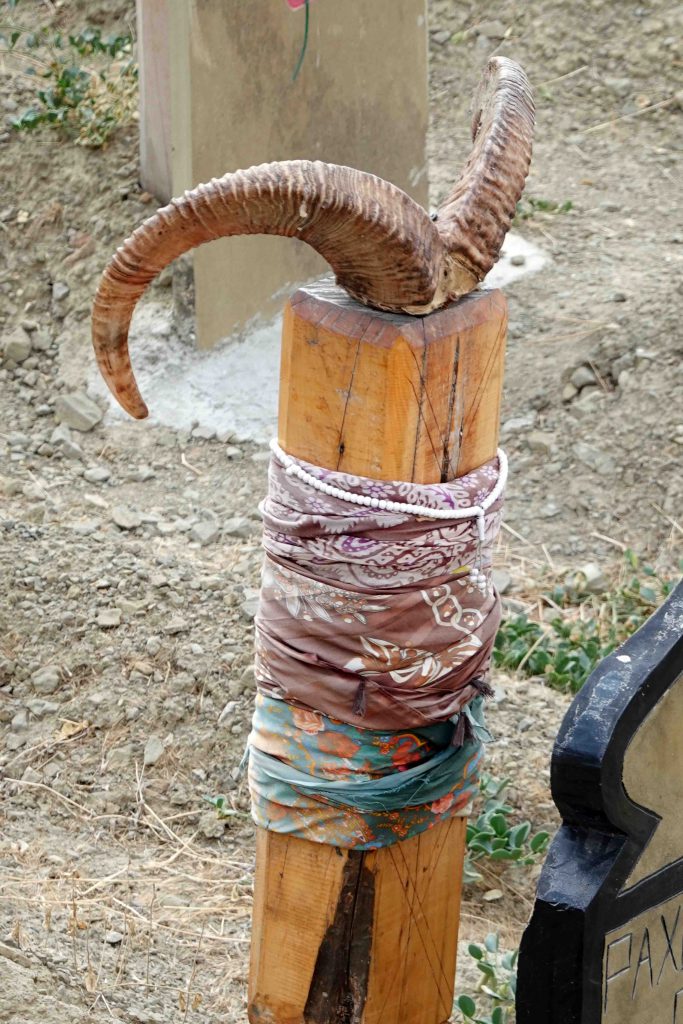
It was a pleasant, laid-back day.
Flew to Turkmenbashi.
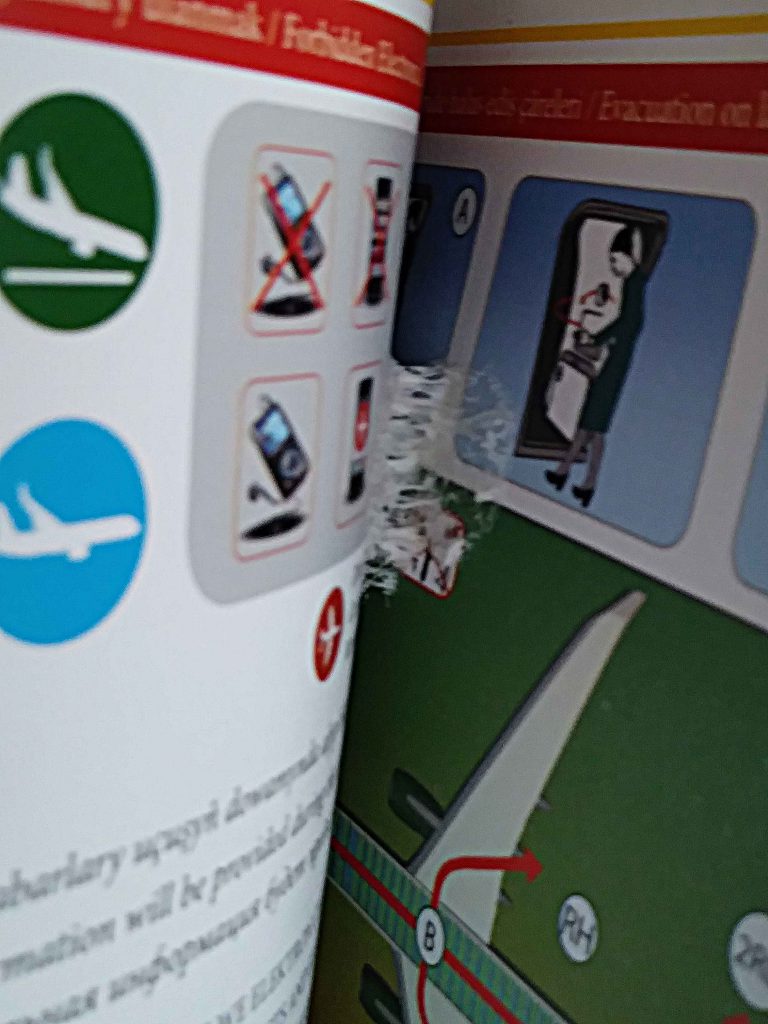
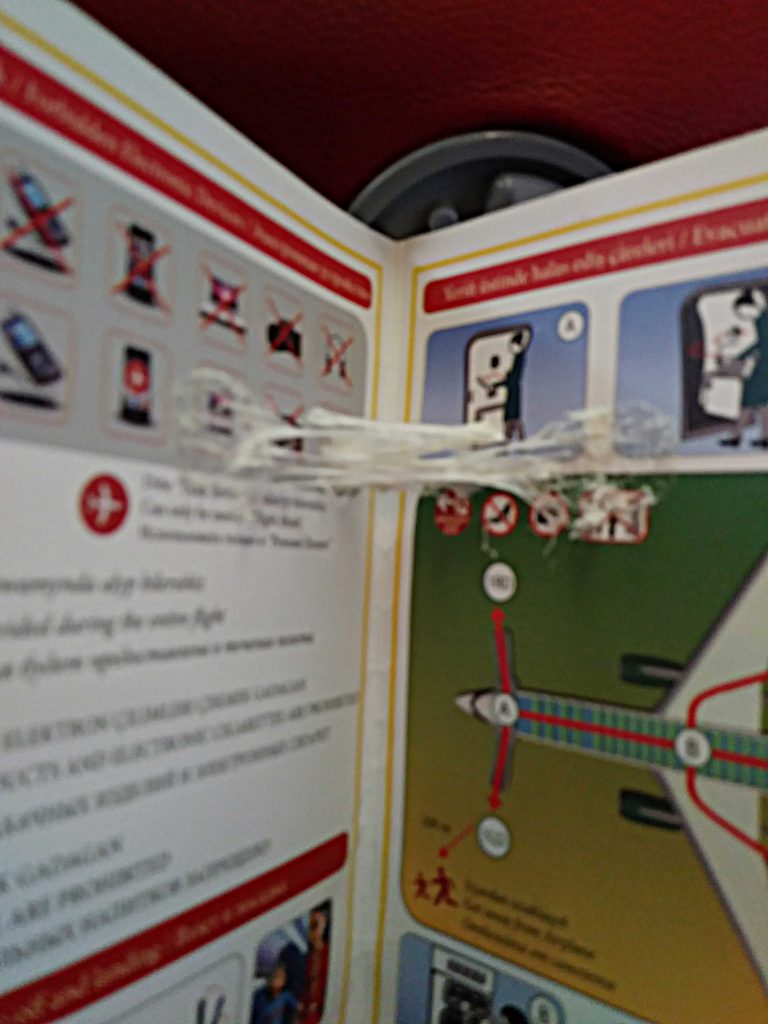
Our room at the Yelken Yacht Club is modest and has a terrace veranda. Was dark when we arrived but this looks like a nice place. If we don’t want to walk to the restaurant/main building from our room, we can dial ‘0’ and request a golf cart come and get us. We’re very close and will walk.
Had the best meal of the trip–chicken and mushrooms in a spaghetti sauce with noodles. The staff was extremely well trained, outstanding.
Tomorrow, if we’re going on the trip to Yangikala, we should wear sturdy walking shoes and bring a warm jacket as the canyons can be extremely cold and windy.
Day trip to Yangikala – Oct. 11
ElderTreks brochure: This morning we drive northeast through the foothills of the Balkan Mountain Range, past highland areas where camels, sheep and horses graze, until we reach the surreal landscape of Yangikala. From a fabulous viewpoint, we can see these impressive limestone formations, remains of massive coral riffs from pre-historic times, rise up from the desert sands with their colorful layers of rock. We will have to relax and enjoy the beautiful surroundings of the hotel this afternoon. Overnight: Yelken Yacht Club.
Started off at 8 a.m. for the three-hour drive in four-wheel drive vehicles across rough roads and through the desert to the fantastic rock formations of Yangikala. Climate change caused the seas to retreat and expose these fabulous vistas. It covers a vast area.
Yangikala means “fire fortress” in Persian — seems like a perfect name for the canyon’s colorful bands of rock as I imagine they really glow at sunrise and sunset.
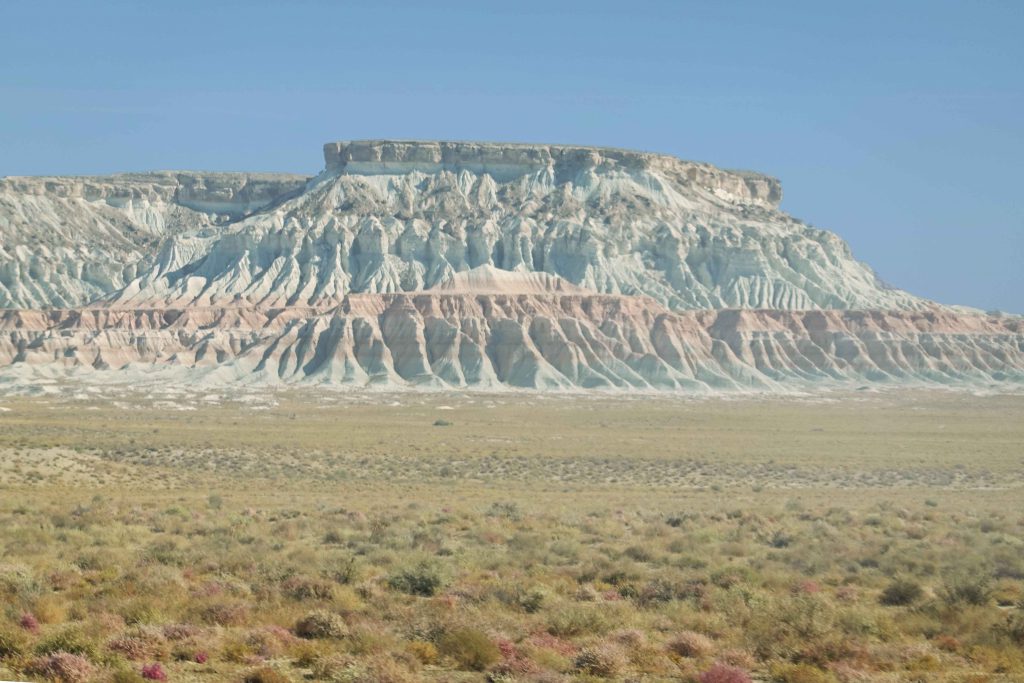
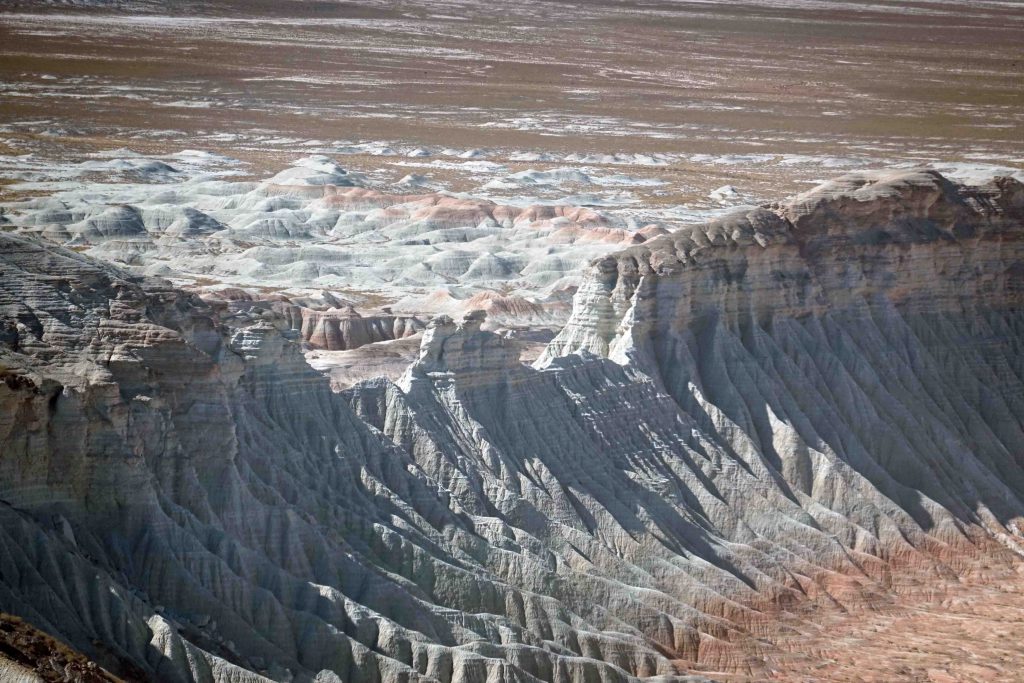
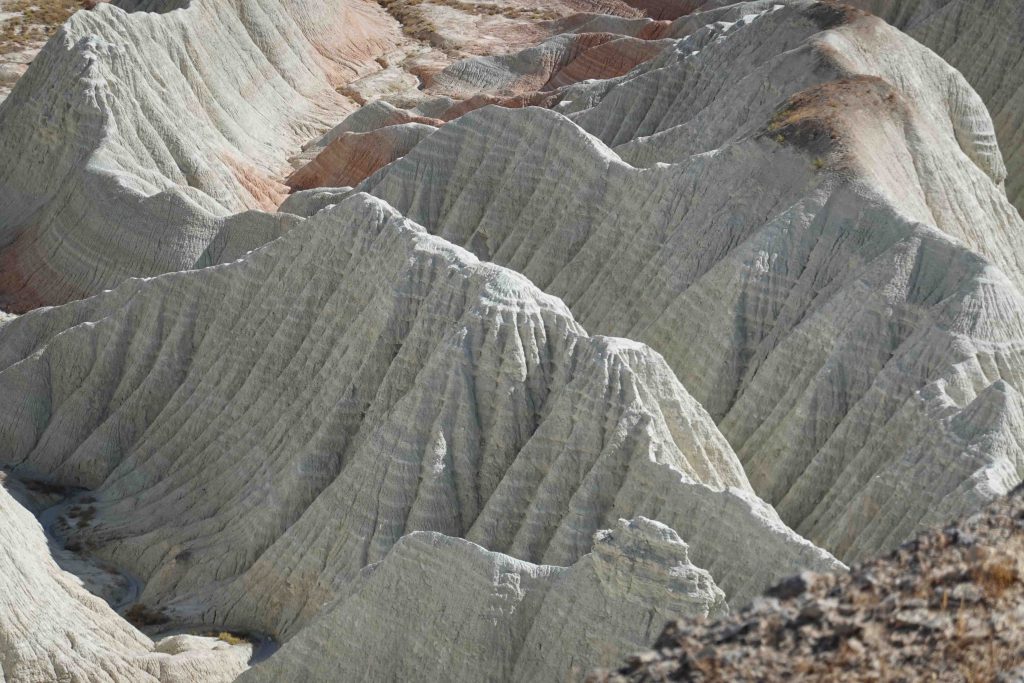
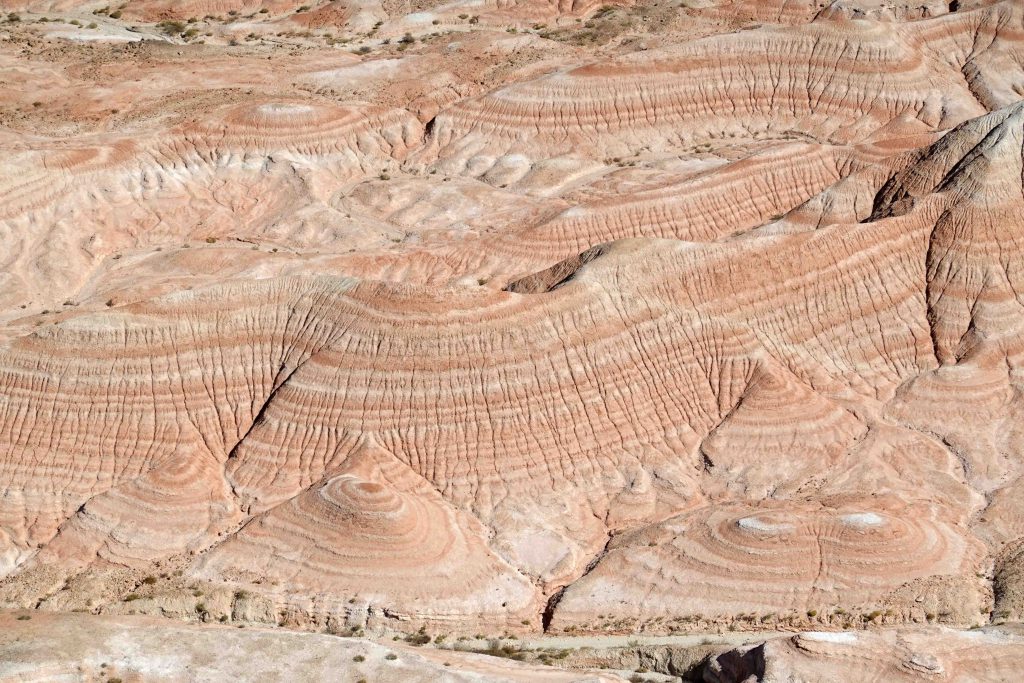
It was sunny, windy, and not as cold as I’d expected and as it can be sometimes, though I was glad for my jacket. Lots of sea shells and shark’s teeth on the ground.
Driving to a different viewpoint gave more dramatic lighting and darker coloring.
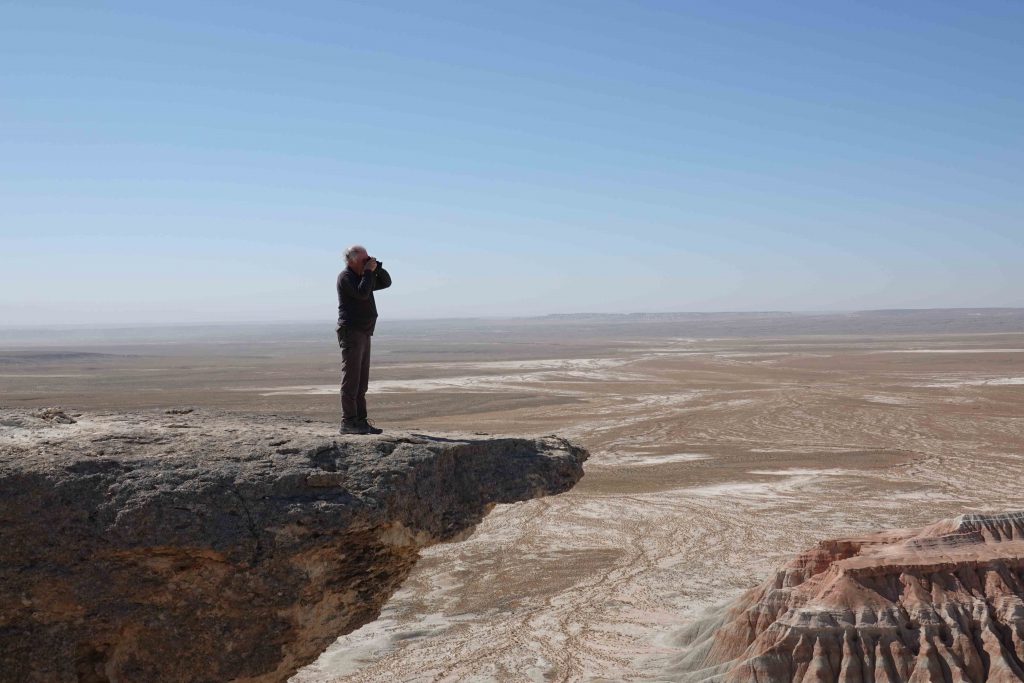
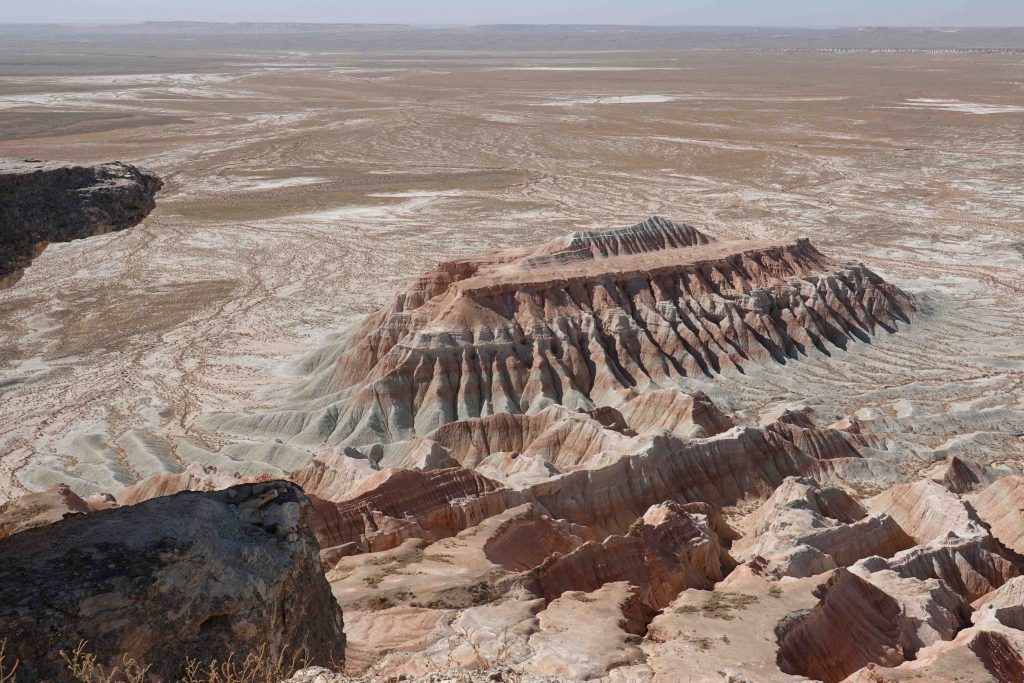
Saw lots of camels while driving.
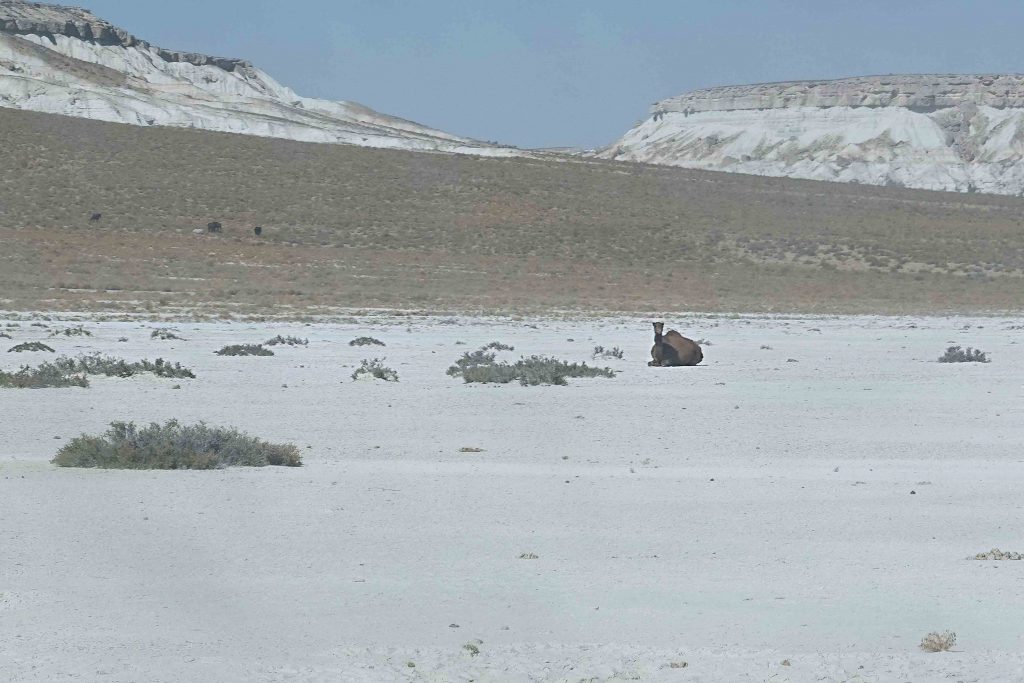
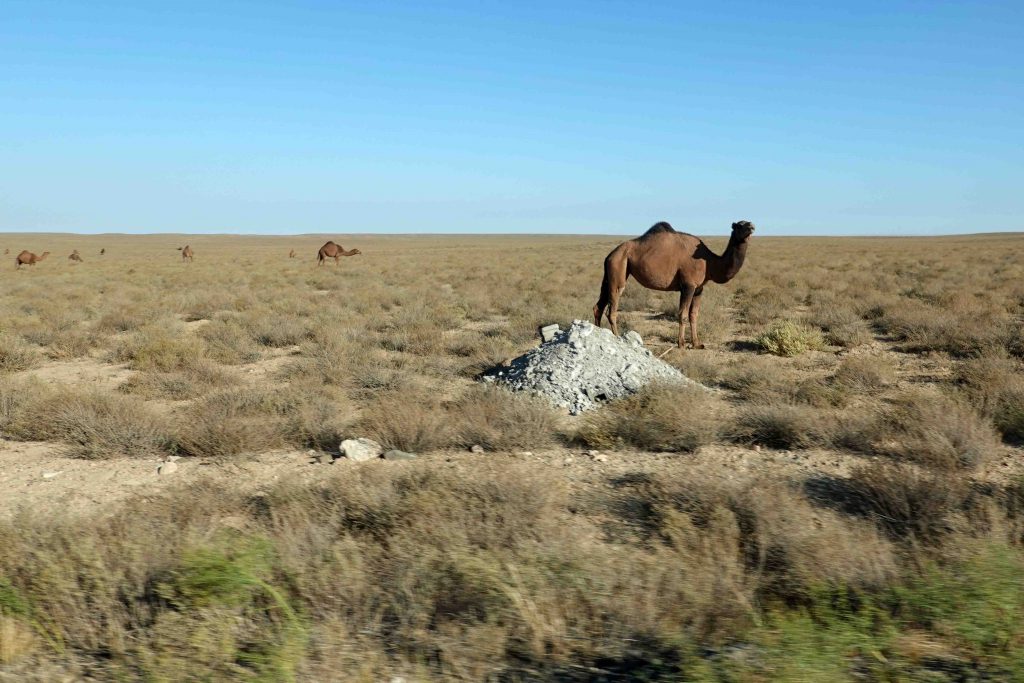
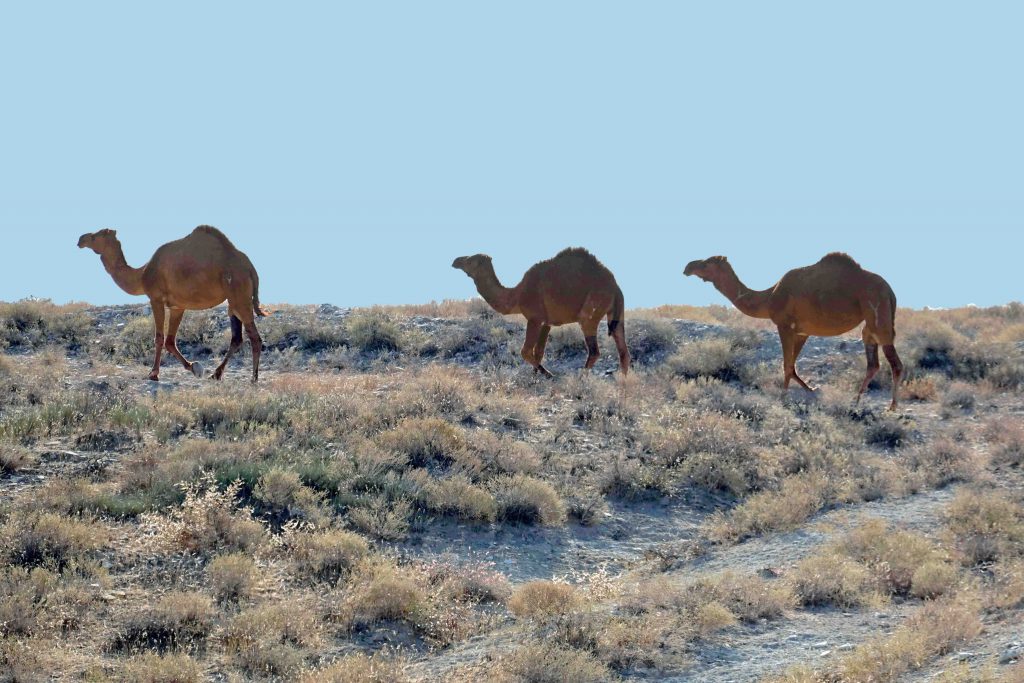
On the drive there, after maybe an hour and a half of driving, we were surprised to pass a bus stop. Our road Tee-d with another at that spot and we reckoned it was a transfer spot for folks wanting to change direction. At the rest/truck stop on the way back, we saw a bus full of people, heading towards Awaza. The toilet at the truck stop was so horrible, Elaine decided she “really didn’t need to go”!
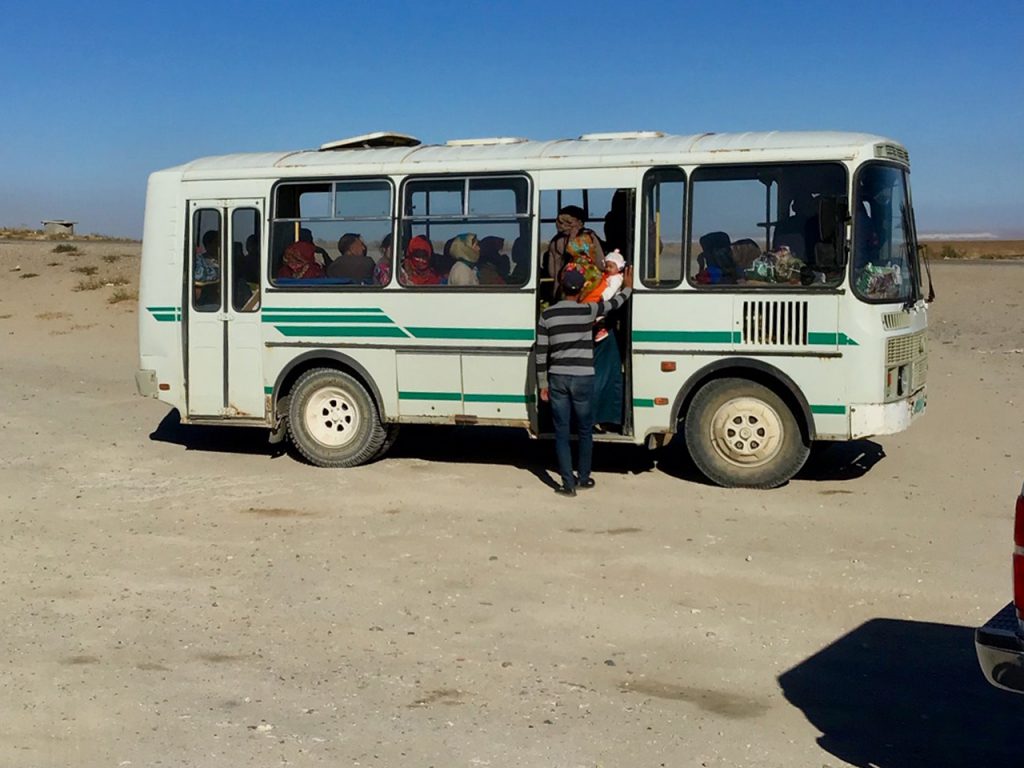
Munched the packed lunch from the hotel, then started the return drive. Sand had blown across the road in a couple of places since our journey out and our driver was a little concerned it would cover the road enough, as it does, we’d have difficulty getting over it.
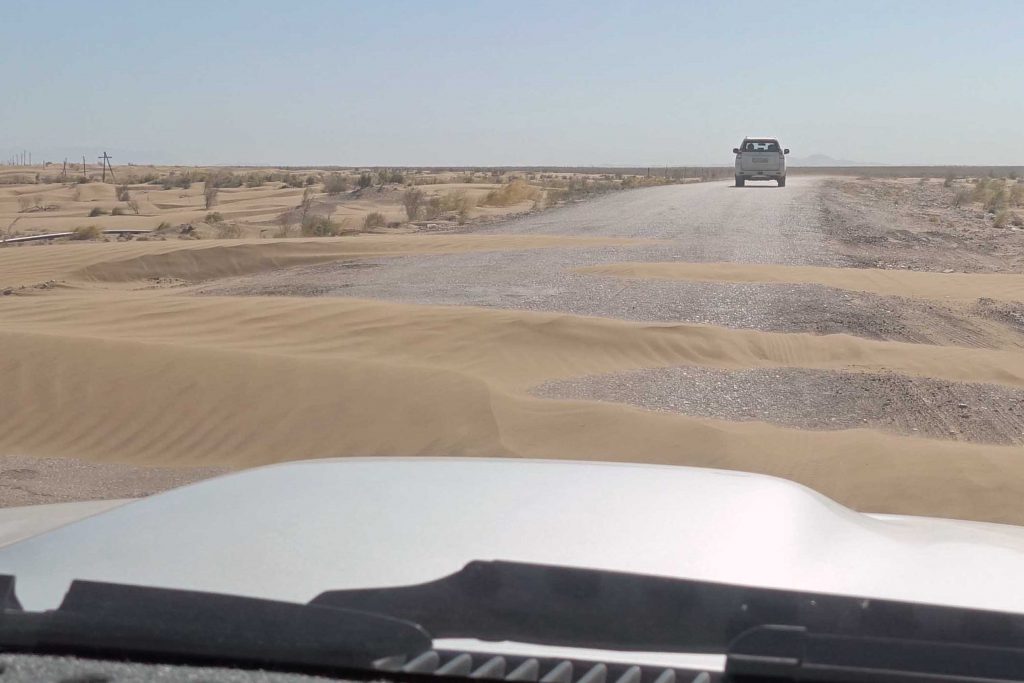
Our hotel is on the Caspian Sea and Trish, Elaine, Leroy and I did the short walk to paddle our feet in it. Leroy got talking to one of the other ET-ers, Jeff, on the pier and they were still at it when we were done paddling and shell gathering, so he never got to wet his toes as they decided to walk with us back to the hotel. The temperature was pleasant for paddling but might have been a bit cold to get all the way in.
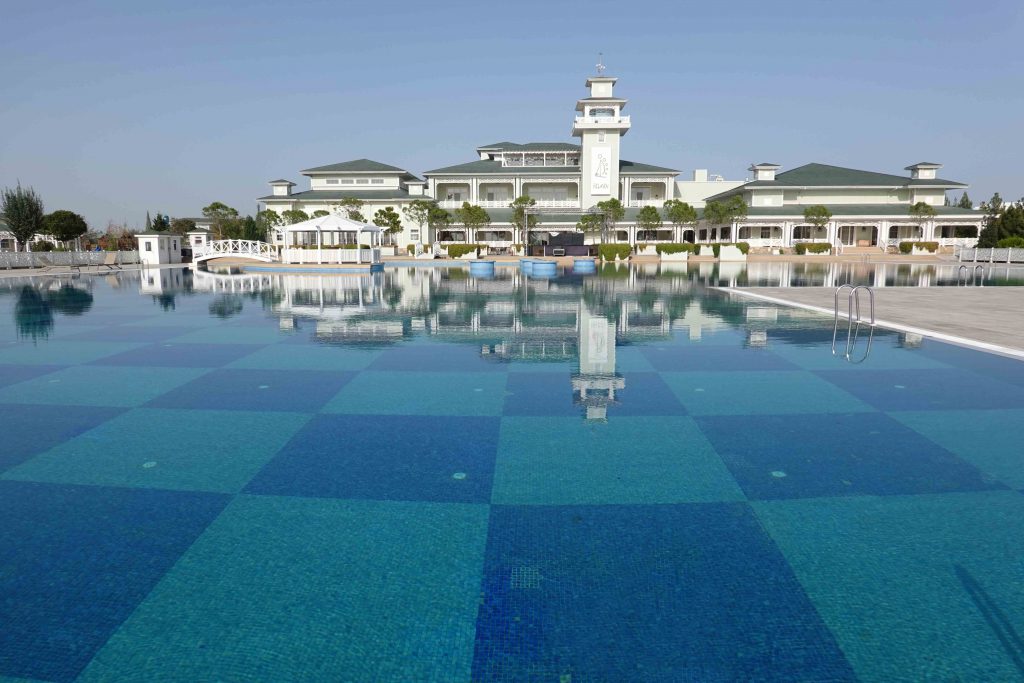
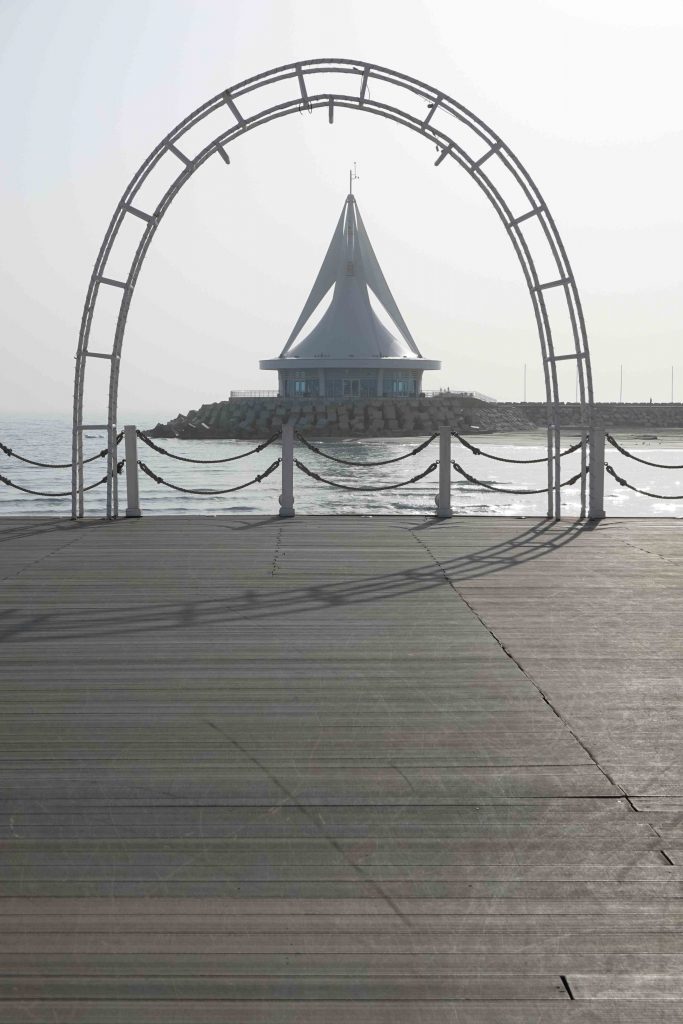
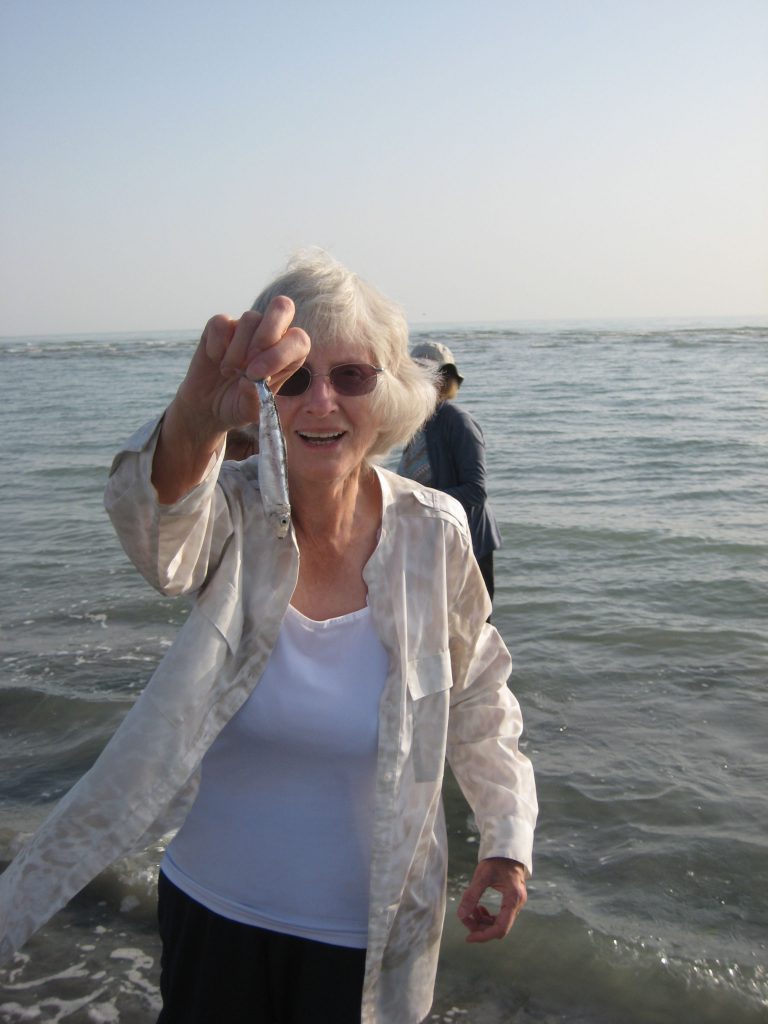
After soup and salad (and fresh bread and butter), the main course tonight was Chicken Schnitzel, tasty–but huge. I didn’t see anyone finish it. I could only manage a third of mine (needed to leave room for dessert)!
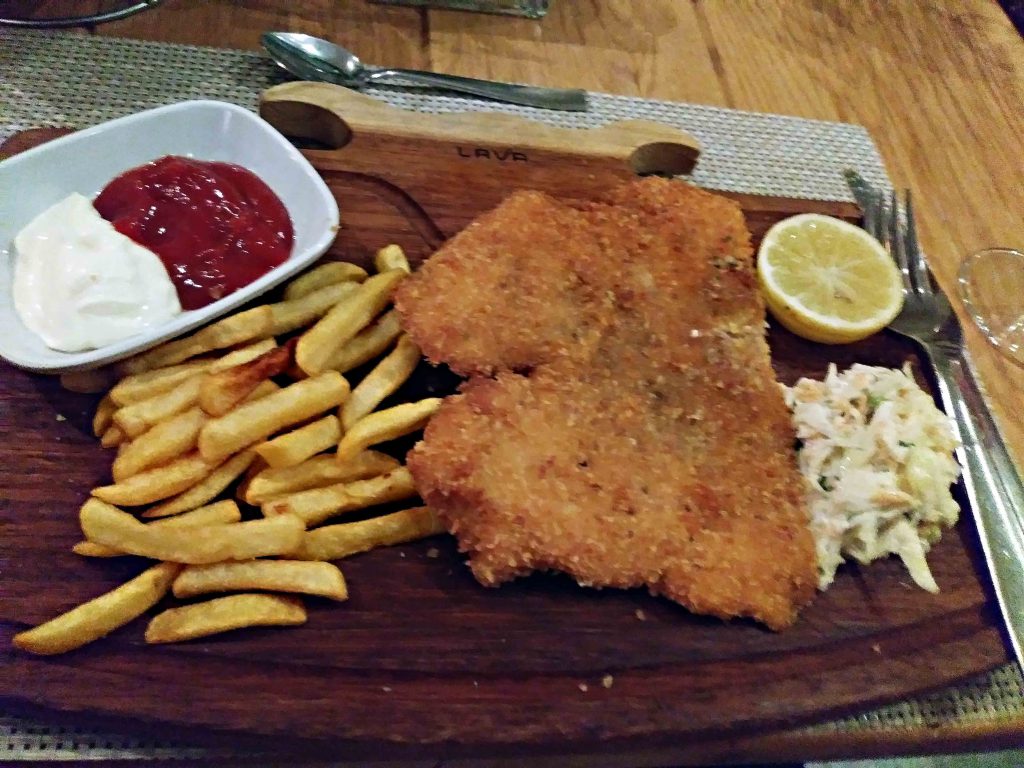
Tomorrow, we have a later start, we don’t leave until 8:45 a.m. for a 10:30 flight back to Ashgabat.
Really enjoyed this resort and the trip to Yangikala.
Ashgabat – Oct 12
ElderTreks brochure: We fly to Ashgabat this morning. Upon arrival visit Weekend bazaar Tolkuchka. In numerous nicely laid out pavillions you can find everything from electronics to camels and from melons to silk scarves. People from all over Turkmenistan come here to sell their local produce. After the bazaar, we visit the Carpet Museum and a private Ahalteke Horse stables to see these famed horses noted for their speed and endurance. Tonight, we have our farewell dinner to the “Stans” of Central Asia adventure. Overnight in Ashgabat. Nusay Hotel.
10:30 a.m. flight to Ashgabat. Once again, found chewing gum in the safety instructions! Pink this time.
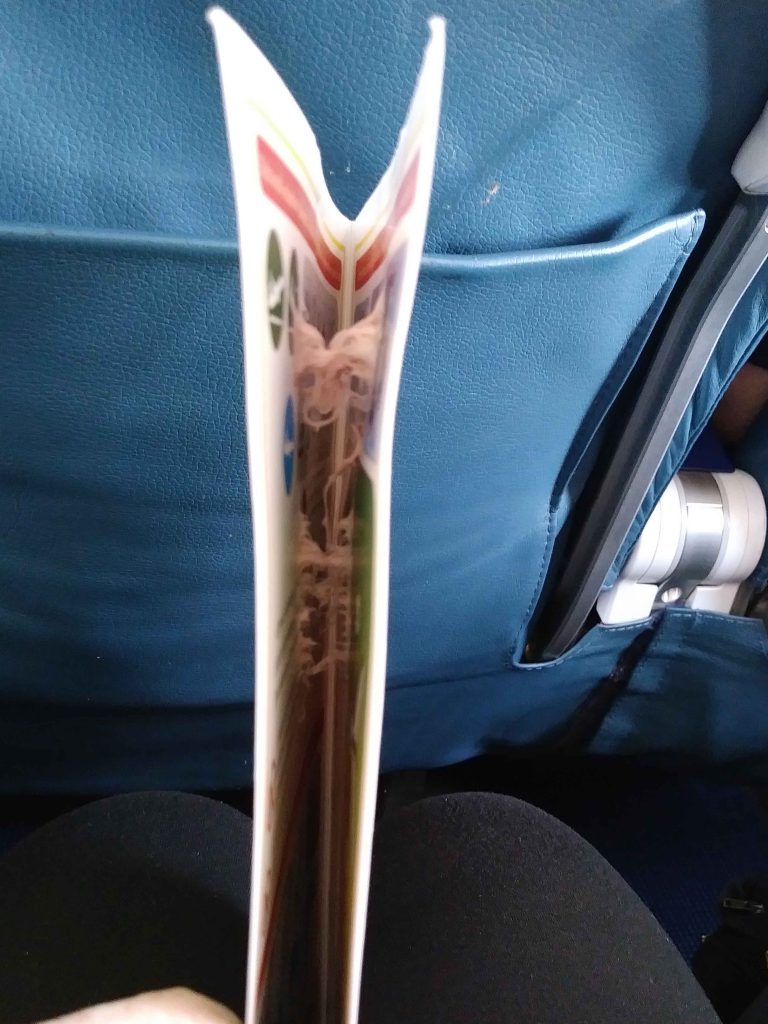
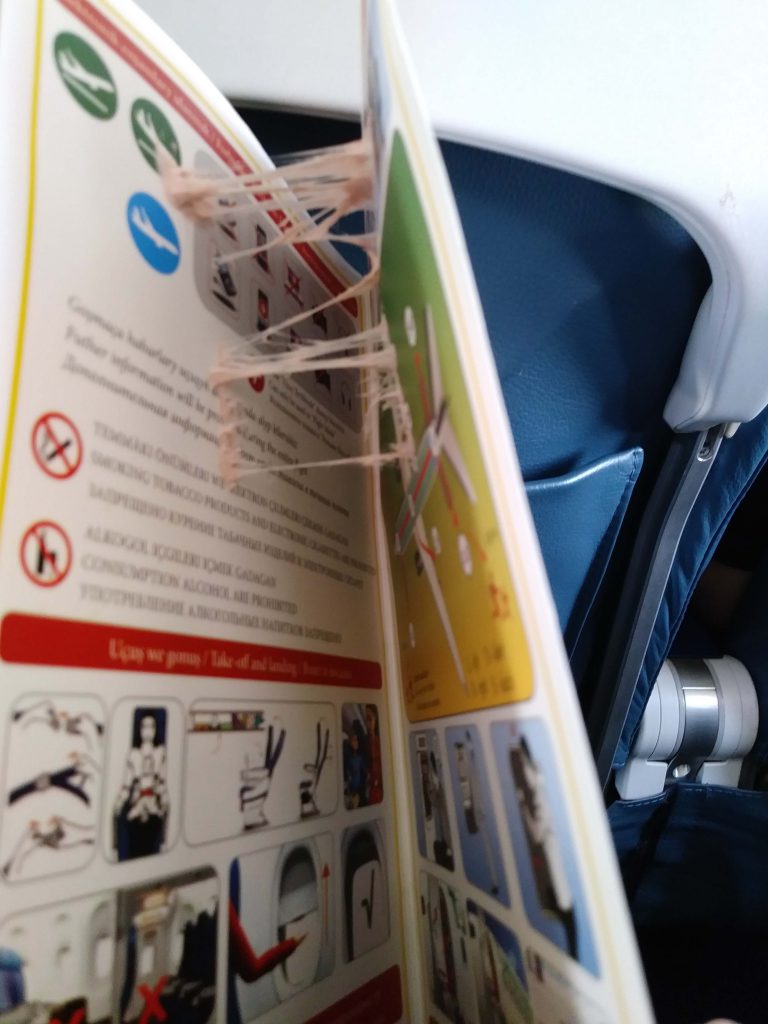
After arriving back in Ashgabat, we visited the Carpet Museum.
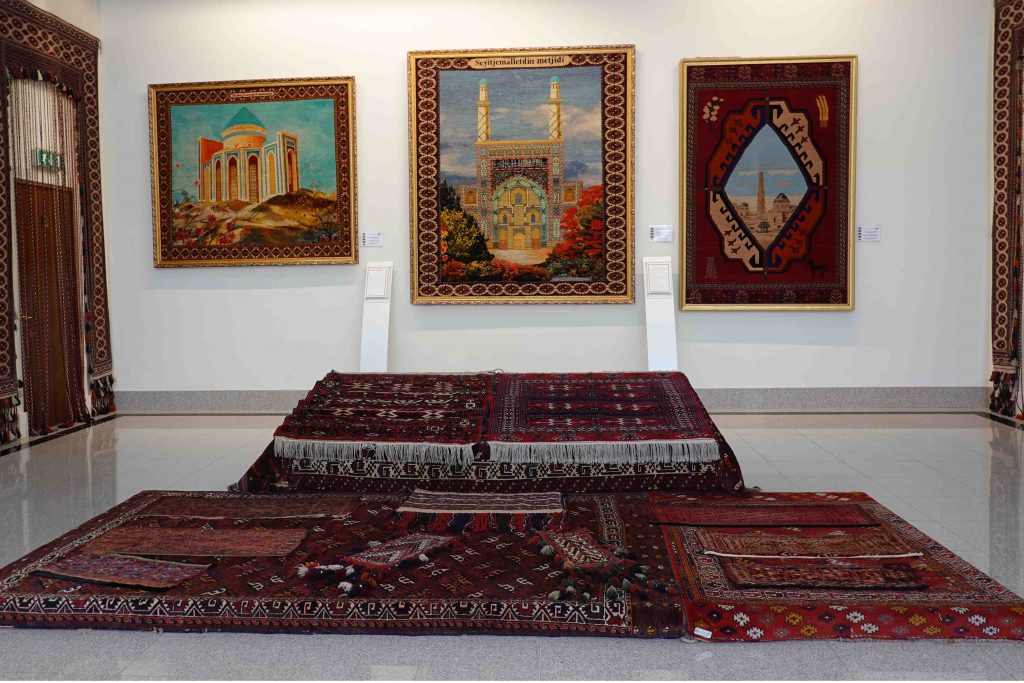
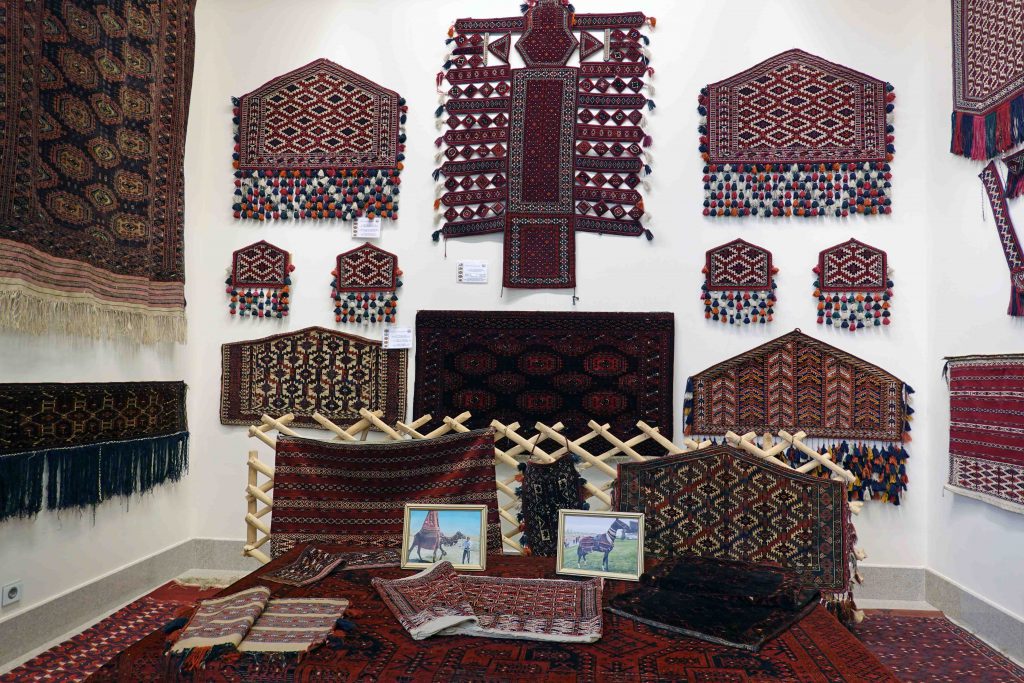
Farewell dinner was fun; Roger asked the group to vote on their favorite Stan and their favorite moment. It was a difficult choice for everyone as there was so much variety, all enjoyable, interesting, fascinating1. Kurgizstan won by a big margin for the favorite Stan.
Elaine’s favorite moment was at the guest house in Chong Kemin Valley, looking out her bedroom window in the mornings as she woke up the first morning seeing the horse and chickens and the second morning, the farmer milking his cow. I didn’t show her photos in the blog Posts for those days–here they are now:
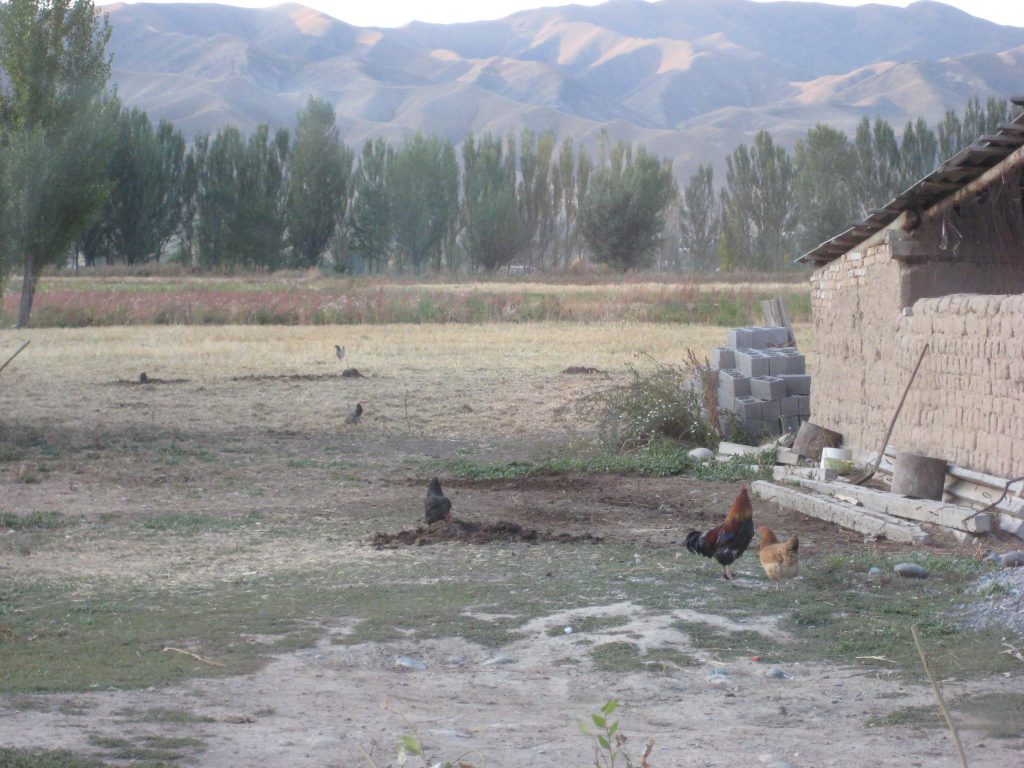
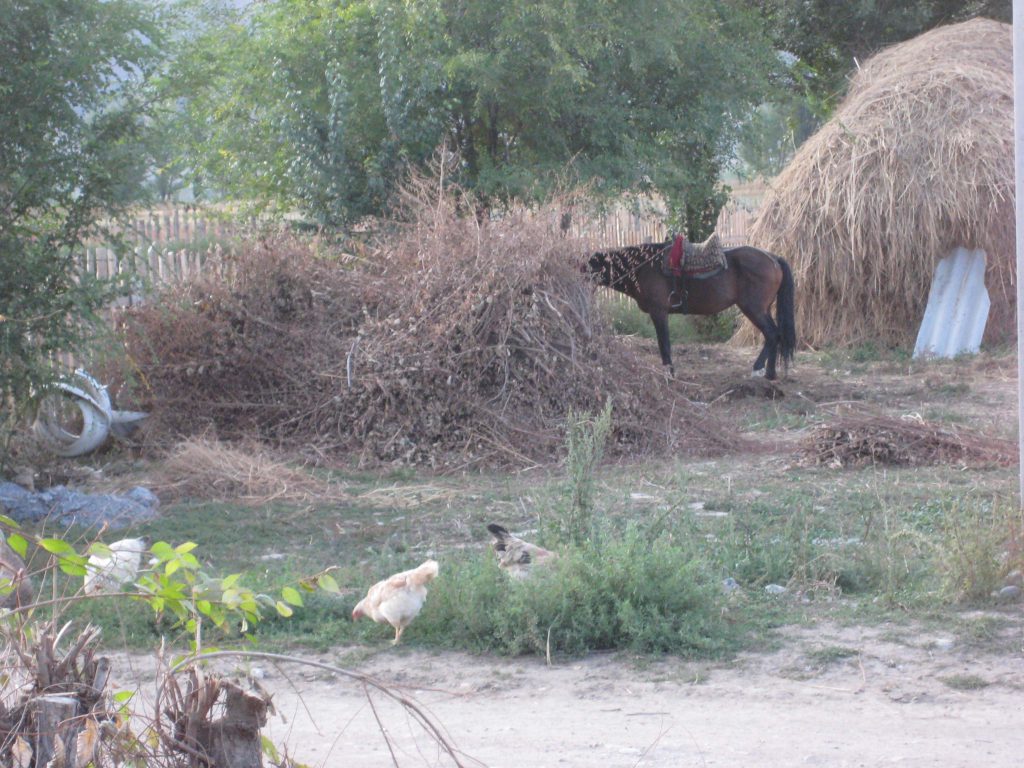
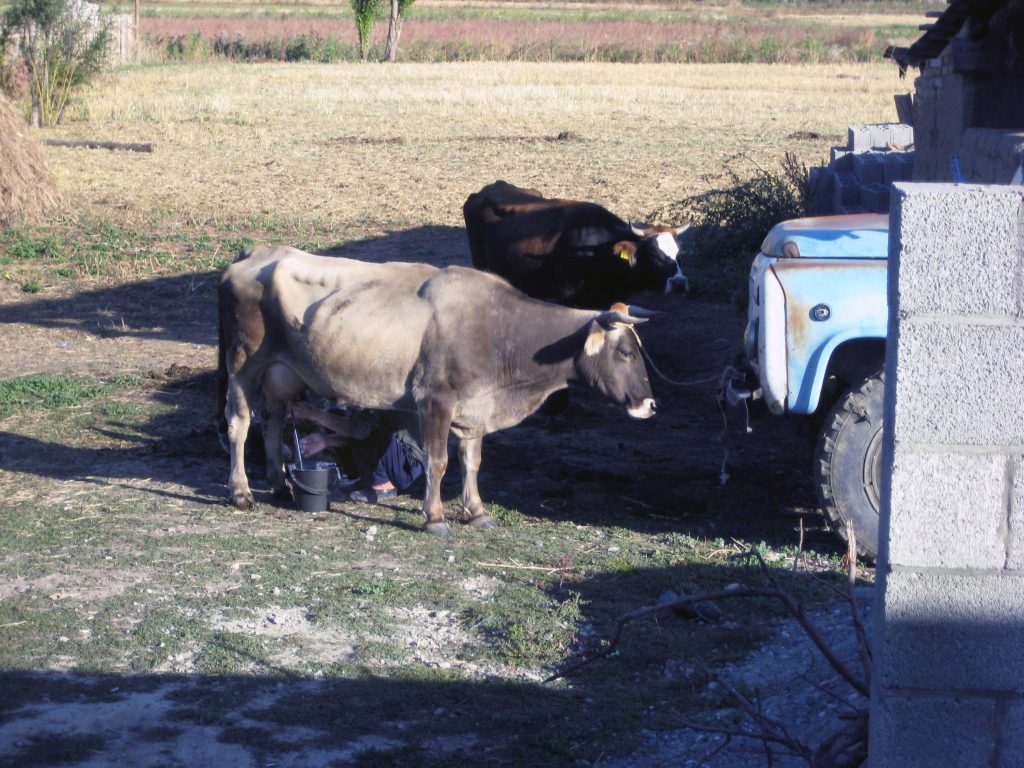
Mine was also in the Chong Kemin Valley, the sheep polo match, the horses and riders becoming as one, the skill and strength and power.
Trish’s favorite moment was the magic of the early morning, before sunrise, at the Darwaza gas crater.
Leroy’s was his encounter with the man from Mary with his brother and brother’s wife, the comradery that happened even without a common language.
The main course looked great but didn’t taste that way, the lamb was close to mutton, and dried out–didn’t take me much willpower to resist that. The dessert (apple pie and vanilla ice cream) and cappuccino were really good, though.
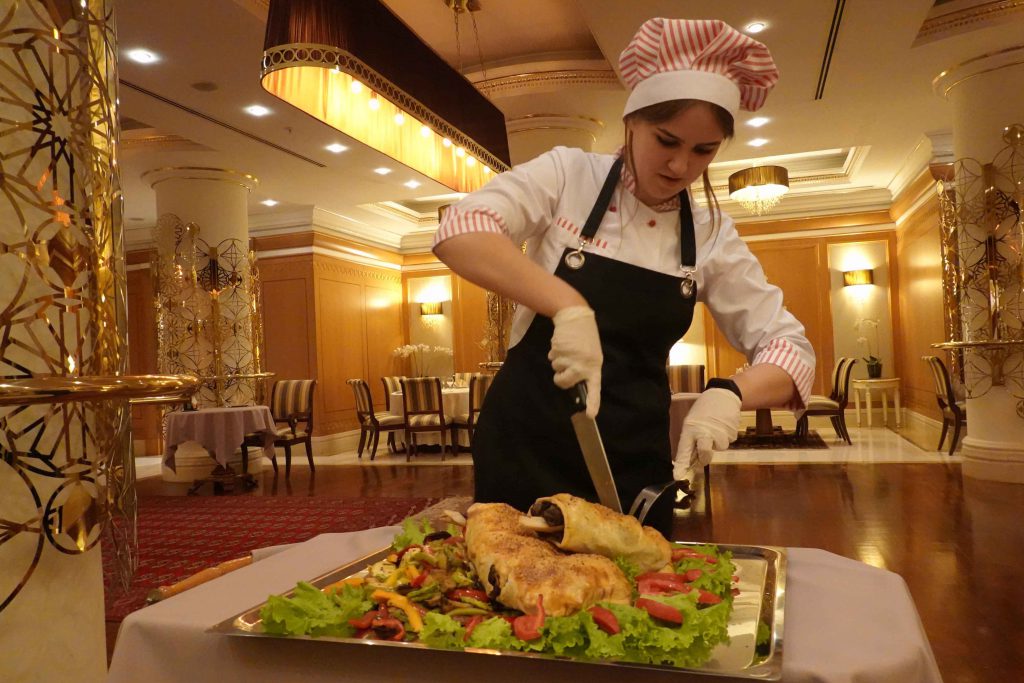
Some of our ElderTrekkers will be leaving for the airport at midnight tonight, while the rest of us leave tomorrow or the following day.
Ashgabat, then Home – Oct. 13 & 14
We have the day on our own before transferring to the airport late evening for our flight home, departing 2:55 a.m., tomorrow, October 14. After changing planes in Frankfurt, we arrive in Denver at 1:25 p.m. on the 14th.
What a nice day we’ve had. I woke up a little before 8 a.m., no alarm. Leroy was already up, showered, and reading an article on the computer. The internet here only allows certain websites plus our email. Interesting what is permitted and what is not–Facebook is a definite “no”. We haven’t been able to download any new books onto the Kindle.
Down to breakfast a little before 9 a.m., then Elaine and Trish arrived within a few minutes of each other. Jeff and Alice also were there, we must all be on the same internal wake-up schedule.
Had the front desk order us a taxi and went to the Berkarar Mall, this is one that locals and ex-pats all use. Among a lot of stores was a huge supermarket, the Kamil Market, on the ground floor, and we spent quite a bit of time wandering around there. Leroy and I picked up some cookies to bring home to the family but couldn’t find anything we wanted to bring home in the way of not-made-in-America savory snacks for them to try.
In one aisle, flatbread filled with chopped onions was being cooked on a griddle–smelled so delicious. We debated about buying some to bring back to the hotel to eat but decided against it. Close by was the bakery department with fabulous looking cakes.
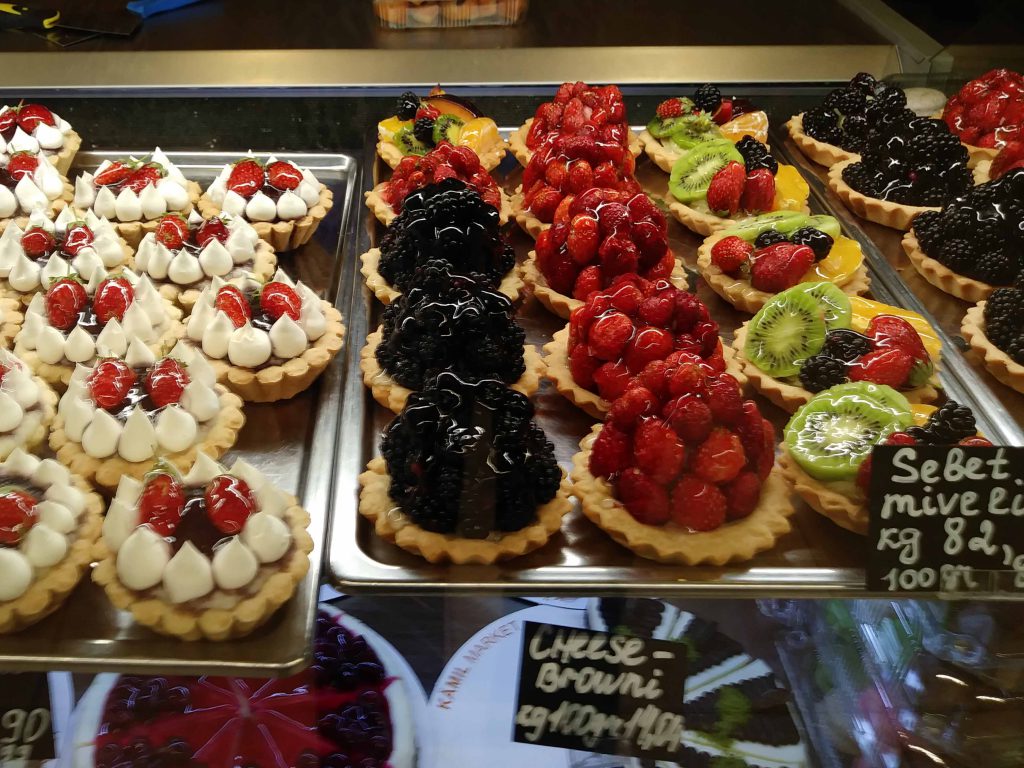
The ladies responsible for all these goodies were happy, friendly folks and wanted to know how old Trish was. She told them “77”, she was the youngest, and the other three were 79 and 80. They were amazed.
Outside, Trish wanted a hotdog from one of the carts so we bought two and shared them. Was most pleasant sitting on a bench in front of a waterfall wall, people watching. Also bought cappuccinos from a coffee truck, really good ones. Then a taxi back to our hotel, too far to walk and a lot of it along dual-carriageways.
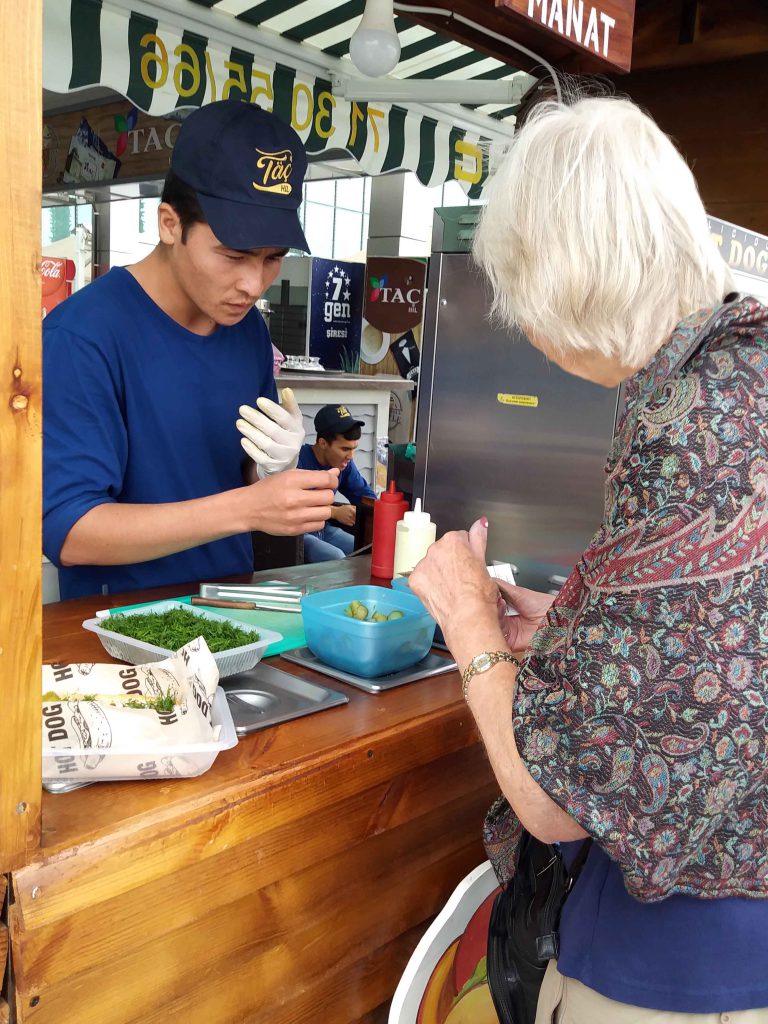
Early dinner was a superb chicken curry which Leroy and I shared, and a tender Margherita pizza for Elaine and Trish.
I took this photo of the international airport terminal the other day, it’s in the shape of a falcon. The domestic terminal from which we’ve flown to the last few days is a smaller version of this.
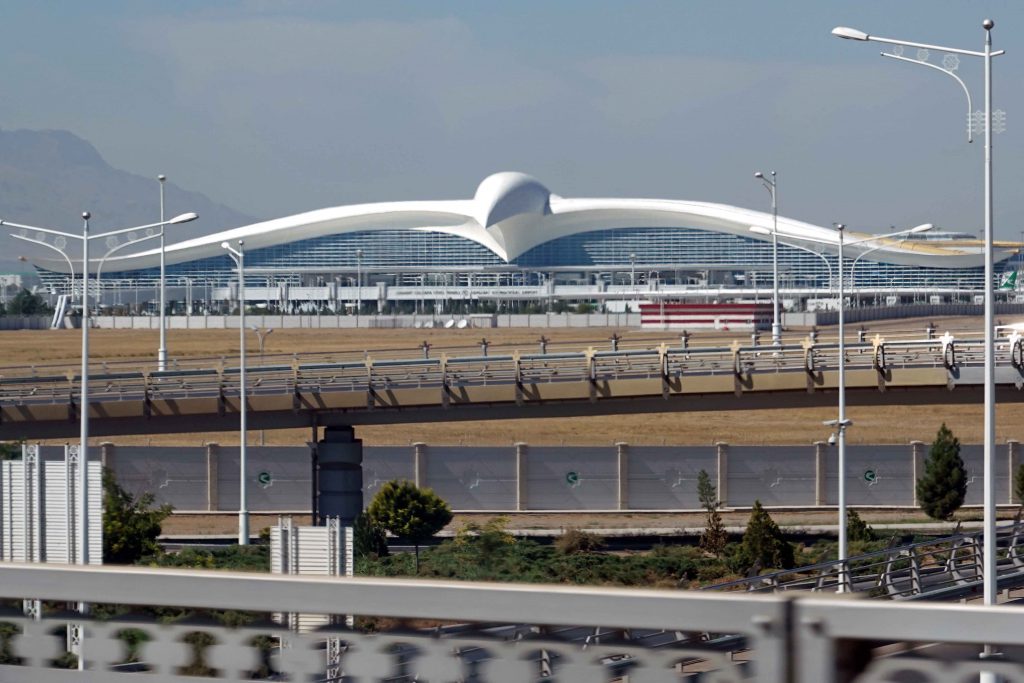
We left the hotel at midnight for the journey home. It was uneventful–the best kind.
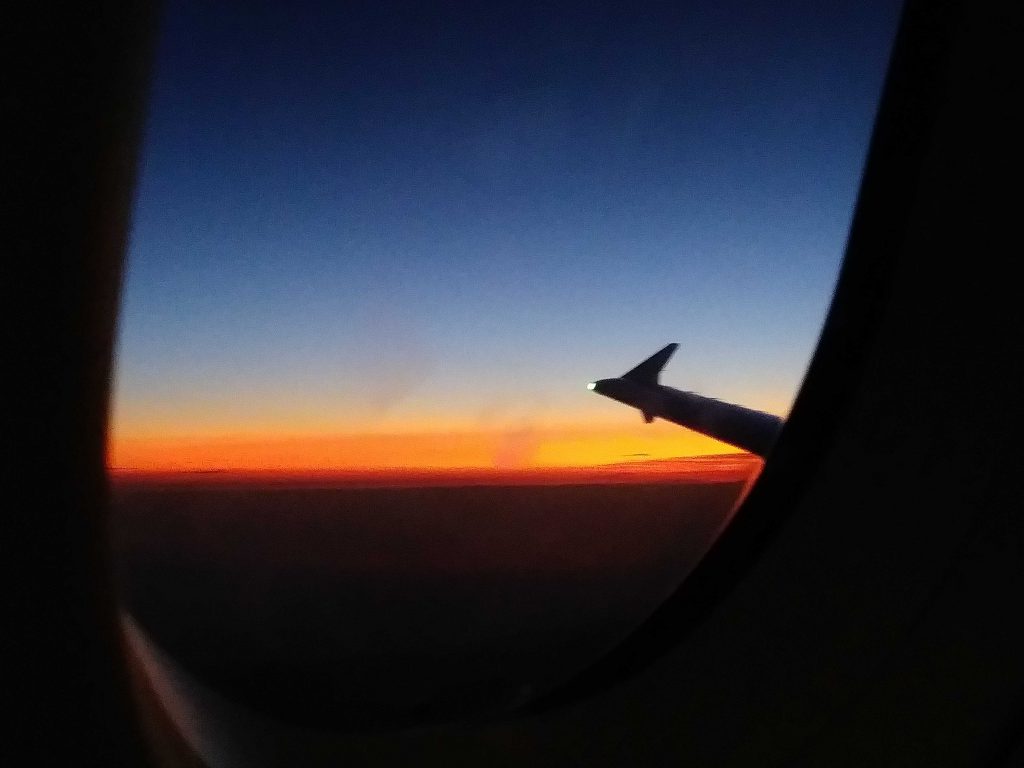
Next page: Notes after returning home
Previous page: Uzbekistan
All pages: In Transit : Kazakhstan : Kyrgyzstan : Tajikistan : Uzbekistan : Turkmenistan : Notes after returning home : Q&A, Comments
